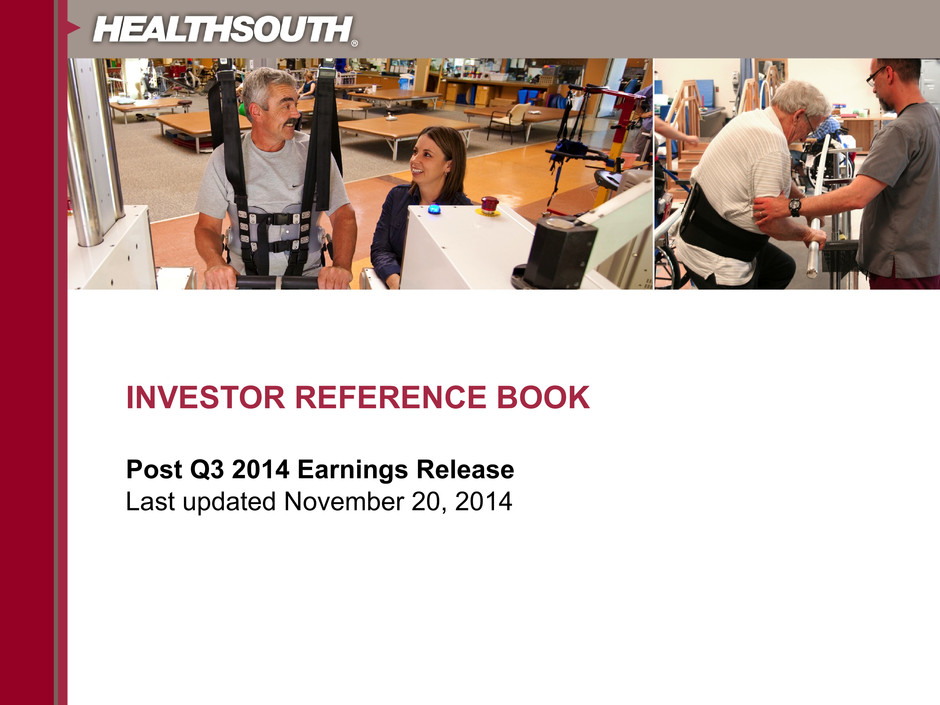
Post Q3 2014 Earnings Release INVESTOR REFERENCE BOOK Last updated November 20, 2014
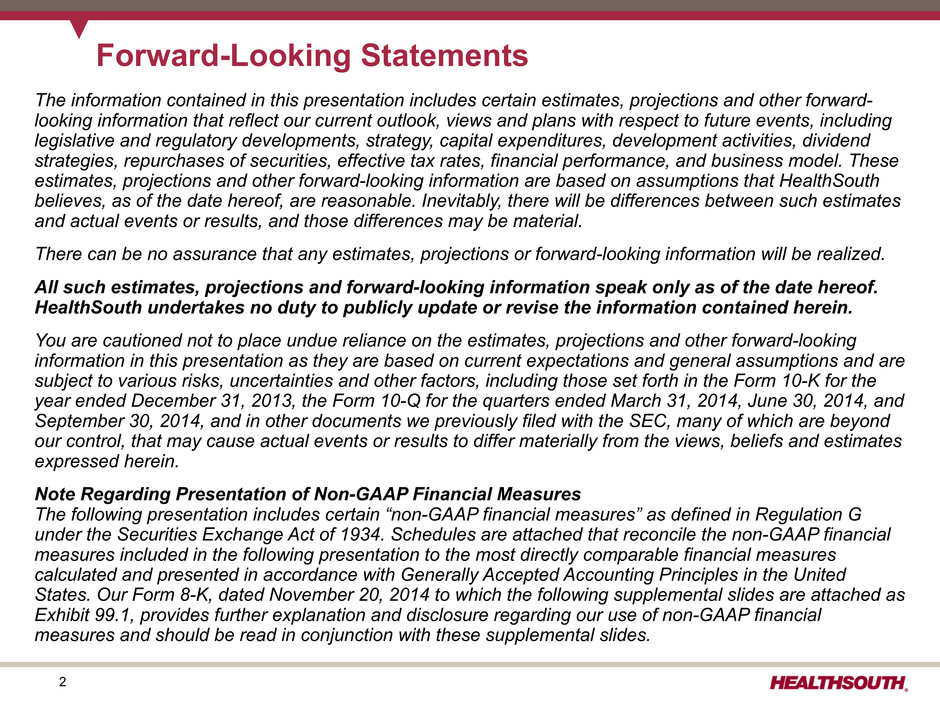
2 The information contained in this presentation includes certain estimates, projections and other forward- looking information that reflect our current outlook, views and plans with respect to future events, including legislative and regulatory developments, strategy, capital expenditures, development activities, dividend strategies, repurchases of securities, effective tax rates, financial performance, and business model. These estimates, projections and other forward-looking information are based on assumptions that HealthSouth believes, as of the date hereof, are reasonable. Inevitably, there will be differences between such estimates and actual events or results, and those differences may be material. There can be no assurance that any estimates, projections or forward-looking information will be realized. All such estimates, projections and forward-looking information speak only as of the date hereof. HealthSouth undertakes no duty to publicly update or revise the information contained herein. You are cautioned not to place undue reliance on the estimates, projections and other forward-looking information in this presentation as they are based on current expectations and general assumptions and are subject to various risks, uncertainties and other factors, including those set forth in the Form 10-K for the year ended December 31, 2013, the Form 10-Q for the quarters ended March 31, 2014, June 30, 2014, and September 30, 2014, and in other documents we previously filed with the SEC, many of which are beyond our control, that may cause actual events or results to differ materially from the views, beliefs and estimates expressed herein. Note Regarding Presentation of Non-GAAP Financial Measures The following presentation includes certain “non-GAAP financial measures” as defined in Regulation G under the Securities Exchange Act of 1934. Schedules are attached that reconcile the non-GAAP financial measures included in the following presentation to the most directly comparable financial measures calculated and presented in accordance with Generally Accepted Accounting Principles in the United States. Our Form 8-K, dated November 20, 2014 to which the following supplemental slides are attached as Exhibit 99.1, provides further explanation and disclosure regarding our use of non-GAAP financial measures and should be read in conjunction with these supplemental slides. Forward-Looking Statements
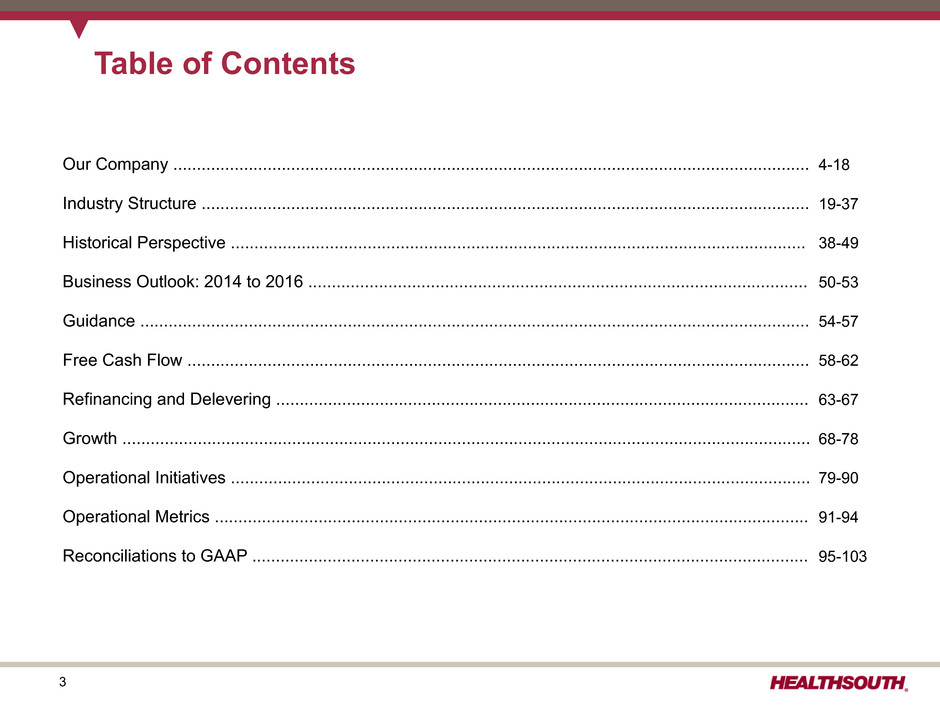
3 Table of Contents Our Company ....................................................................................................................................... 4-18 Industry Structure ................................................................................................................................. 19-37 Historical Perspective .......................................................................................................................... 38-49 Business Outlook: 2014 to 2016 .......................................................................................................... 50-53 Guidance .............................................................................................................................................. 54-57 Free Cash Flow .................................................................................................................................... 58-62 Refinancing and Delevering ................................................................................................................. 63-67 Growth .................................................................................................................................................. 68-78 Operational Initiatives ........................................................................................................................... 79-90 Operational Metrics .............................................................................................................................. 91-94 Reconciliations to GAAP ...................................................................................................................... 95-103
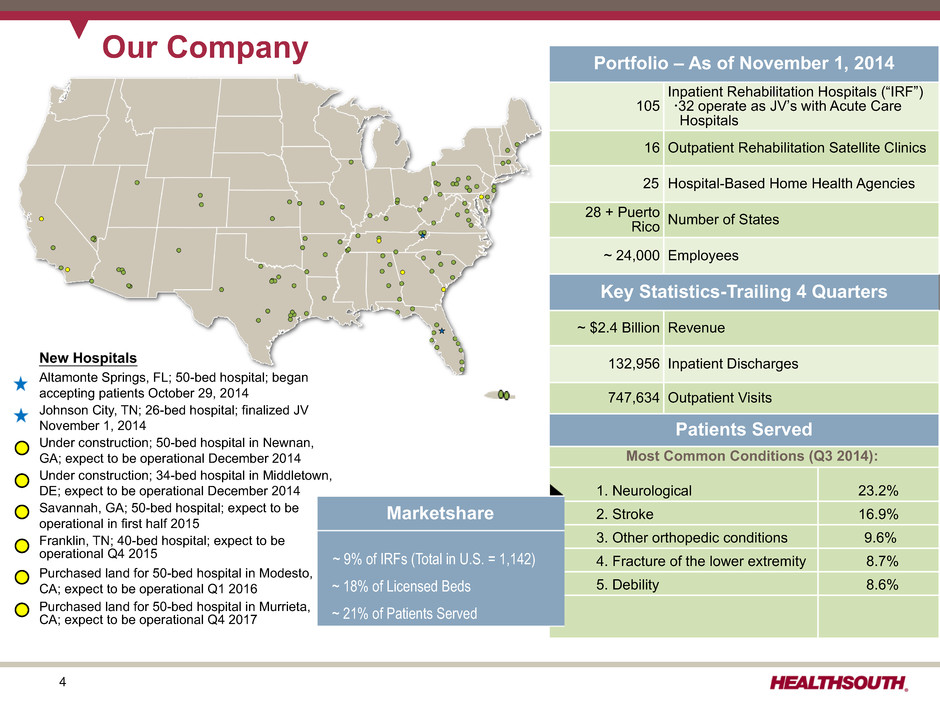
4 1. Neurological 23.2% 2. Stroke 16.9% 3. Other orthopedic conditions 9.6% 4. Fracture of the lower extremity 8.7% 5. Debility 8.6% Portfolio – As of November 1, 2014 105 Inpatient Rehabilitation Hospitals (“IRF”) ž32 operate as JV’s with Acute Care Hospitals 16 Outpatient Rehabilitation Satellite Clinics 25 Hospital-Based Home Health Agencies 28 + Puerto Rico Number of States ~ 24,000 Employees Key Statistics-Trailing 4 Quarters ~ $2.4 Billion Revenue 132,956 Inpatient Discharges 747,634 Outpatient Visits Patients Served Most Common Conditions (Q3 2014): New Hospitals Altamonte Springs, FL; 50-bed hospital; began accepting patients October 29, 2014 Johnson City, TN; 26-bed hospital; finalized JV November 1, 2014 Under construction; 50-bed hospital in Newnan, GA; expect to be operational December 2014 Under construction; 34-bed hospital in Middletown, DE; expect to be operational December 2014 Savannah, GA; 50-bed hospital; expect to be operational in first half 2015 Franklin, TN; 40-bed hospital; expect to be operational Q4 2015 Purchased land for 50-bed hospital in Modesto, CA; expect to be operational Q1 2016 Purchased land for 50-bed hospital in Murrieta, CA; expect to be operational Q4 2017 Our Company Marketshare ~ 9% of IRFs (Total in U.S. = 1,142) ~ 18% of Licensed Beds ~ 21% of Patients Served

5 Our Hospitals Major Services • Rehabilitation Physicians: manage and treat medical needs of patients • Rehabilitation Nurses: oversee treatment programs of patients • Physical Therapists: address physical function, mobility, safety • Occupational Therapists: promote independence and re-integration • Speech-Language Therapists: treat communication and swallowing disorders • Case Managers: coordinate care plan with physician, caregivers and family • Post-discharge services: outpatient therapy and home health 96 of our hospitals hold one or more disease-specific certifications from The Joint Commission’s Disease- Specific Care Certification Program.(1) (1) Under this program, Joint Commission accredited organizations, like our hospitals, may seek certification for chronic diseases or conditions such as brain injury or stroke rehabilitation by complying with Joint Commission standards, effectively using evidence-based clinical practice guidelines to manage and optimize patient care, and using an organized approach to performance measurement and evaluation of clinical outcomes. Obtaining such certifications demonstrates our commitment to excellence in providing disease-specific care.
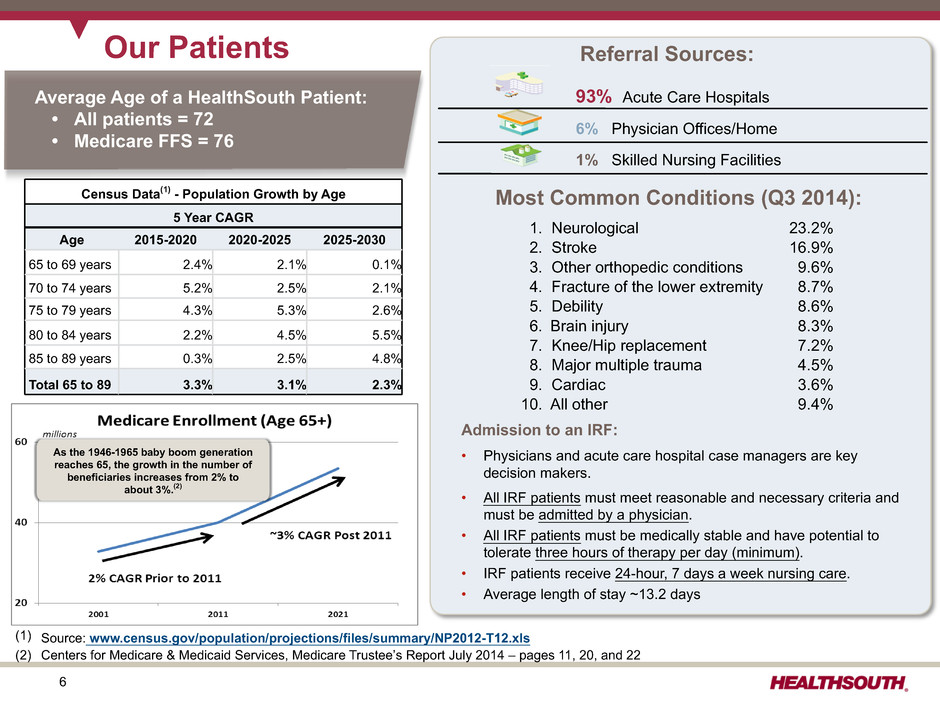
6 Our Patients Referral Sources: 93% Acute Care Hospitals 6% Physician Offices/Home 1% Skilled Nursing Facilities Census Data(1) - Population Growth by Age 5 Year CAGR Age 2015-2020 2020-2025 2025-2030 65 to 69 years 2.4% 2.1% 0.1% 70 to 74 years 5.2% 2.5% 2.1% 75 to 79 years 4.3% 5.3% 2.6% 80 to 84 years 2.2% 4.5% 5.5% 85 to 89 years 0.3% 2.5% 4.8% Total 65 to 89 3.3% 3.1% 2.3% Average Age of a HealthSouth Patient: • All patients = 72 • Medicare FFS = 76 (1) Source: www.census.gov/population/projections/files/summary/NP2012-T12.xls (2) Centers for Medicare & Medicaid Services, Medicare Trustee’s Report July 2014 – pages 11, 20, and 22 Most Common Conditions (Q3 2014): 1. Neurological 23.2% 2. Stroke 16.9% 3. Other orthopedic conditions 9.6% 4. Fracture of the lower extremity 8.7% 5. Debility 8.6% 6. Brain injury 8.3% 7. Knee/Hip replacement 7.2% 8. Major multiple trauma 4.5% 9. Cardiac 3.6% 10. All other 9.4% Admission to an IRF: • Physicians and acute care hospital case managers are key decision makers. • All IRF patients must meet reasonable and necessary criteria and must be admitted by a physician. • All IRF patients must be medically stable and have potential to tolerate three hours of therapy per day (minimum). • IRF patients receive 24-hour, 7 days a week nursing care. • Average length of stay ~13.2 days As the 1946-1965 baby boom generation reaches 65, the growth in the number of beneficiaries increases from 2% to about 3%.(2)
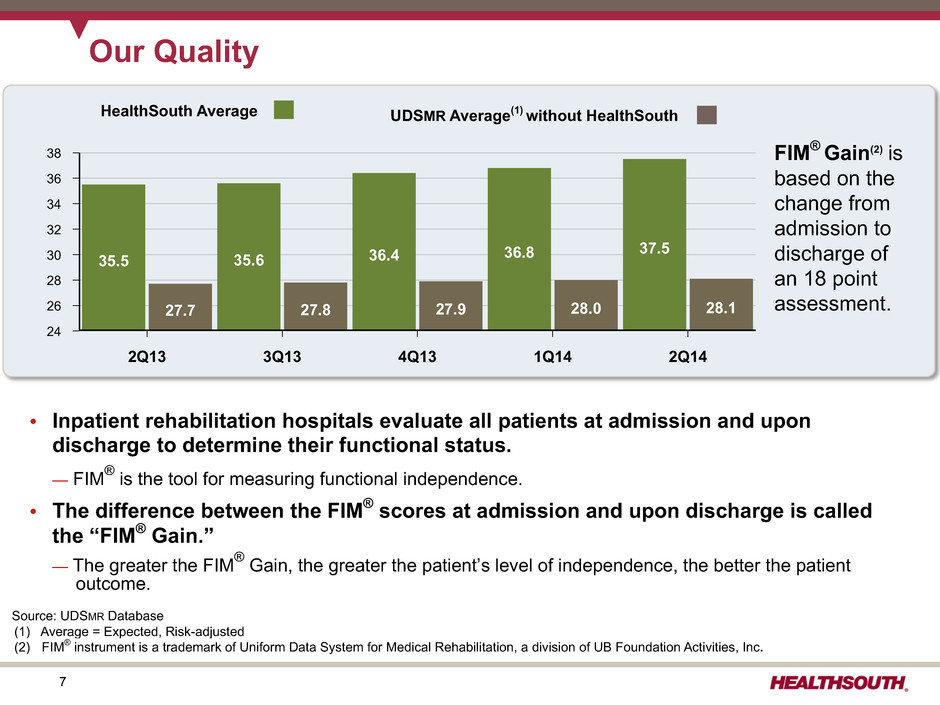
7 Our Quality • Inpatient rehabilitation hospitals evaluate all patients at admission and upon discharge to determine their functional status. — FIM® is the tool for measuring functional independence. • The difference between the FIM® scores at admission and upon discharge is called the “FIM® Gain.” — The greater the FIM® Gain, the greater the patient’s level of independence, the better the patient outcome. FIM® Gain(2) is based on the change from admission to discharge of an 18 point assessment. HealthSouth Average UDSMR Average(1) without HealthSouth 38 36 34 32 30 28 26 24 2Q13 3Q13 4Q13 1Q14 2Q14 35.5 35.6 36.4 36.8 37.5 27.7 27.8 27.9 28.0 28.1 Source: UDSMR Database (1) Average = Expected, Risk-adjusted (2) FIM® instrument is a trademark of Uniform Data System for Medical Rehabilitation, a division of UB Foundation Activities, Inc.
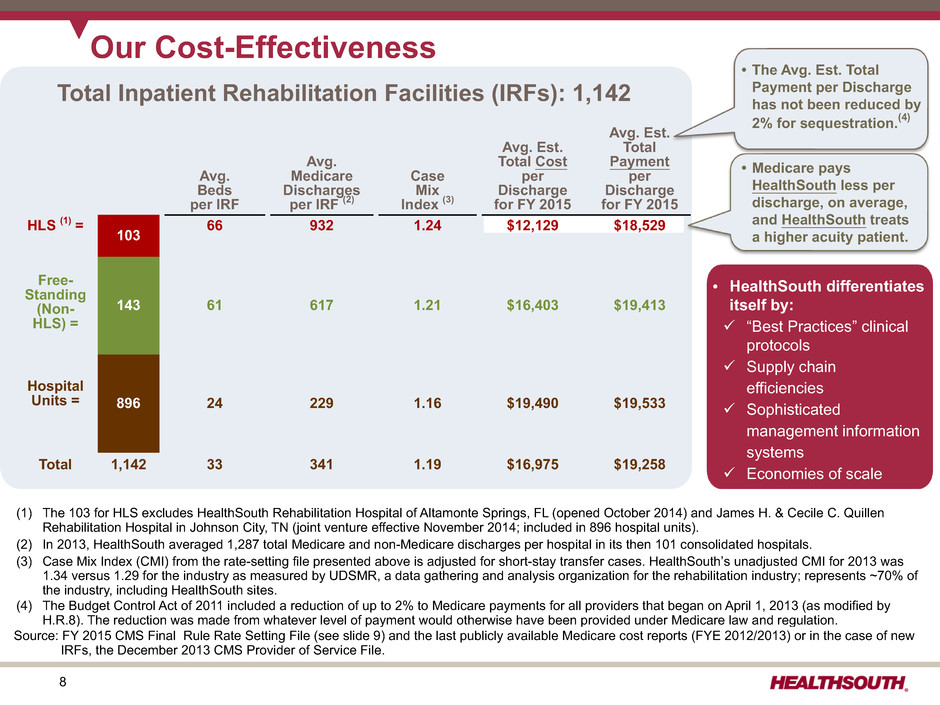
8 Total Inpatient Rehabilitation Facilities (IRFs): 1,142 Our Cost-Effectiveness • The Avg. Est. Total Payment per Discharge has not been reduced by 2% for sequestration.(4) • Medicare pays HealthSouth less per discharge, on average, and HealthSouth treats a higher acuity patient. Avg. Beds per IRF Avg. Medicare Discharges per IRF (2) Case Mix Index (3) Avg. Est. Total Cost per Discharge for FY 2015 Avg. Est. Total Payment per Discharge for FY 2015 HLS (1) = 103 66 932 1.24 $12,129 $18,529 Free- Standing (Non- HLS) = 143 61 617 1.21 $16,403 $19,413 896 24 229 1.16 $19,490 $19,533 Hospital Units = Total 1,142 33 341 1.19 $16,975 $19,258 (1) The 103 for HLS excludes HealthSouth Rehabilitation Hospital of Altamonte Springs, FL (opened October 2014) and James H. & Cecile C. Quillen Rehabilitation Hospital in Johnson City, TN (joint venture effective November 2014; included in 896 hospital units). (2) In 2013, HealthSouth averaged 1,287 total Medicare and non-Medicare discharges per hospital in its then 101 consolidated hospitals. (3) Case Mix Index (CMI) from the rate-setting file presented above is adjusted for short-stay transfer cases. HealthSouth’s unadjusted CMI for 2013 was 1.34 versus 1.29 for the industry as measured by UDSMR, a data gathering and analysis organization for the rehabilitation industry; represents ~70% of the industry, including HealthSouth sites. (4) The Budget Control Act of 2011 included a reduction of up to 2% to Medicare payments for all providers that began on April 1, 2013 (as modified by H.R.8). The reduction was made from whatever level of payment would otherwise have been provided under Medicare law and regulation. Source: FY 2015 CMS Final Rule Rate Setting File (see slide 9) and the last publicly available Medicare cost reports (FYE 2012/2013) or in the case of new IRFs, the December 2013 CMS Provider of Service File. • HealthSouth differentiates itself by: ü “Best Practices” clinical protocols ü Supply chain efficiencies ü Sophisticated management information systems ü Economies of scale
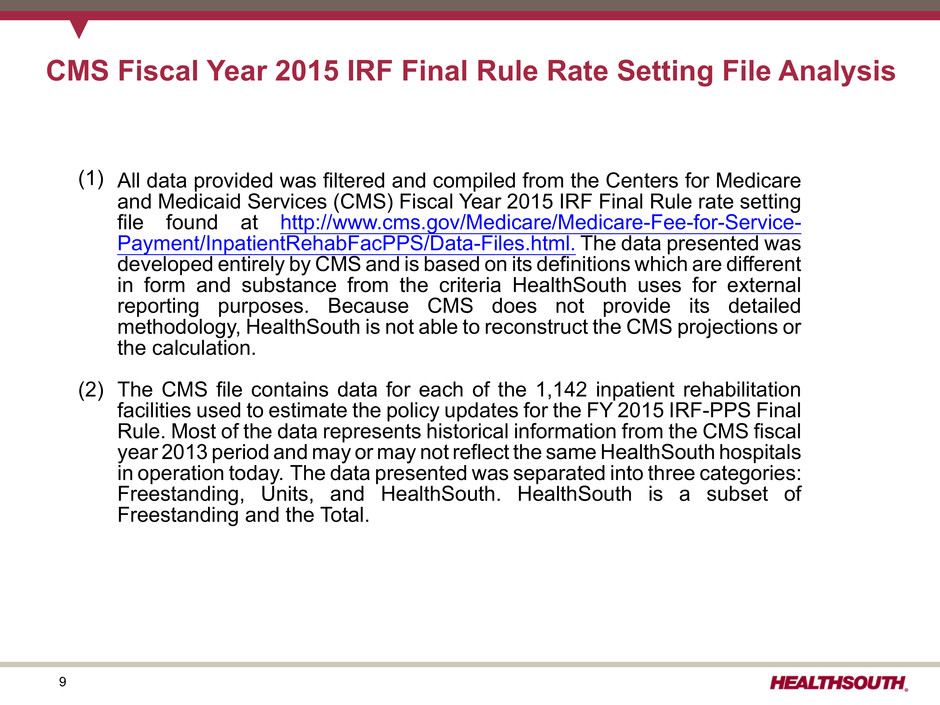
9 CMS Fiscal Year 2015 IRF Final Rule Rate Setting File Analysis (1) All data provided was filtered and compiled from the Centers for Medicare and Medicaid Services (CMS) Fiscal Year 2015 IRF Final Rule rate setting file found at http://www.cms.gov/Medicare/Medicare-Fee-for-Service- Payment/InpatientRehabFacPPS/Data-Files.html. The data presented was developed entirely by CMS and is based on its definitions which are different in form and substance from the criteria HealthSouth uses for external reporting purposes. Because CMS does not provide its detailed methodology, HealthSouth is not able to reconstruct the CMS projections or the calculation. (2) The CMS file contains data for each of the 1,142 inpatient rehabilitation facilities used to estimate the policy updates for the FY 2015 IRF-PPS Final Rule. Most of the data represents historical information from the CMS fiscal year 2013 period and may or may not reflect the same HealthSouth hospitals in operation today. The data presented was separated into three categories: Freestanding, Units, and HealthSouth. HealthSouth is a subset of Freestanding and the Total.
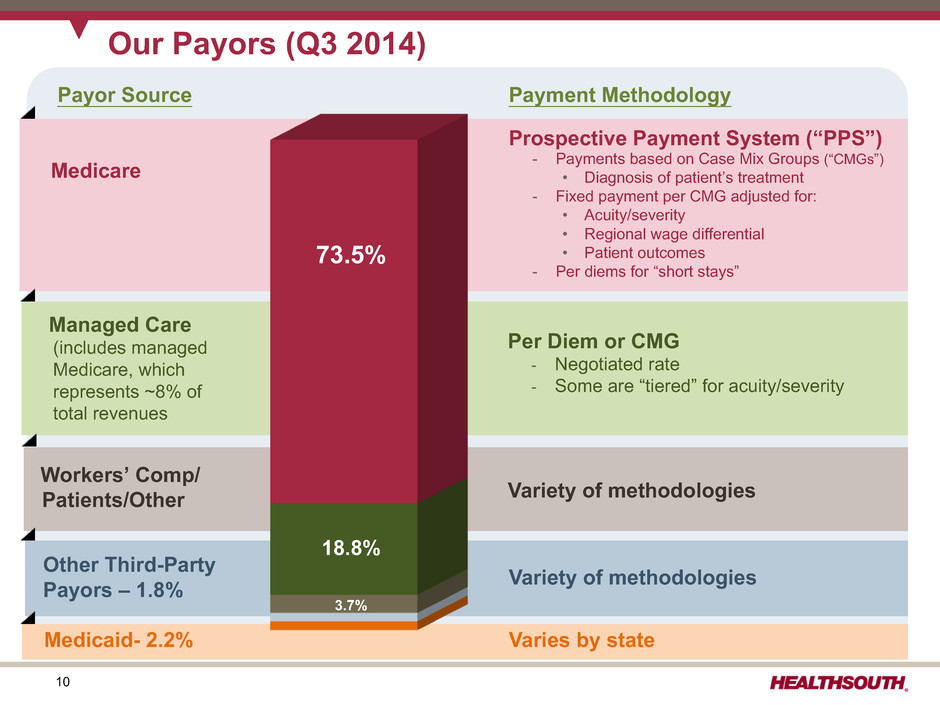
10 Workers’ Comp/ Patients/Other Our Payors (Q3 2014) Medicaid- 2.2% Varies by state Prospective Payment System (“PPS”) - Payments based on Case Mix Groups (“CMGs”) • Diagnosis of patient’s treatment - Fixed payment per CMG adjusted for: • Acuity/severity • Regional wage differential • Patient outcomes - Per diems for “short stays” Medicare Payor Source Payment Methodology Per Diem or CMG - Negotiated rate - Some are “tiered” for acuity/severity Variety of methodologies Variety of methodologies Managed Care (includes managed Medicare, which represents ~8% of total revenues 73.5% 18.8% 3.7% Other Third-Party Payors – 1.8%
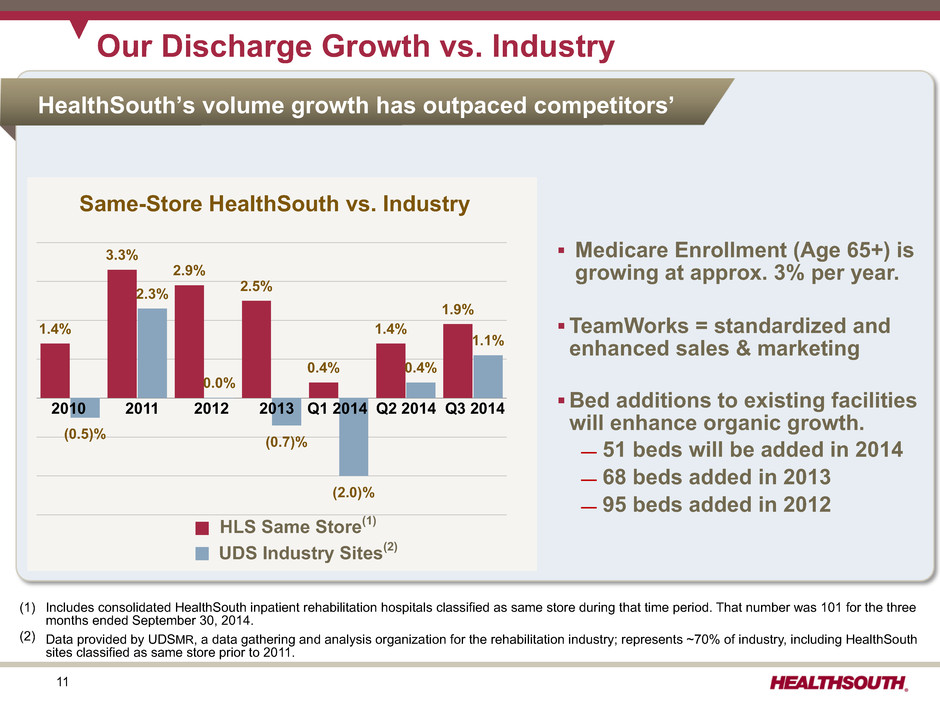
11 Our Discharge Growth vs. Industry ▪ Medicare Enrollment (Age 65+) is growing at approx. 3% per year. ▪ TeamWorks = standardized and enhanced sales & marketing ▪ Bed additions to existing facilities will enhance organic growth. — 51 beds will be added in 2014 — 68 beds added in 2013 — 95 beds added in 2012 Same-Store HealthSouth vs. Industry 1.4% 3.3% 2.9% 2.5% 0.4% 1.4% 1.9% (0.5)% 2.3% 0.0% (0.7)% (2.0)% 0.4% 1.1% HealthSouth’s volume growth has outpaced competitors’ 2010 2011 2012 2013 Q1 2014 Q2 2014 Q3 2014 HLS Same Store(1) UDS Industry Sites(2) (1) Includes consolidated HealthSouth inpatient rehabilitation hospitals classified as same store during that time period. That number was 101 for the three months ended September 30, 2014. (2) Data provided by UDSMR, a data gathering and analysis organization for the rehabilitation industry; represents ~70% of industry, including HealthSouth sites classified as same store prior to 2011.
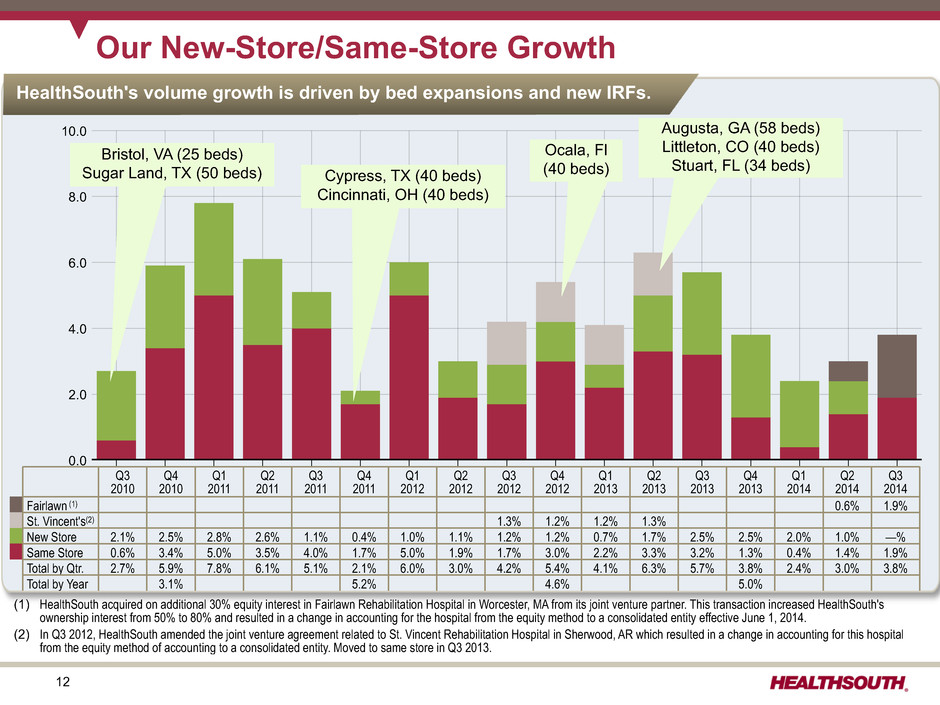
12 10.0 8.0 6.0 4.0 2.0 0.0 Q3 2010 Q4 2010 Q1 2011 Q2 2011 Q3 2011 Q4 2011 Q1 2012 Q2 2012 Q3 2012 Q4 2012 Q1 2013 Q2 2013 Q3 2013 Q4 2013 Q1 2014 Q2 2014 Q3 2014 Our New-Store/Same-Store Growth HealthSouth's volume growth is driven by bed expansions and new IRFs. Q3 2010 Q4 2010 Q1 2011 Q2 2011 Q3 2011 Q4 2011 Q1 2012 Q2 2012 Q3 2012 Q4 2012 Q1 2013 Q2 2013 Q3 2013 Q4 2013 Q1 2014 Q2 2014 Q3 2014 Fairlawn (1) 0.6% 1.9% St. Vincent's(2) 1.3% 1.2% 1.2% 1.3% New Store 2.1% 2.5% 2.8% 2.6% 1.1% 0.4% 1.0% 1.1% 1.2% 1.2% 0.7% 1.7% 2.5% 2.5% 2.0% 1.0% —% Same Store 0.6% 3.4% 5.0% 3.5% 4.0% 1.7% 5.0% 1.9% 1.7% 3.0% 2.2% 3.3% 3.2% 1.3% 0.4% 1.4% 1.9% Total by Qtr. 2.7% 5.9% 7.8% 6.1% 5.1% 2.1% 6.0% 3.0% 4.2% 5.4% 4.1% 6.3% 5.7% 3.8% 2.4% 3.0% 3.8% Total by Year 3.1% 5.2% 4.6% 5.0% (1) HealthSouth acquired on additional 30% equity interest in Fairlawn Rehabilitation Hospital in Worcester, MA from its joint venture partner. This transaction increased HealthSouth's ownership interest from 50% to 80% and resulted in a change in accounting for the hospital from the equity method to a consolidated entity effective June 1, 2014. (2) In Q3 2012, HealthSouth amended the joint venture agreement related to St. Vincent Rehabilitation Hospital in Sherwood, AR which resulted in a change in accounting for this hospital from the equity method of accounting to a consolidated entity. Moved to same store in Q3 2013. Bristol, VA (25 beds) Sugar Land, TX (50 beds) Cypress, TX (40 beds) Cincinnati, OH (40 beds) Ocala, Fl (40 beds) Augusta, GA (58 beds) Littleton, CO (40 beds) Stuart, FL (34 beds)
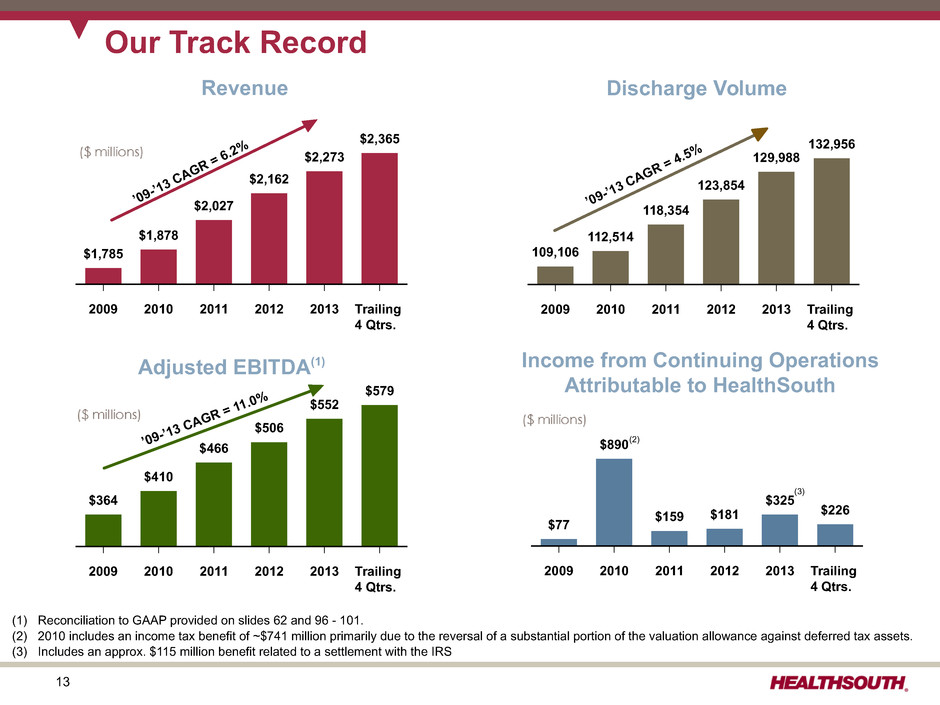
13 Revenue 2009 2010 2011 2012 2013 Trailing 4 Qtrs. $1,785 $1,878 $2,027 $2,162 $2,273 $2,365 2009 2010 2011 2012 2013 Trailing 4 Qtrs. $364 $410 $466 $506 $552 $579 Discharge Volume 2009 2010 2011 2012 2013 Trailing 4 Qtrs. 109,106 112,514 118,354 123,854 129,988 132,956 Income from Continuing Operations Attributable to HealthSouth 2009 2010 2011 2012 2013 Trailing 4 Qtrs. $77 $890 $159 $181 $325 $226 Our Track Record (3) ’09-’13 CAGR = 6.2 % ’09-’13 CAGR = 4.5 % ’09-’13 CAGR = 11.0% (2) Adjusted EBITDA(1) (1) Reconciliation to GAAP provided on slides 62 and 96 - 101. (2) 2010 includes an income tax benefit of ~$741 million primarily due to the reversal of a substantial portion of the valuation allowance against deferred tax assets. (3) Includes an approx. $115 million benefit related to a settlement with the IRS

14 2009 2010 2011 2012 2013 Trailing 4 Qtrs. $155 $181 $243 $268 $331 $332 $119 $99 Our Track Record (con’t) 2009 2010 2011 2012 2013 Trailing 4 Qtrs. Pro Forma $1.66 $1.51 $1.25 $1.25 $1.52 $1.65 $1.45 (billions) Leverage Ratio(1) Total Debt (millions) Adjusted Free Cash Flow(2) Cash Interest Expense 4.6x 2.5x (1) Based on 2009 and trailing 4 quarters Adjusted EBITDA of $363.7 and $579.1 million, respectively; reconciliation to GAAP provided on slides 62 and 96-101. (2) Reconciliation to GAAP provided on slide 61. (3) In September 2014, the Company issued an additional $175 million of its 5.75% senior notes due 2024 and amended the credit agreement governing its senior secured credit facility to extend the maturity to September 2019 and add a $150 million term loan commitment. In October 2014, the Company redeemed all of its 7.25% senior notes due 2018. (3)
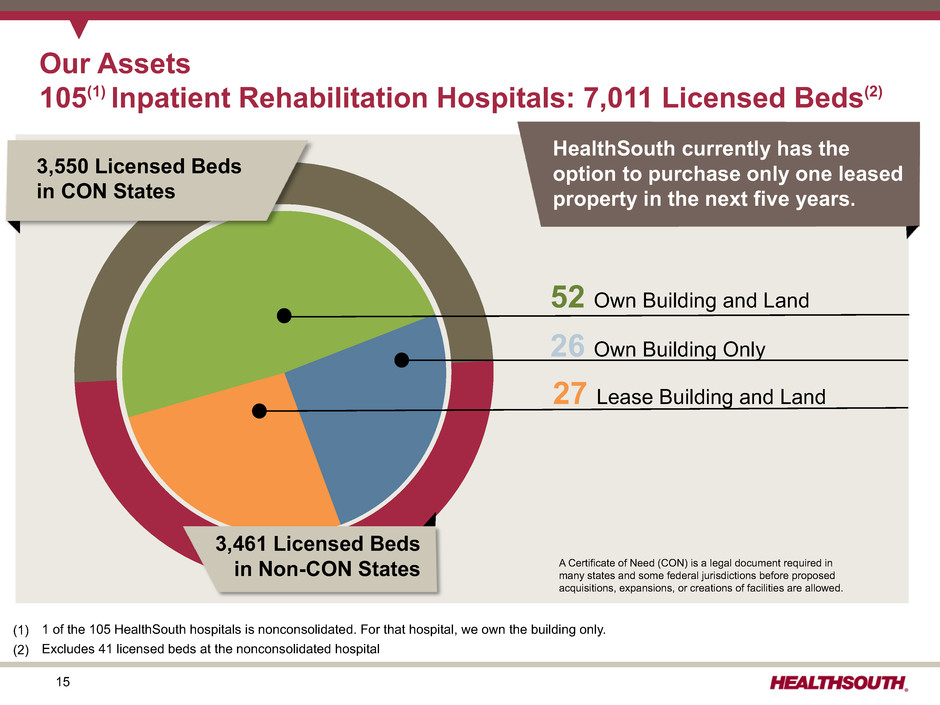
15 Our Assets 105(1) Inpatient Rehabilitation Hospitals: 7,011 Licensed Beds(2) 27 Lease Building and Land A Certificate of Need (CON) is a legal document required in many states and some federal jurisdictions before proposed acquisitions, expansions, or creations of facilities are allowed. 3,550 Licensed Beds in CON States HealthSouth currently has the option to purchase only one leased property in the next five years. 52 Own Building and Land 26 Own Building Only (1) 1 of the 105 HealthSouth hospitals is nonconsolidated. For that hospital, we own the building only. (2) Excludes 41 licensed beds at the nonconsolidated hospital 3,461 Licensed Beds in Non-CON States
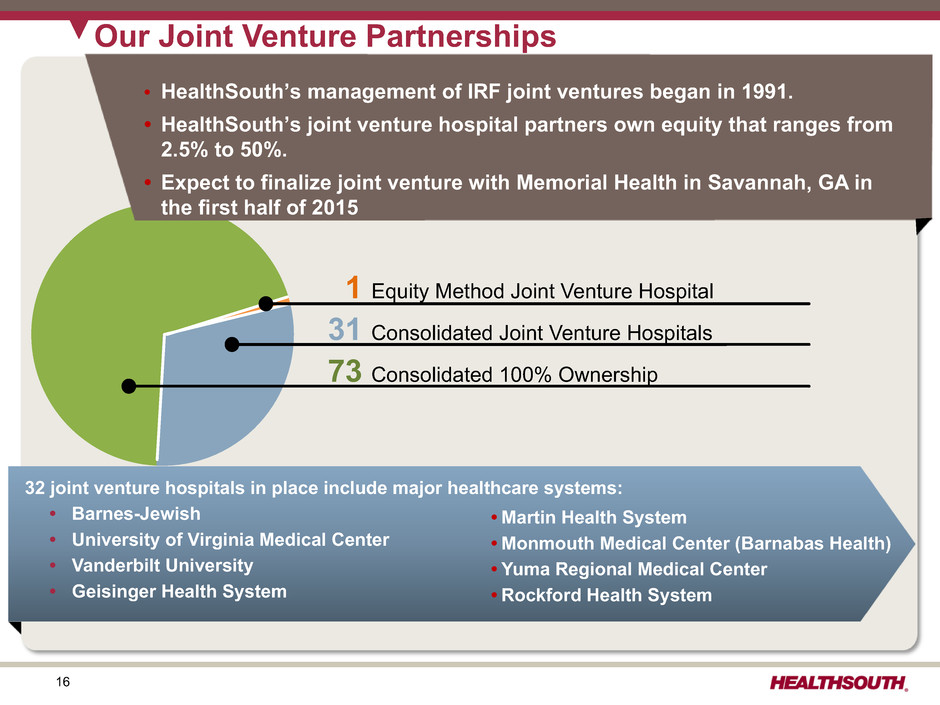
16 Our Joint Venture Partnerships 1 Equity Method Joint Venture Hospital 31 Consolidated Joint Venture Hospitals 73 Consolidated 100% Ownership 32 joint venture hospitals in place include major healthcare systems: • Barnes-Jewish • University of Virginia Medical Center • Vanderbilt University • Geisinger Health System • Martin Health System • Monmouth Medical Center (Barnabas Health) • Yuma Regional Medical Center • Rockford Health System • HealthSouth’s management of IRF joint ventures began in 1991. • HealthSouth’s joint venture hospital partners own equity that ranges from 2.5% to 50%. • Expect to finalize joint venture with Memorial Health in Savannah, GA in the first half of 2015
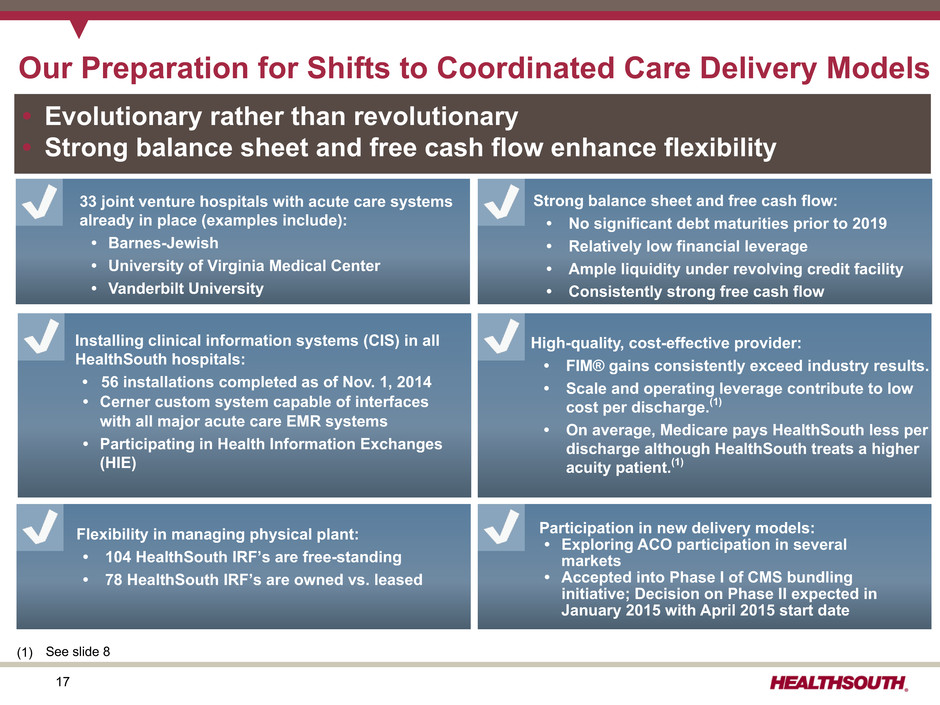
17 Our Preparation for Shifts to Coordinated Care Delivery Models • Evolutionary rather than revolutionary • Strong balance sheet and free cash flow enhance flexibility 33 joint venture hospitals with acute care systems already in place (examples include): • Barnes-Jewish • University of Virginia Medical Center • Vanderbilt University Installing clinical information systems (CIS) in all HealthSouth hospitals: • 56 installations completed as of Nov. 1, 2014 • Cerner custom system capable of interfaces with all major acute care EMR systems • Participating in Health Information Exchanges (HIE) Flexibility in managing physical plant: • 104 HealthSouth IRF’s are free-standing • 78 HealthSouth IRF’s are owned vs. leased Strong balance sheet and free cash flow: • No significant debt maturities prior to 2019 • Relatively low financial leverage • Ample liquidity under revolving credit facility • Consistently strong free cash flow High-quality, cost-effective provider: • FIM® gains consistently exceed industry results. • Scale and operating leverage contribute to low cost per discharge.(1) • On average, Medicare pays HealthSouth less per discharge although HealthSouth treats a higher acuity patient.(1) Participation in new delivery models: • Exploring ACO participation in several markets • Accepted into Phase I of CMS bundling initiative; Decision on Phase II expected in January 2015 with April 2015 start date (1) See slide 8
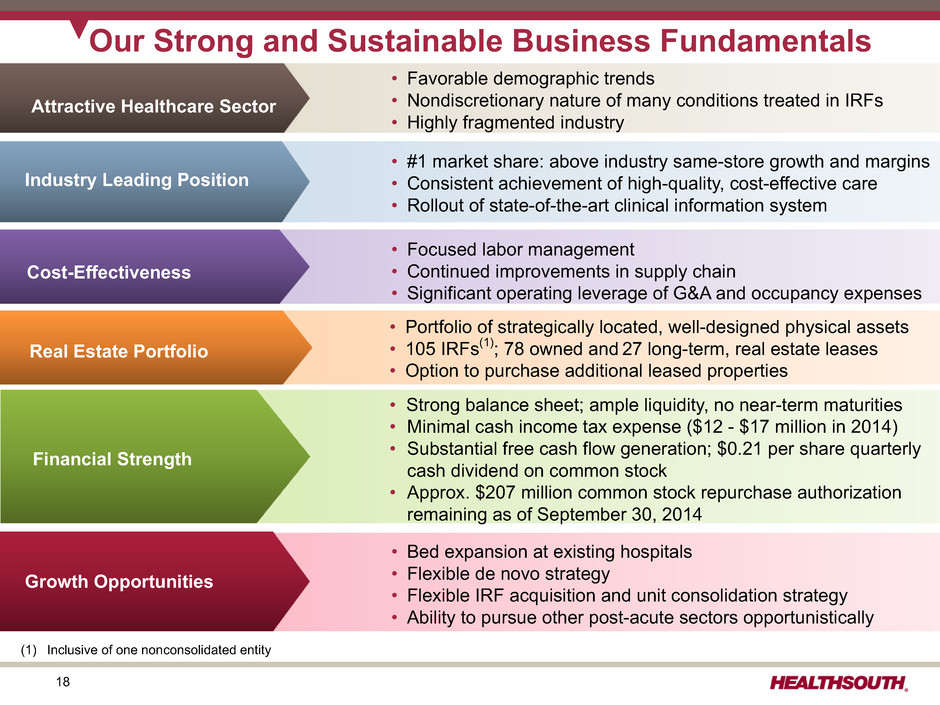
18 Our Strong and Sustainable Business Fundamentals • Focused labor management • Continued improvements in supply chain • Significant operating leverage of G&A and occupancy expenses Cost-Effectiveness Financial Strength • Strong balance sheet; ample liquidity, no near-term maturities • Minimal cash income tax expense ($12 - $17 million in 2014) • Substantial free cash flow generation; $0.21 per share quarterly cash dividend on common stock • Approx. $207 million common stock repurchase authorization remaining as of September 30, 2014 • #1 market share: above industry same-store growth and margins • Consistent achievement of high-quality, cost-effective care • Rollout of state-of-the-art clinical information system • Bed expansion at existing hospitals • Flexible de novo strategy • Flexible IRF acquisition and unit consolidation strategy • Ability to pursue other post-acute sectors opportunistically • Portfolio of strategically located, well-designed physical assets • 105 IRFs(1); 78 owned and 27 long-term, real estate leases • Option to purchase additional leased properties Real Estate Portfolio • Favorable demographic trends • Nondiscretionary nature of many conditions treated in IRFs • Highly fragmented industry Attractive Healthcare Sector Growth Opportunities Industry Leading Position Cost-Effectiveness (1) Inclusive of one nonconsolidated entity
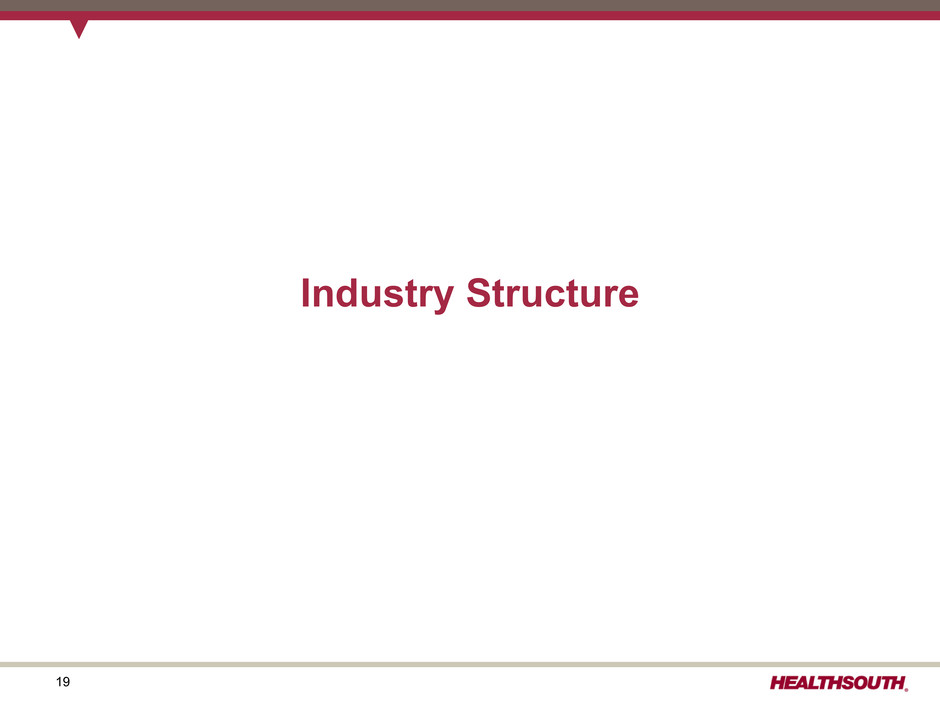
19 Industry Structure
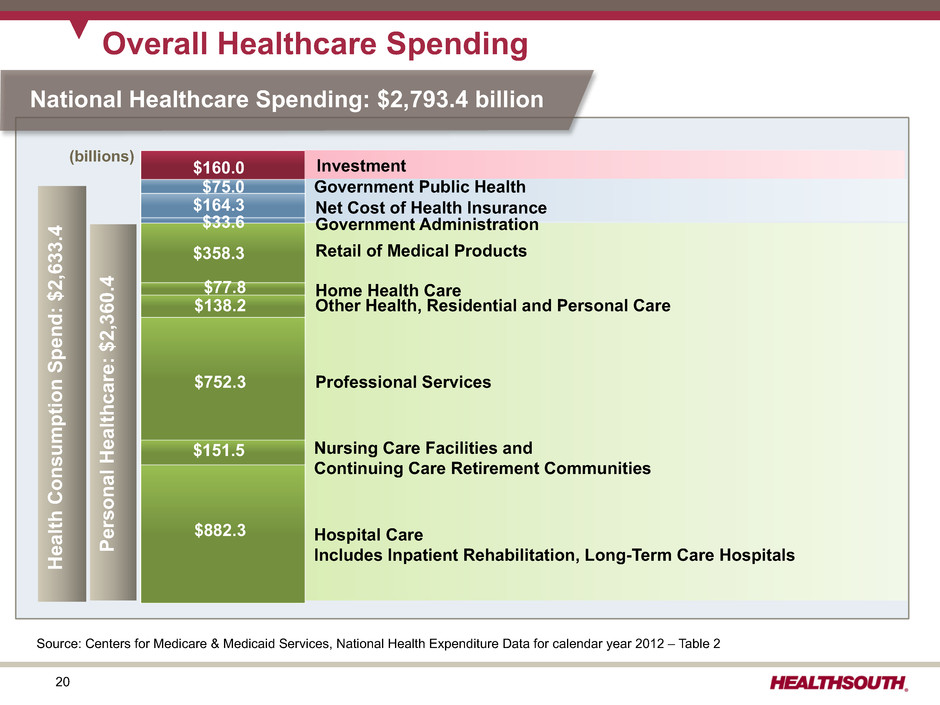
20 Source: Centers for Medicare & Medicaid Services, National Health Expenditure Data for calendar year 2012 – Table 2 Overall Healthcare Spending Hospital Care Includes Inpatient Rehabilitation, Long-Term Care Hospitals $151.5 $752.3 $138.2 $77.8 $358.3 Nursing Care Facilities and Continuing Care Retirement Communities Professional Services Other Health, Residential and Personal Care Home Health Care Retail of Medical Products $33.6 $164.3 $75.0 $160.0(billions) National Healthcare Spending: $2,793.4 billion Health Consumption Spend: $2,633.4 Personal Healthcare: $2,360. 4 Investment Net Cost of Health Insurance Government Public Health Government Administration $882.3 $151.5
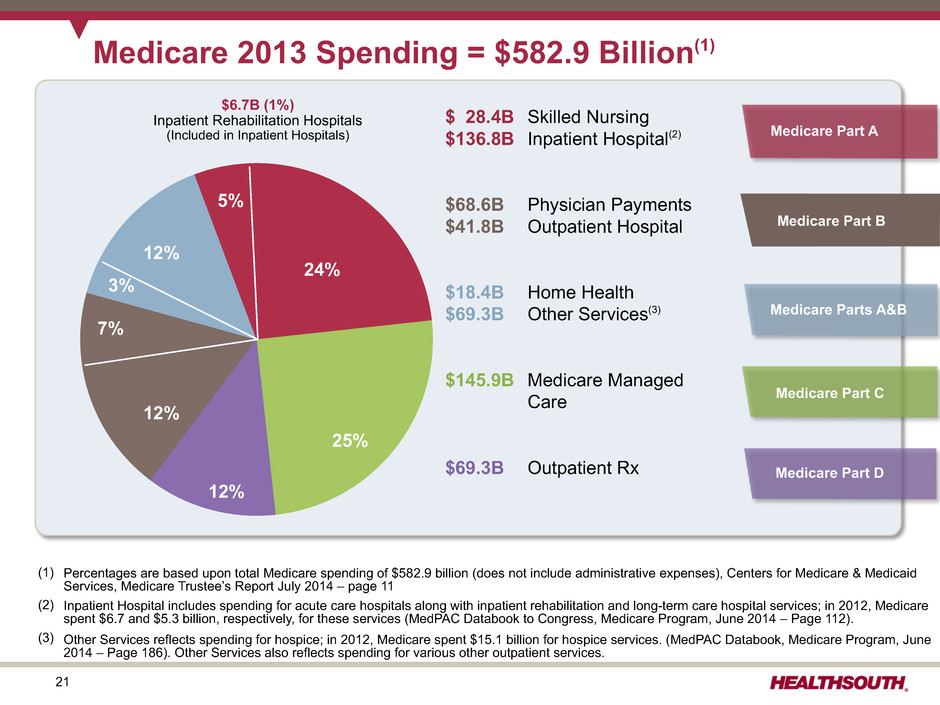
21 Medicare 2013 Spending = $582.9 Billion(1) $ 28.4B Skilled Nursing $136.8B Inpatient Hospital(2) $68.6B Physician Payments $41.8B Outpatient Hospital $18.4B Home Health $69.3B Other Services(3) $145.9B Medicare Managed Care $69.3B Outpatient Rx $6.7B (1%) Inpatient Rehabilitation Hospitals (Included in Inpatient Hospitals) 12% 3% 7% 12% 12% 25% 24% Medicare Part A Medicare Part B Medicare Parts A&B Medicare Part C Medicare Part D 5% (1) Percentages are based upon total Medicare spending of $582.9 billion (does not include administrative expenses), Centers for Medicare & Medicaid Services, Medicare Trustee’s Report July 2014 – page 11 (2) Inpatient Hospital includes spending for acute care hospitals along with inpatient rehabilitation and long-term care hospital services; in 2012, Medicare spent $6.7 and $5.3 billion, respectively, for these services (MedPAC Databook to Congress, Medicare Program, June 2014 – Page 112). (3) Other Services reflects spending for hospice; in 2012, Medicare spent $15.1 billion for hospice services. (MedPAC Databook, Medicare Program, June 2014 – Page 186). Other Services also reflects spending for various other outpatient services.
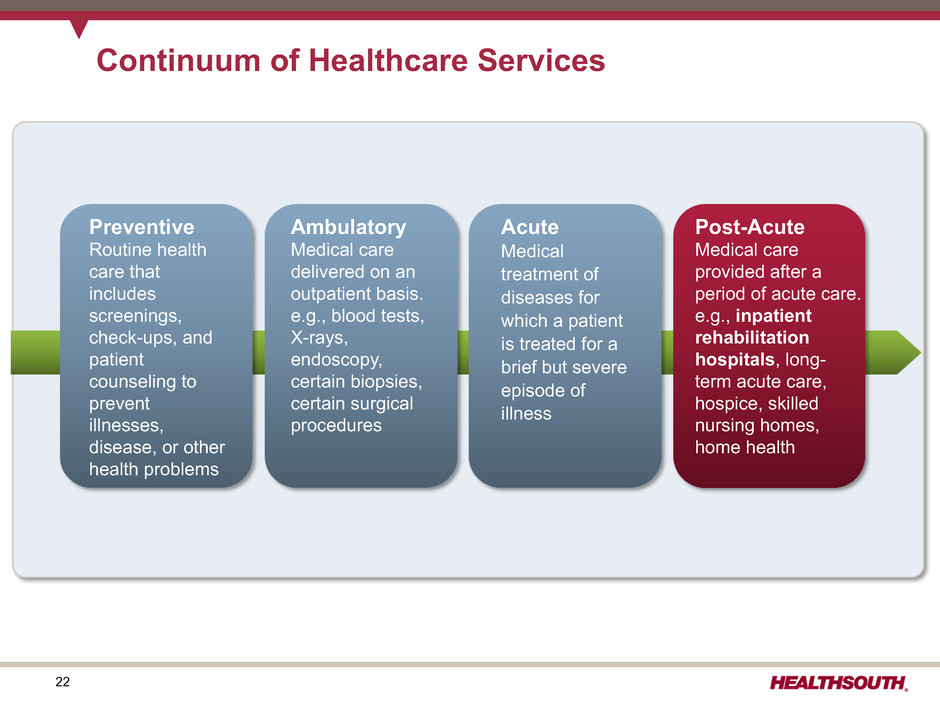
22 Continuum of Healthcare Services Preventive Routine health care that includes screenings, check-ups, and patient counseling to prevent illnesses, disease, or other health problems Ambulatory Medical care delivered on an outpatient basis. e.g., blood tests, X-rays, endoscopy, certain biopsies, certain surgical procedures Acute Medical treatment of diseases for which a patient is treated for a brief but severe episode of illness Post-Acute Medical care provided after a period of acute care. e.g., inpatient rehabilitation hospitals, long- term acute care, hospice, skilled nursing homes, home health
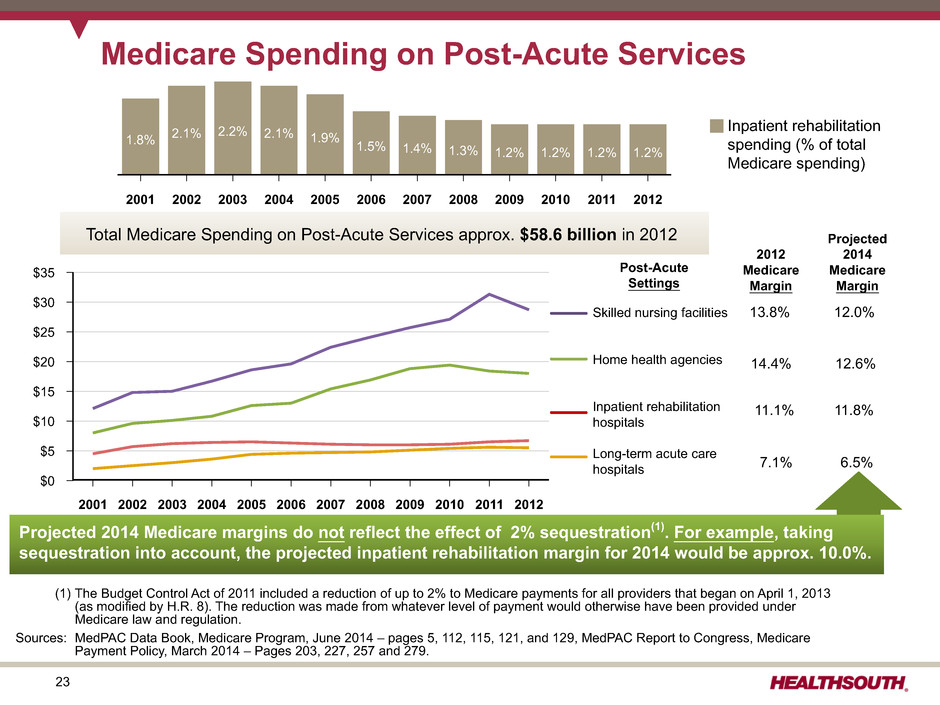
23 Medicare Spending on Post-Acute Services Post-Acute Settings 2012 Medicare Margin Projected 2014 Medicare Margin Sources: (1) 13.8% 12.0% 14.4% 12.6% 11.1% 11.8% 7.1% 6.5% Skilled nursing facilities Home health agencies Inpatient rehabilitation hospitals Long-term acute care hospitals 2001 2002 2003 2004 2005 2006 2007 2008 2009 2010 2011 2012 1.8% 2.1% 2.2% 2.1% 1.9% 1.5% 1.4% 1.3% 1.2% 1.2% 1.2% 1.2% Inpatient rehabilitation spending (% of total Medicare spending) Projected 2014 Medicare margins do not reflect the effect of 2% sequestration(1). For example, taking sequestration into account, the projected inpatient rehabilitation margin for 2014 would be approx. 10.0%. $35 $30 $25 $20 $15 $10 $5 $0 2001 2002 2003 2004 2005 2006 2007 2008 2009 2010 2011 2012 (1) The Budget Control Act of 2011 included a reduction of up to 2% to Medicare payments for all providers that began on April 1, 2013 (as modified by H.R. 8). The reduction was made from whatever level of payment would otherwise have been provided under Medicare law and regulation. Sources: MedPAC Data Book, Medicare Program, June 2014 – pages 5, 112, 115, 121, and 129, MedPAC Report to Congress, Medicare Payment Policy, March 2014 – Pages 203, 227, 257 and 279. Total Medicare Spending on Post-Acute Services approx. $58.6 billion in 2012

24 Geographic Distribution of IRFs, 2012 Source: MedPAC Report to Congress, Medicare Payment Policy, March 2014 – page 243
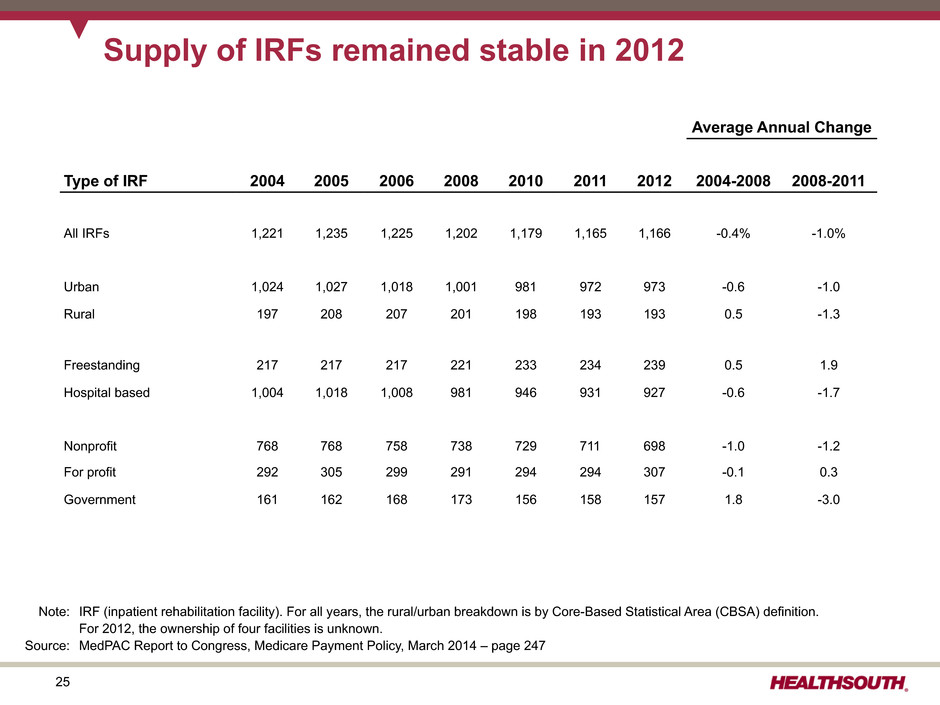
25 Supply of IRFs remained stable in 2012 Average Annual Change Type of IRF 2004 2005 2006 2008 2010 2011 2012 2004-2008 2008-2011 All IRFs 1,221 1,235 1,225 1,202 1,179 1,165 1,166 -0.4% -1.0% Urban 1,024 1,027 1,018 1,001 981 972 973 -0.6 -1.0 Rural 197 208 207 201 198 193 193 0.5 -1.3 Freestanding 217 217 217 221 233 234 239 0.5 1.9 Hospital based 1,004 1,018 1,008 981 946 931 927 -0.6 -1.7 Nonprofit 768 768 758 738 729 711 698 -1.0 -1.2 For profit 292 305 299 291 294 294 307 -0.1 0.3 Government 161 162 168 173 156 158 157 1.8 -3.0 Note: IRF (inpatient rehabilitation facility). For all years, the rural/urban breakdown is by Core-Based Statistical Area (CBSA) definition. For 2012, the ownership of four facilities is unknown. Source: MedPAC Report to Congress, Medicare Payment Policy, March 2014 – page 247
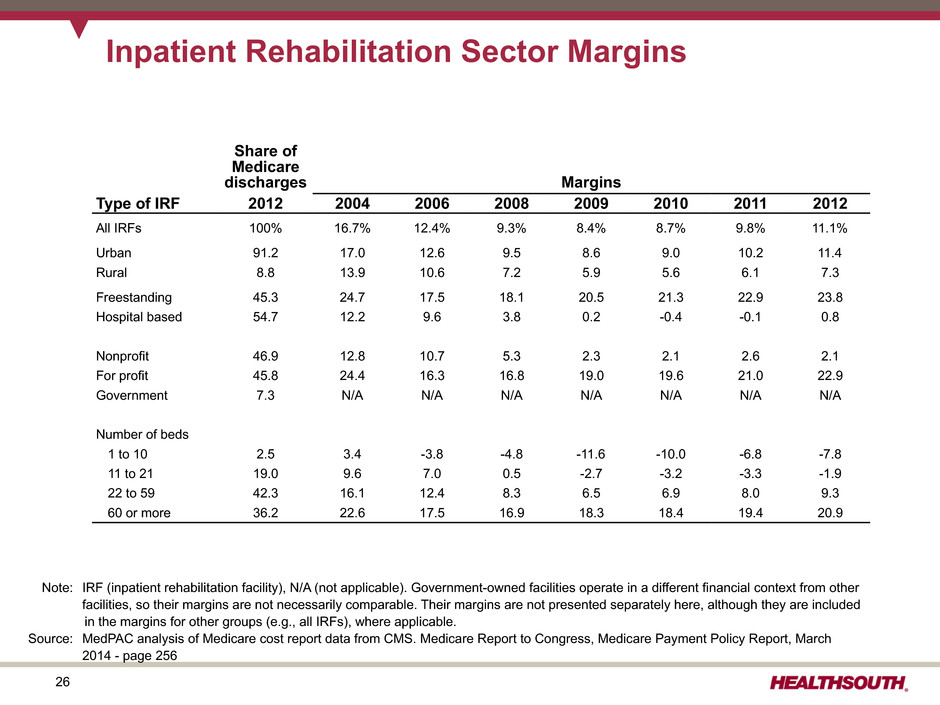
26 Inpatient Rehabilitation Sector Margins Share of Medicare discharges Margins Type of IRF 2012 2004 2006 2008 2009 2010 2011 2012 All IRFs 100% 16.7% 12.4% 9.3% 8.4% 8.7% 9.8% 11.1% Urban 91.2 17.0 12.6 9.5 8.6 9.0 10.2 11.4 Rural 8.8 13.9 10.6 7.2 5.9 5.6 6.1 7.3 Freestanding 45.3 24.7 17.5 18.1 20.5 21.3 22.9 23.8 Hospital based 54.7 12.2 9.6 3.8 0.2 -0.4 -0.1 0.8 Nonprofit 46.9 12.8 10.7 5.3 2.3 2.1 2.6 2.1 For profit 45.8 24.4 16.3 16.8 19.0 19.6 21.0 22.9 Government 7.3 N/A N/A N/A N/A N/A N/A N/A Number of beds 1 to 10 2.5 3.4 -3.8 -4.8 -11.6 -10.0 -6.8 -7.8 11 to 21 19.0 9.6 7.0 0.5 -2.7 -3.2 -3.3 -1.9 22 to 59 42.3 16.1 12.4 8.3 6.5 6.9 8.0 9.3 60 or more 36.2 22.6 17.5 16.9 18.3 18.4 19.4 20.9 Note: IRF (inpatient rehabilitation facility), N/A (not applicable). Government-owned facilities operate in a different financial context from other facilities, so their margins are not necessarily comparable. Their margins are not presented separately here, although they are included in the margins for other groups (e.g., all IRFs), where applicable. Source: MedPAC analysis of Medicare cost report data from CMS. Medicare Report to Congress, Medicare Payment Policy Report, March 2014 - page 256
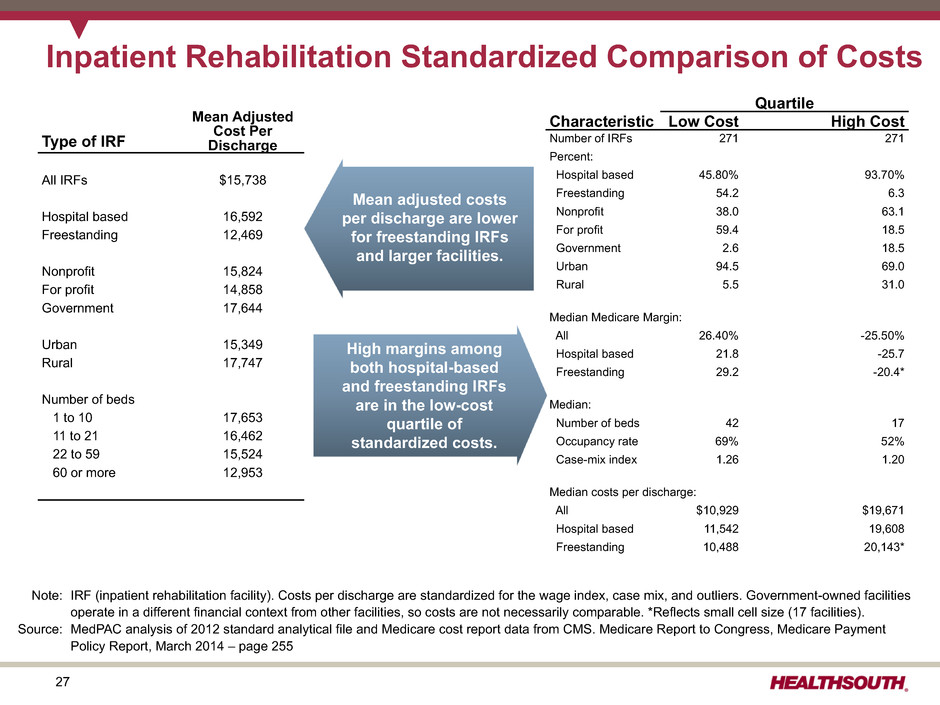
27 Inpatient Rehabilitation Standardized Comparison of Costs Type of IRF Mean Adjusted Cost Per Discharge All IRFs $15,738 Hospital based 16,592 Freestanding 12,469 Nonprofit 15,824 For profit 14,858 Government 17,644 Urban 15,349 Rural 17,747 Number of beds 1 to 10 17,653 11 to 21 16,462 22 to 59 15,524 60 or more 12,953 Quartile Characteristic Low Cost High Cost Number of IRFs 271 271 Percent: Hospital based 45.80% 93.70% Freestanding 54.2 6.3 Nonprofit 38.0 63.1 For profit 59.4 18.5 Government 2.6 18.5 Urban 94.5 69.0 Rural 5.5 31.0 Median Medicare Margin: All 26.40% -25.50% Hospital based 21.8 -25.7 Freestanding 29.2 -20.4* Median: Number of beds 42 17 Occupancy rate 69% 52% Case-mix index 1.26 1.20 Median costs per discharge: All $10,929 $19,671 Hospital based 11,542 19,608 Freestanding 10,488 20,143* Mean adjusted costs per discharge are lower for freestanding IRFs and larger facilities. High margins among both hospital-based and freestanding IRFs are in the low-cost quartile of standardized costs. Note: IRF (inpatient rehabilitation facility). Costs per discharge are standardized for the wage index, case mix, and outliers. Government-owned facilities operate in a different financial context from other facilities, so costs are not necessarily comparable. *Reflects small cell size (17 facilities). Source: MedPAC analysis of 2012 standard analytical file and Medicare cost report data from CMS. Medicare Report to Congress, Medicare Payment Policy Report, March 2014 – page 255
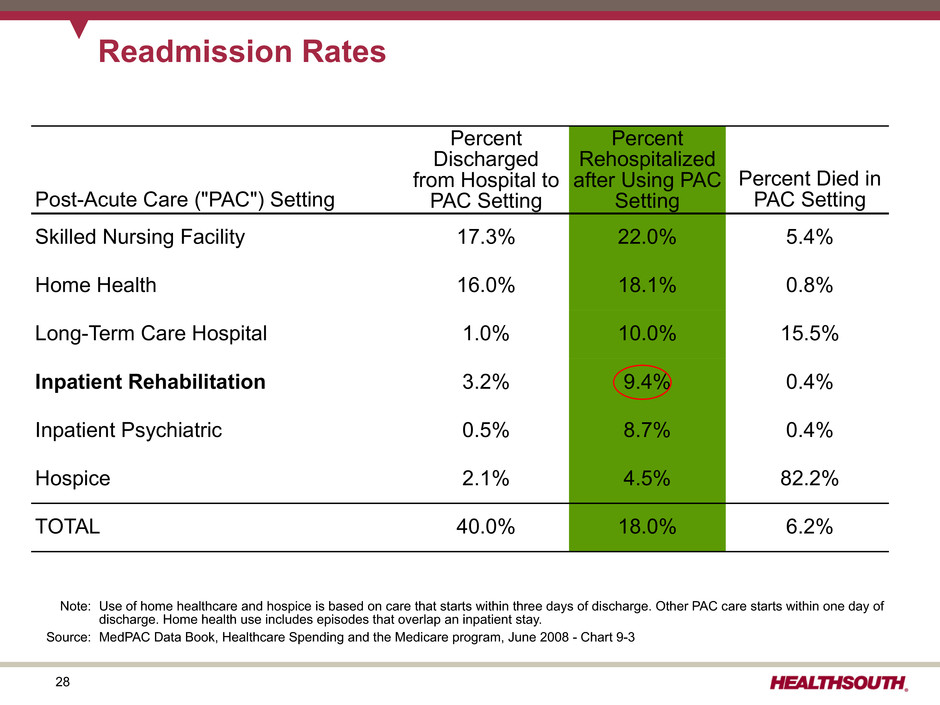
28 Post-Acute Care ("PAC") Setting Percent Discharged from Hospital to PAC Setting Percent Rehospitalized after Using PAC Setting Percent Died in PAC Setting Skilled Nursing Facility 17.3% 22.0% 5.4% Home Health 16.0% 18.1% 0.8% Long-Term Care Hospital 1.0% 10.0% 15.5% Inpatient Rehabilitation 3.2% 9.4% 0.4% Inpatient Psychiatric 0.5% 8.7% 0.4% Hospice 2.1% 4.5% 82.2% TOTAL 40.0% 18.0% 6.2% Readmission Rates Note: Use of home healthcare and hospice is based on care that starts within three days of discharge. Other PAC care starts within one day of discharge. Home health use includes episodes that overlap an inpatient stay. Source: MedPAC Data Book, Healthcare Spending and the Medicare program, June 2008 - Chart 9-3
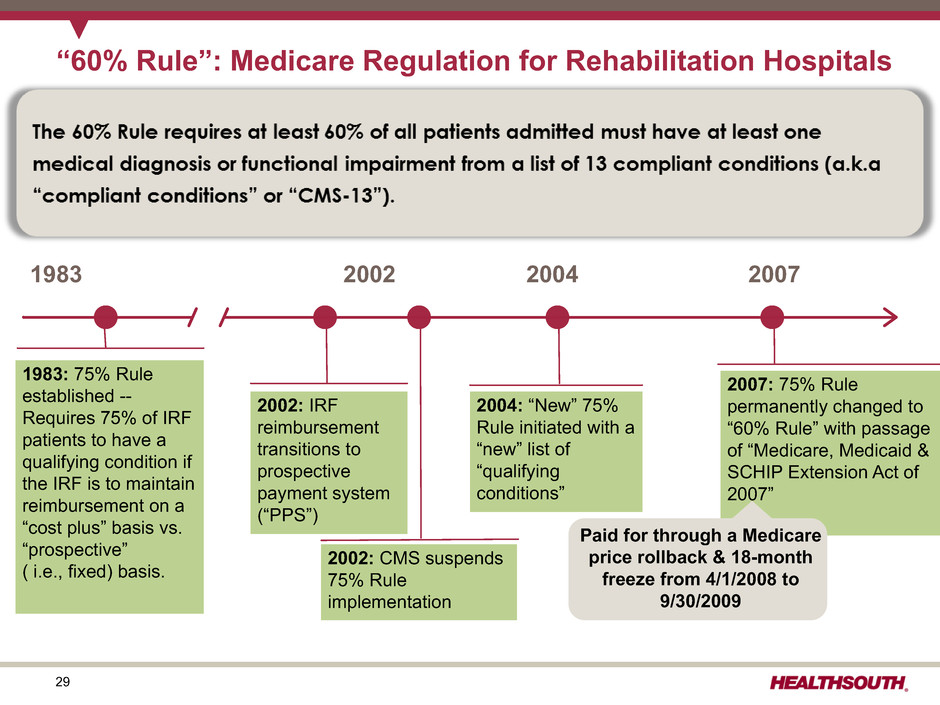
29 “60% Rule”: Medicare Regulation for Rehabilitation Hospitals 1983 1983: 75% Rule established -- Requires 75% of IRF patients to have a qualifying condition if the IRF is to maintain reimbursement on a “cost plus” basis vs. “prospective” ( i.e., fixed) basis. 2002 2004 2007 2002: IRF reimbursement transitions to prospective payment system (“PPS”) 2002: CMS suspends 75% Rule implementation 2004: “New” 75% Rule initiated with a “new” list of “qualifying conditions” 2007: 75% Rule permanently changed to “60% Rule” with passage of “Medicare, Medicaid & SCHIP Extension Act of 2007” Paid for through a Medicare price rollback & 18-month freeze from 4/1/2008 to 9/30/2009
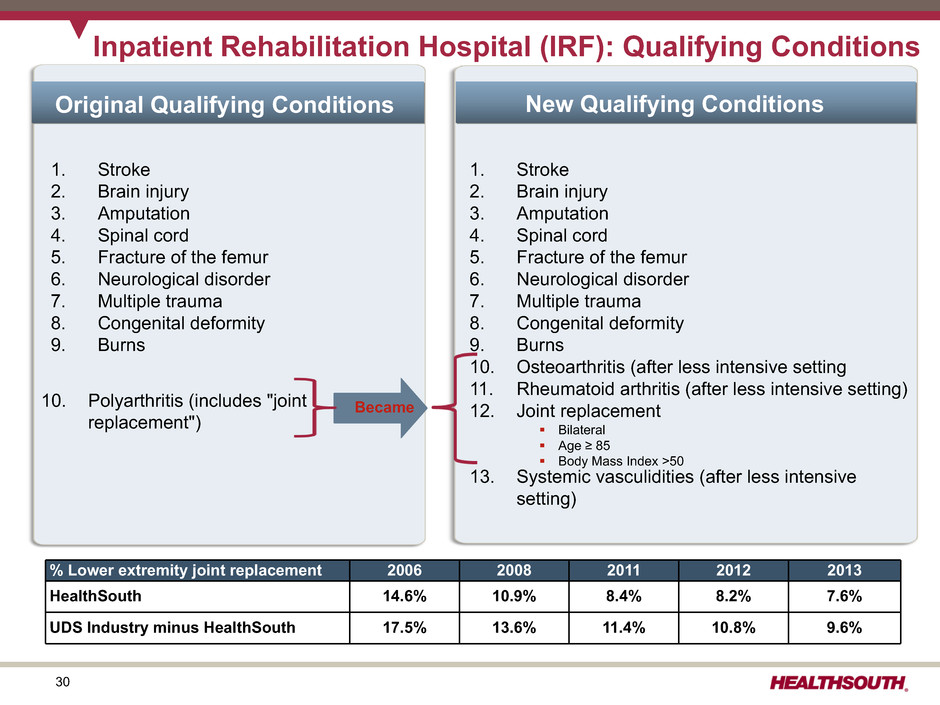
30 Inpatient Rehabilitation Hospital (IRF): Qualifying Conditions 1. Stroke 2. Brain injury 3. Amputation 4. Spinal cord 5. Fracture of the femur 6. Neurological disorder 7. Multiple trauma 8. Congenital deformity 9. Burns 10. Osteoarthritis (after less intensive setting 11. Rheumatoid arthritis (after less intensive setting) 12. Joint replacement 13. Systemic vasculidities (after less intensive setting) % Lower extremity joint replacement 2006 2008 2011 2012 2013 HealthSouth 14.6% 10.9% 8.4% 8.2% 7.6% UDS Industry minus HealthSouth 17.5% 13.6% 11.4% 10.8% 9.6% Became 1. Stroke 2. Brain injury 3. Amputation 4. Spinal cord 5. Fracture of the femur 6. Neurological disorder 7. Multiple trauma 8. Congenital deformity 9. Burns Original Qualifying Conditions New Qualifying Conditions § Bilateral § Age ≥ 85 § Body Mass Index >50 10. Polyarthritis (includes "joint replacement") Became
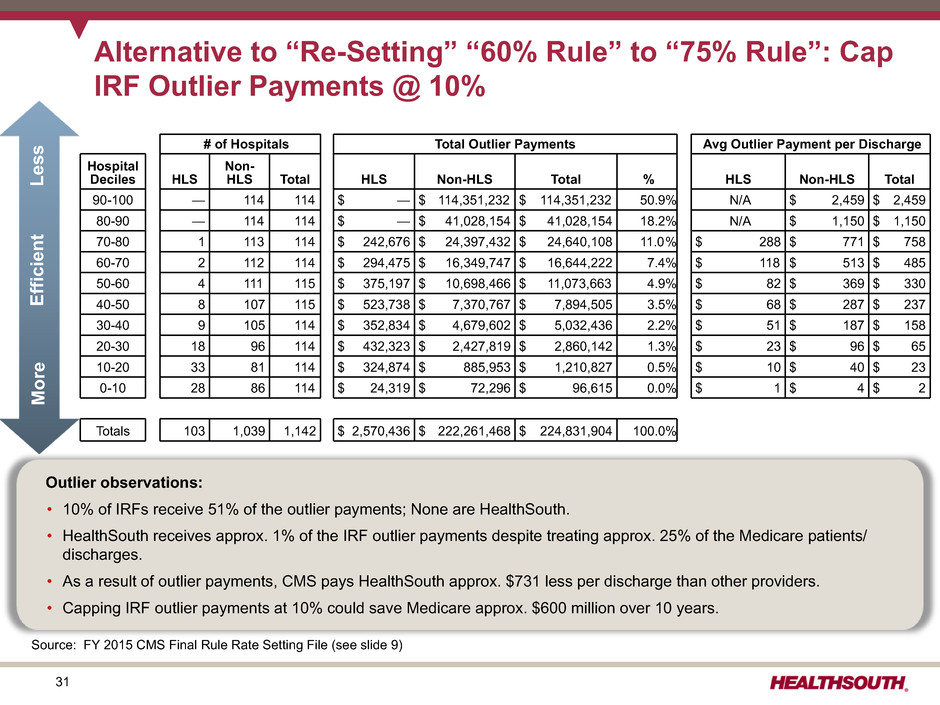
31 Alternative to “Re-Setting” “60% Rule” to “75% Rule”: Cap IRF Outlier Payments @ 10% Source: FY 2015 CMS Final Rule Rate Setting File (see slide 9) # of Hospitals Total Outlier Payments Avg Outlier Payment per Discharge Hospital Deciles HLS Non- HLS Total HLS Non-HLS Total % HLS Non-HLS Total 90-100 — 114 114 $ — $ 114,351,232 $ 114,351,232 50.9% N/A $ 2,459 $ 2,459 80-90 — 114 114 $ — $ 41,028,154 $ 41,028,154 18.2% N/A $ 1,150 $ 1,150 70-80 1 113 114 $ 242,676 $ 24,397,432 $ 24,640,108 11.0% $ 288 $ 771 $ 758 60-70 2 112 114 $ 294,475 $ 16,349,747 $ 16,644,222 7.4% $ 118 $ 513 $ 485 50-60 4 111 115 $ 375,197 $ 10,698,466 $ 11,073,663 4.9% $ 82 $ 369 $ 330 40-50 8 107 115 $ 523,738 $ 7,370,767 $ 7,894,505 3.5% $ 68 $ 287 $ 237 30-40 9 105 114 $ 352,834 $ 4,679,602 $ 5,032,436 2.2% $ 51 $ 187 $ 158 20-30 18 96 114 $ 432,323 $ 2,427,819 $ 2,860,142 1.3% $ 23 $ 96 $ 65 10-20 33 81 114 $ 324,874 $ 885,953 $ 1,210,827 0.5% $ 10 $ 40 $ 23 0-10 28 86 114 $ 24,319 $ 72,296 $ 96,615 0.0% $ 1 $ 4 $ 2 Totals 103 1,039 1,142 $ 2,570,436 $ 222,261,468 $ 224,831,904 100.0% Mor e Efficien t Les s Outlier observations: • 10% of IRFs receive 51% of the outlier payments; None are HealthSouth. • HealthSouth receives approx. 1% of the IRF outlier payments despite treating approx. 25% of the Medicare patients/ discharges. • As a result of outlier payments, CMS pays HealthSouth approx. $731 less per discharge than other providers. • Capping IRF outlier payments at 10% could save Medicare approx. $600 million over 10 years.
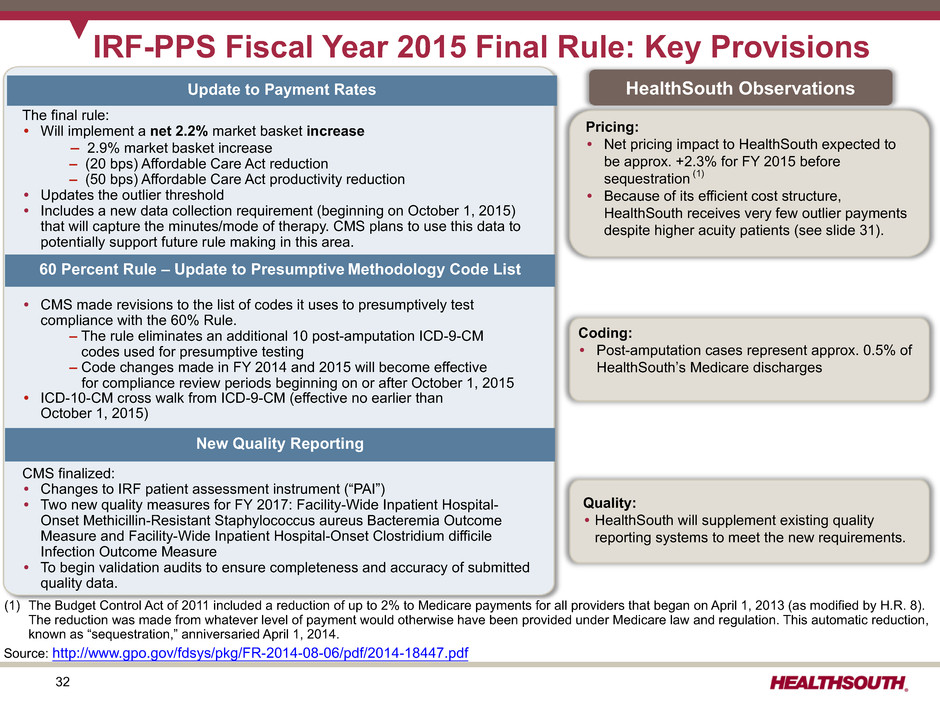
32 IRF-PPS Fiscal Year 2015 Final Rule: Key Provisions (1) (1) The Budget Control Act of 2011 included a reduction of up to 2% to Medicare payments for all providers that began on April 1, 2013 (as modified by H.R. 8). The reduction was made from whatever level of payment would otherwise have been provided under Medicare law and regulation. This automatic reduction, known as “sequestration,” anniversaried April 1, 2014. Source: http://www.gpo.gov/fdsys/pkg/FR-2014-08-06/pdf/2014-18447.pdf The final rule: • Will implement a net 2.2% market basket increase – 2.9% market basket increase – (20 bps) Affordable Care Act reduction – (50 bps) Affordable Care Act productivity reduction • Updates the outlier threshold • Includes a new data collection requirement (beginning on October 1, 2015) that will capture the minutes/mode of therapy. CMS plans to use this data to potentially support future rule making in this area. • CMS made revisions to the list of codes it uses to presumptively test compliance with the 60% Rule. – The rule eliminates an additional 10 post-amputation ICD-9-CM codes used for presumptive testing – Code changes made in FY 2014 and 2015 will become effective for compliance review periods beginning on or after October 1, 2015 • ICD-10-CM cross walk from ICD-9-CM (effective no earlier than October 1, 2015) • CMS finalized: • Changes to IRF patient assessment instrument (“PAI”) • Two new quality measures for FY 2017: Facility-Wide Inpatient Hospital- Onset Methicillin-Resistant Staphylococcus aureus Bacteremia Outcome Measure and Facility-Wide Inpatient Hospital-Onset Clostridium difficile Infection Outcome Measure • To begin validation audits to ensure completeness and accuracy of submitted quality data. 60 Percent Rule – Update to Presumptive Methodology Code List New Quality Reporting Update to Payment Rates Pricing: • Net pricing impact to HealthSouth expected to be approx. +2.3% for FY 2015 before sequestration (1) • Because of its efficient cost structure, HealthSouth receives very few outlier payments despite higher acuity patients (see slide 31). Quality: • HealthSouth will supplement existing quality reporting systems to meet the new requirements. Coding: • Post-amputation cases represent approx. 0.5% of HealthSouth’s Medicare discharges HealthSouth Observations
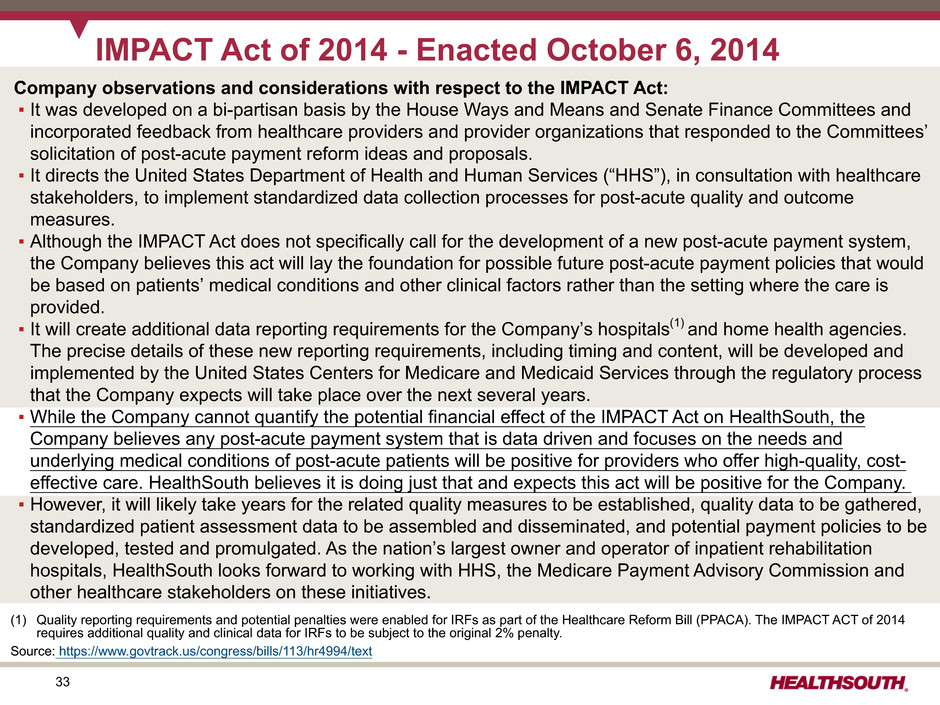
33 IMPACT Act of 2014 - Enacted October 6, 2014 (1) Quality reporting requirements and potential penalties were enabled for IRFs as part of the Healthcare Reform Bill (PPACA). The IMPACT ACT of 2014 requires additional quality and clinical data for IRFs to be subject to the original 2% penalty. Source: https://www.govtrack.us/congress/bills/113/hr4994/text Company observations and considerations with respect to the IMPACT Act: ▪ It was developed on a bi-partisan basis by the House Ways and Means and Senate Finance Committees and incorporated feedback from healthcare providers and provider organizations that responded to the Committees’ solicitation of post-acute payment reform ideas and proposals. ▪ It directs the United States Department of Health and Human Services (“HHS”), in consultation with healthcare stakeholders, to implement standardized data collection processes for post-acute quality and outcome measures. ▪ Although the IMPACT Act does not specifically call for the development of a new post-acute payment system, the Company believes this act will lay the foundation for possible future post-acute payment policies that would be based on patients’ medical conditions and other clinical factors rather than the setting where the care is provided. ▪ It will create additional data reporting requirements for the Company’s hospitals(1) and home health agencies. The precise details of these new reporting requirements, including timing and content, will be developed and implemented by the United States Centers for Medicare and Medicaid Services through the regulatory process that the Company expects will take place over the next several years. ▪ While the Company cannot quantify the potential financial effect of the IMPACT Act on HealthSouth, the Company believes any post-acute payment system that is data driven and focuses on the needs and underlying medical conditions of post-acute patients will be positive for providers who offer high-quality, cost- effective care. HealthSouth believes it is doing just that and expects this act will be positive for the Company. ▪ However, it will likely take years for the related quality measures to be established, quality data to be gathered, standardized patient assessment data to be assembled and disseminated, and potential payment policies to be developed, tested and promulgated. As the nation’s largest owner and operator of inpatient rehabilitation hospitals, HealthSouth looks forward to working with HHS, the Medicare Payment Advisory Commission and other healthcare stakeholders on these initiatives.
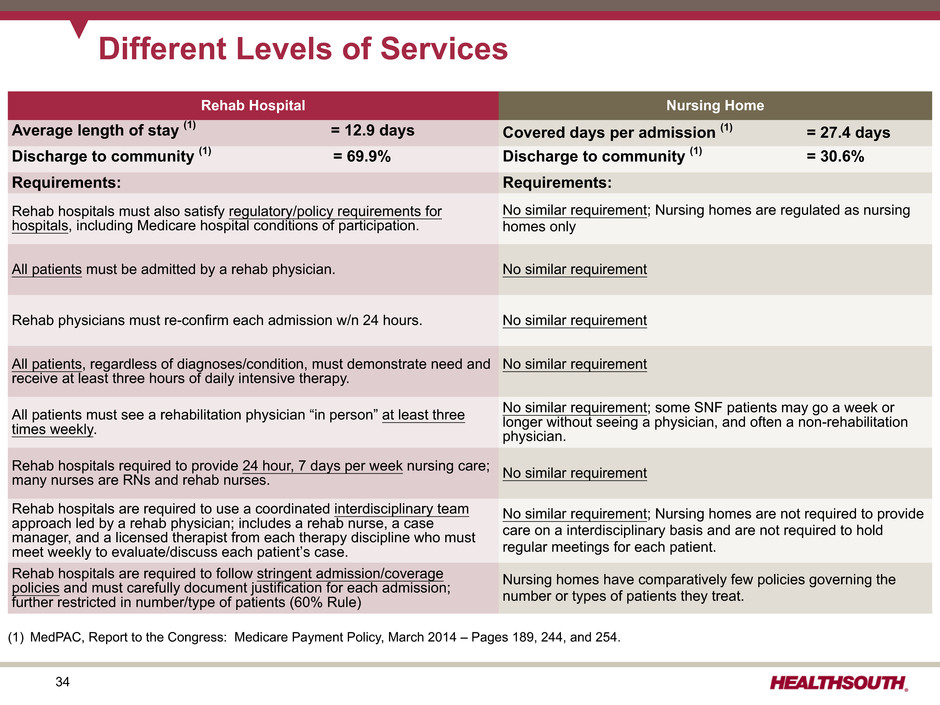
34 Different Levels of Services Rehab Hospital Nursing Home Average length of stay (1) = 12.9 days Covered days per admission (1) = 27.4 days Discharge to community (1) = 69.9% Discharge to community (1) = 30.6% Requirements: Requirements: Rehab hospitals must also satisfy regulatory/policy requirements for hospitals, including Medicare hospital conditions of participation. No similar requirement; Nursing homes are regulated as nursing homes only All patients must be admitted by a rehab physician. No similar requirement Rehab physicians must re-confirm each admission w/n 24 hours. No similar requirement All patients, regardless of diagnoses/condition, must demonstrate need and receive at least three hours of daily intensive therapy. No similar requirement All patients must see a rehabilitation physician “in person” at least three times weekly. No similar requirement; some SNF patients may go a week or longer without seeing a physician, and often a non-rehabilitation physician. Rehab hospitals required to provide 24 hour, 7 days per week nursing care; many nurses are RNs and rehab nurses. No similar requirement Rehab hospitals are required to use a coordinated interdisciplinary team approach led by a rehab physician; includes a rehab nurse, a case manager, and a licensed therapist from each therapy discipline who must meet weekly to evaluate/discuss each patient’s case. No similar requirement; Nursing homes are not required to provide care on a interdisciplinary basis and are not required to hold regular meetings for each patient. Rehab hospitals are required to follow stringent admission/coverage policies and must carefully document justification for each admission; further restricted in number/type of patients (60% Rule) Nursing homes have comparatively few policies governing the number or types of patients they treat. (1) MedPAC, Report to the Congress: Medicare Payment Policy, March 2014 – Pages 189, 244, and 254.
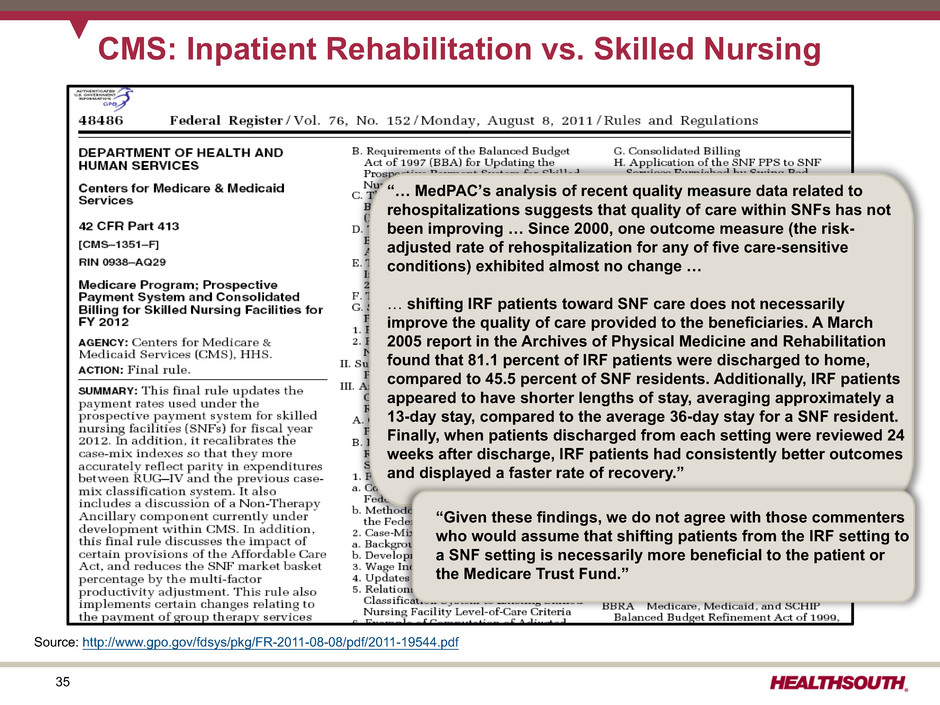
35 CMS: Inpatient Rehabilitation vs. Skilled Nursing Source: http://www.gpo.gov/fdsys/pkg/FR-2011-08-08/pdf/2011-19544.pdf “… MedPAC’s analysis of recent quality measure data related to rehospitalizations suggests that quality of care within SNFs has not been improving … Since 2000, one outcome measure (the risk- adjusted rate of rehospitalization for any of five care-sensitive conditions) exhibited almost no change … … shifting IRF patients toward SNF care does not necessarily improve the quality of care provided to the beneficiaries. A March 2005 report in the Archives of Physical Medicine and Rehabilitation found that 81.1 percent of IRF patients were discharged to home, compared to 45.5 percent of SNF residents. Additionally, IRF patients appeared to have shorter lengths of stay, averaging approximately a 13-day stay, compared to the average 36-day stay for a SNF resident. Finally, when patients discharged from each setting were reviewed 24 weeks after discharge, IRF patients had consistently better outcomes and displayed a faster rate of recovery.” “Given these findings, we do not agree with those commenters who would assume that shifting patients from the IRF setting to a SNF setting is necessarily more beneficial to the patient or the Medicare Trust Fund.”
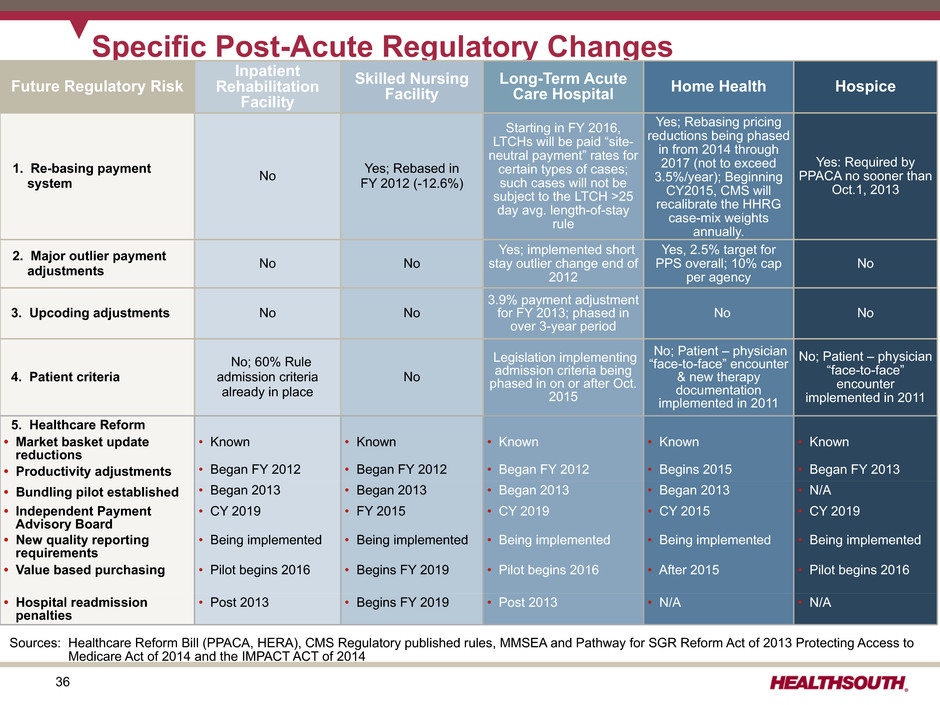
36 Specific Post-Acute Regulatory Changes Future Regulatory Risk Inpatient Rehabilitation Facility Skilled Nursing Facility Long-Term Acute Care Hospital Home Health Hospice 1. Re-basing payment system No Yes; Rebased in FY 2012 (-12.6%) Starting in FY 2016, LTCHs will be paid “site- neutral payment” rates for certain types of cases; such cases will not be subject to the LTCH >25 day avg. length-of-stay rule Yes; Rebasing pricing reductions being phased in from 2014 through 2017 (not to exceed 3.5%/year); Beginning CY2015, CMS will recalibrate the HHRG case-mix weights annually. Yes: Required by PPACA no sooner than Oct.1, 2013 2. Major outlier payment adjustments No No Yes; implemented short stay outlier change end of 2012 Yes, 2.5% target for PPS overall; 10% cap per agency No 3. Upcoding adjustments No No 3.9% payment adjustment for FY 2013; phased in over 3-year period No No 4. Patient criteria No; 60% Rule admission criteria already in place No Legislation implementing admission criteria being phased in on or after Oct. 2015 No; Patient – physician “face-to-face” encounter & new therapy documentation implemented in 2011 No; Patient – physician “face-to-face” encounter implemented in 2011 5. Healthcare Reform • Market basket update reductions • Known • Known • Known • Known • Known • Productivity adjustments • Began FY 2012 • Began FY 2012 • Began FY 2012 • Begins 2015 • Began FY 2013 • Bundling pilot established • Began 2013 • Began 2013 • Began 2013 • Began 2013 • N/A • Independent Payment Advisory Board • CY 2019 • FY 2015 • CY 2019 • CY 2015 • CY 2019 • New quality reporting requirements • Being implemented • Being implemented • Being implemented • Being implemented • Being implemented • Value based purchasing • Pilot begins 2016 • Begins FY 2019 • Pilot begins 2016 • After 2015 • Pilot begins 2016 • Hospital readmission penalties • Post 2013 • Begins FY 2019 • Post 2013 • N/A • N/A Sources: Healthcare Reform Bill (PPACA, HERA), CMS Regulatory published rules, MMSEA and Pathway for SGR Reform Act of 2013 Protecting Access to Medicare Act of 2014 and the IMPACT ACT of 2014
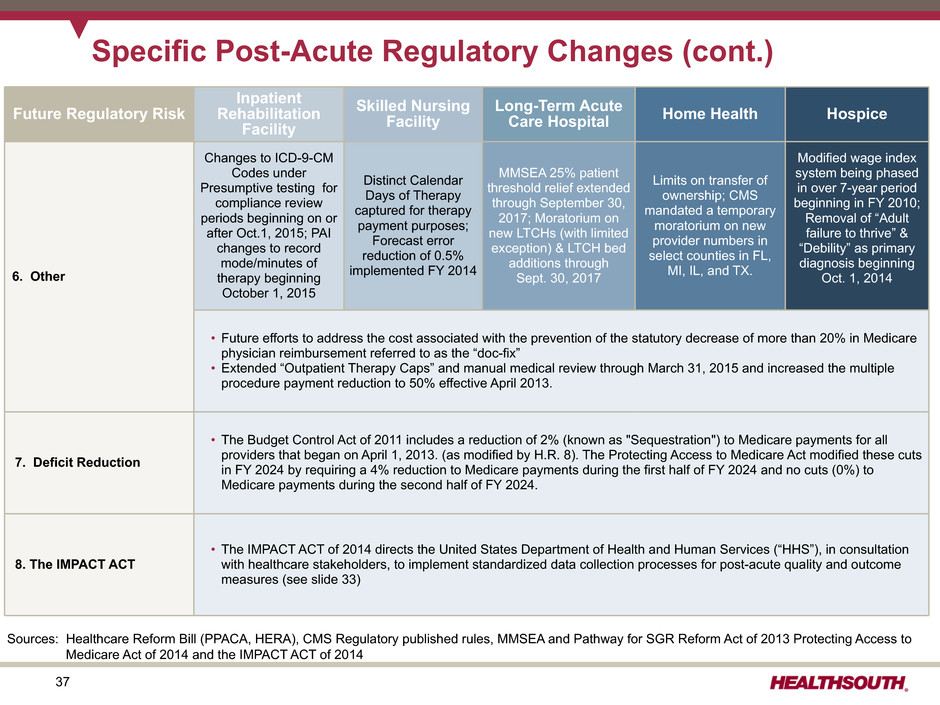
37 Future Regulatory Risk Inpatient Rehabilitation Facility Skilled Nursing Facility Long-Term Acute Care Hospital Home Health Hospice 6. Other Changes to ICD-9-CM Codes under Presumptive testing for compliance review periods beginning on or after Oct.1, 2015; PAI changes to record mode/minutes of therapy beginning October 1, 2015 Distinct Calendar Days of Therapy captured for therapy payment purposes; Forecast error reduction of 0.5% implemented FY 2014 MMSEA 25% patient threshold relief extended through September 30, 2017; Moratorium on new LTCHs (with limited exception) & LTCH bed additions through Sept. 30, 2017 Limits on transfer of ownership; CMS mandated a temporary moratorium on new provider numbers in select counties in FL, MI, IL, and TX. Modified wage index system being phased in over 7-year period beginning in FY 2010; Removal of “Adult failure to thrive” & “Debility” as primary diagnosis beginning Oct. 1, 2014 • Future efforts to address the cost associated with the prevention of the statutory decrease of more than 20% in Medicare physician reimbursement referred to as the “doc-fix” • Extended “Outpatient Therapy Caps” and manual medical review through March 31, 2015 and increased the multiple procedure payment reduction to 50% effective April 2013. 7. Deficit Reduction • The Budget Control Act of 2011 includes a reduction of 2% (known as "Sequestration") to Medicare payments for all providers that began on April 1, 2013. (as modified by H.R. 8). The Protecting Access to Medicare Act modified these cuts in FY 2024 by requiring a 4% reduction to Medicare payments during the first half of FY 2024 and no cuts (0%) to Medicare payments during the second half of FY 2024. 8. The IMPACT ACT • The IMPACT ACT of 2014 directs the United States Department of Health and Human Services (“HHS”), in consultation with healthcare stakeholders, to implement standardized data collection processes for post-acute quality and outcome measures (see slide 33) Specific Post-Acute Regulatory Changes (cont.) Sources: Healthcare Reform Bill (PPACA, HERA), CMS Regulatory published rules, MMSEA and Pathway for SGR Reform Act of 2013 Protecting Access to Medicare Act of 2014 and the IMPACT ACT of 2014
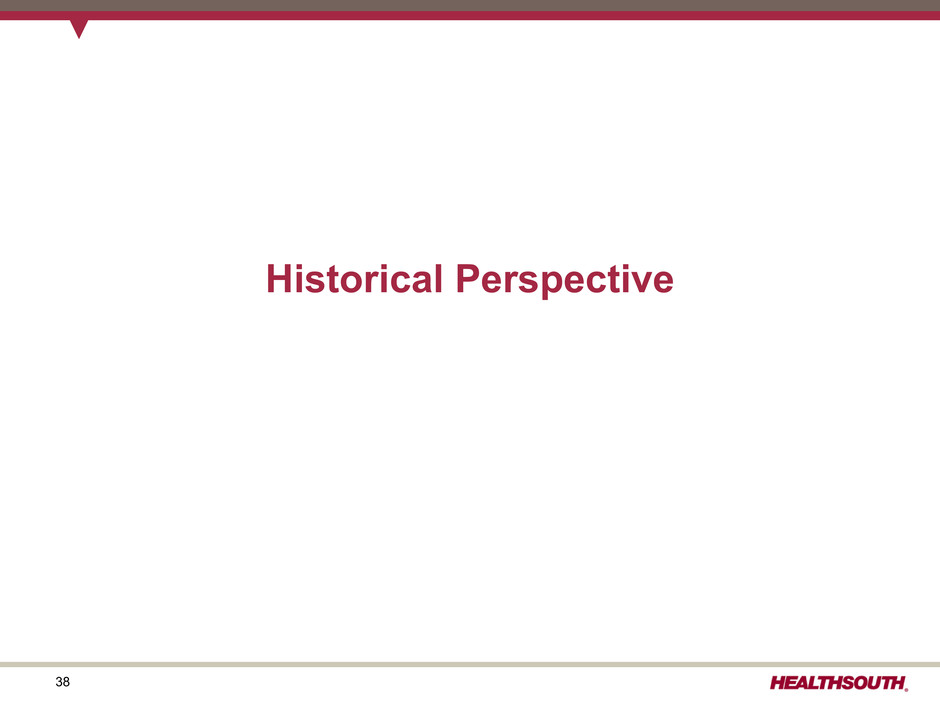
38 Historical Perspective
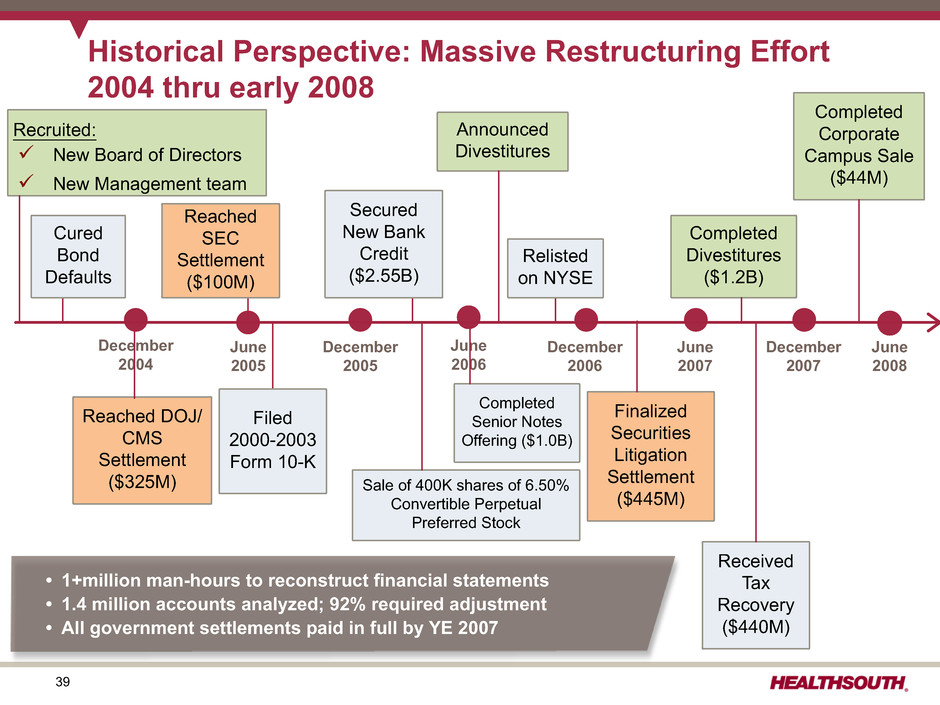
39 Historical Perspective: Massive Restructuring Effort 2004 thru early 2008 December 2004 June 2005 December 2005 June 2006 December 2006 June 2007 December 2007 Received Tax Recovery ($440M) June 2008 Reached DOJ/ CMS Settlement ($325M) Filed 2000-2003 Form 10-K Completed Senior Notes Offering ($1.0B) Announced Divestitures Finalized Securities Litigation Settlement ($445M) Completed Corporate Campus Sale ($44M) Cured Bond Defaults Secured New Bank Credit ($2.55B) Reached SEC Settlement ($100M) Completed Divestitures ($1.2B) Recruited: ü New Board of Directors ü New Management team Sale of 400K shares of 6.50% Convertible Perpetual Preferred Stock Relisted on NYSE • 1+million man-hours to reconstruct financial statements • 1.4 million accounts analyzed; 92% required adjustment • All government settlements paid in full by YE 2007
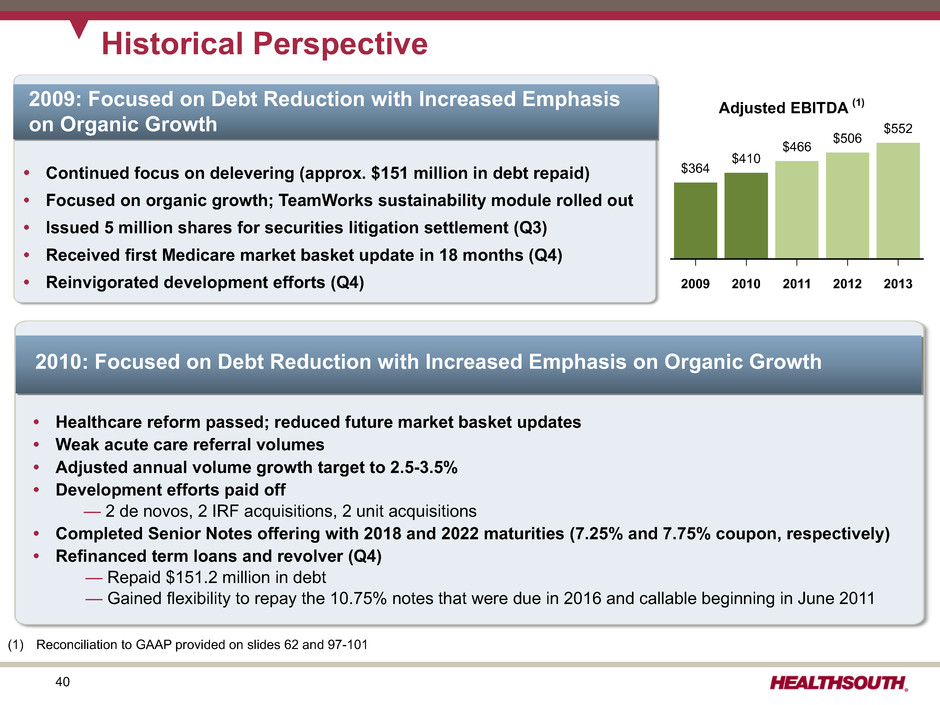
40 • Continued focus on delevering (approx. $151 million in debt repaid) • Focused on organic growth; TeamWorks sustainability module rolled out • Issued 5 million shares for securities litigation settlement (Q3) • Received first Medicare market basket update in 18 months (Q4) • Reinvigorated development efforts (Q4) • Healthcare reform passed; reduced future market basket updates • Weak acute care referral volumes • Adjusted annual volume growth target to 2.5-3.5% • Development efforts paid off — 2 de novos, 2 IRF acquisitions, 2 unit acquisitions • Completed Senior Notes offering with 2018 and 2022 maturities (7.25% and 7.75% coupon, respectively) • Refinanced term loans and revolver (Q4) — Repaid $151.2 million in debt — Gained flexibility to repay the 10.75% notes that were due in 2016 and callable beginning in June 2011 Historical Perspective 2009 2010 2011 2012 2013 $364 $410 $466 $506 $552 Adjusted EBITDA (1) 2010: Focused on Debt Reduction with Increased Emphasis on Organic Growth 2009: Focused on Debt Reduction with Increased Emphasis on Organic Growth (1) Reconciliation to GAAP provided on slides 62 and 97-101

41 $200 $150 $100 $50 Q111 Q211 Q311 Q411 Q112 Q212 Q312 Q412 Q113 Q213 Q313 Q413 Q114 Q214 Q314 Historical Perspective YOY Growth 13.8 % (millions) (1) The Budget Control Act of 2011 included a reduction of up to 2% to Medicare payments for all providers that began on April 1, 2013 (as modified by H.R. 8). The reduction was made from whatever level of payment would otherwise have been provided under Medicare law and regulation. (2) Reconciliation to GAAP provided on slides 62, 96-99, and 101 2011 Adjusted EBITDA (2) = $466.2 2011: Focused on Accelerating Organic Growth and Deployment of Free Cash Flow • Grew volumes 5.2% • Sold five long-term acute care hospitals (LTCHs); closed remaining LTCH • Raised $122 million by reopening 2018 and 2022 Senior Notes • Retired approx. $501 million of 10.75% Senior Notes due 2016 • Opened one de novo (Cypress); acquired Drake; received approval for two CONs • Slowed development efforts due to regulatory uncertainty; reinstated development efforts once the BCA (1) outcome was known.
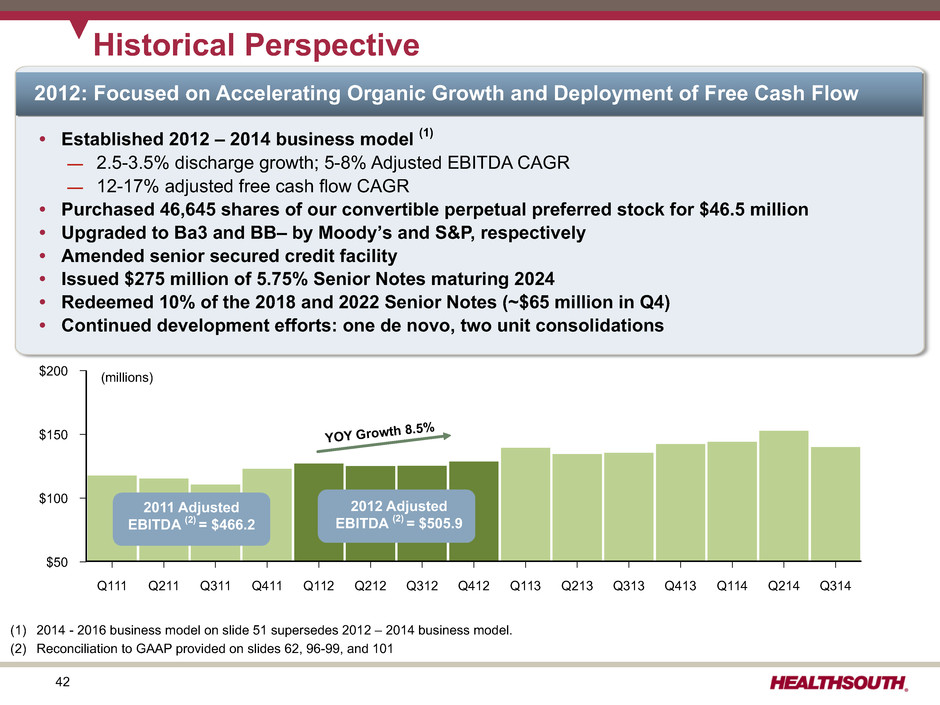
42 $200 $150 $100 $50 Q111 Q211 Q311 Q411 Q112 Q212 Q312 Q412 Q113 Q213 Q313 Q413 Q114 Q214 Q314 Historical Perspective YOY Growth 8.5 % (1) 2014 - 2016 business model on slide 51 supersedes 2012 – 2014 business model. (2) Reconciliation to GAAP provided on slides 62, 96-99, and 101 (millions) 2011 Adjusted EBITDA (2) = $466.2 2012 Adjusted EBITDA (2) = $505.9 2012: Focused on Accelerating Organic Growth and Deployment of Free Cash Flow • Established 2012 – 2014 business model (1) — 2.5-3.5% discharge growth; 5-8% Adjusted EBITDA CAGR — 12-17% adjusted free cash flow CAGR • Purchased 46,645 shares of our convertible perpetual preferred stock for $46.5 million • Upgraded to Ba3 and BB– by Moody’s and S&P, respectively • Amended senior secured credit facility • Issued $275 million of 5.75% Senior Notes maturing 2024 • Redeemed 10% of the 2018 and 2022 Senior Notes (~$65 million in Q4) • Continued development efforts: one de novo, two unit consolidations
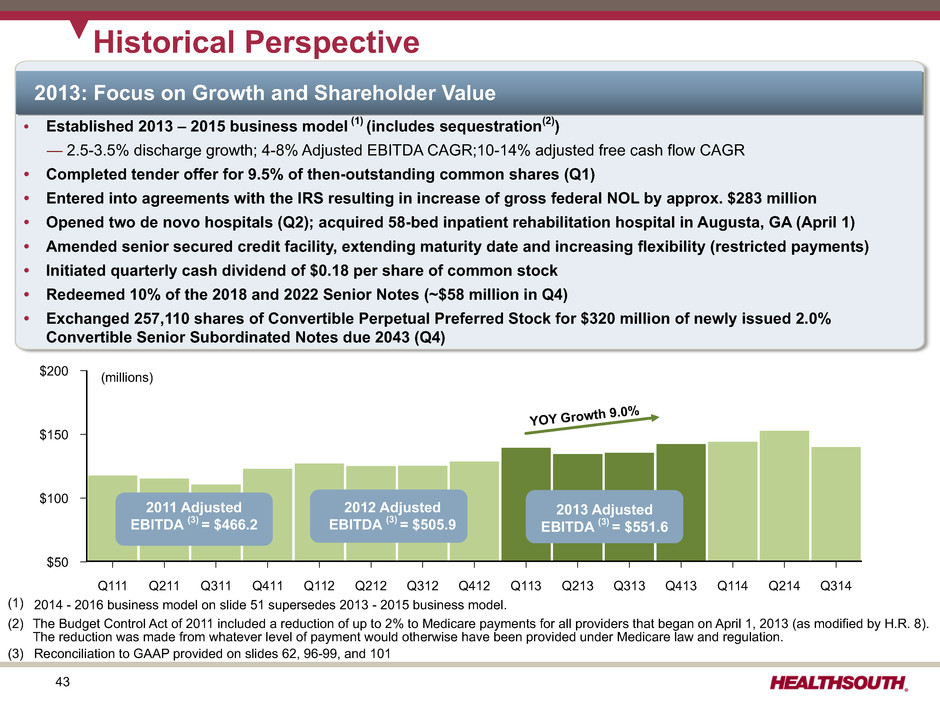
43 $200 $150 $100 $50 Q111 Q211 Q311 Q411 Q112 Q212 Q312 Q412 Q113 Q213 Q313 Q413 Q114 Q214 Q314 Historical Perspective (1) 2014 - 2016 business model on slide 51 supersedes 2013 - 2015 business model. (2) The Budget Control Act of 2011 included a reduction of up to 2% to Medicare payments for all providers that began on April 1, 2013 (as modified by H.R. 8). The reduction was made from whatever level of payment would otherwise have been provided under Medicare law and regulation. (3) Reconciliation to GAAP provided on slides 62, 96-99, and 101 YOY Growth 9.0 % (millions) 2011 Adjusted EBITDA (3) = $466.2 2012 Adjusted EBITDA (3) = $505.9 2013 Adjusted EBITDA (3) = $551.6 2013: Focus on Growth and Shareholder Value • Established 2013 – 2015 business model (1) (includes sequestration(2)) — 2.5-3.5% discharge growth; 4-8% Adjusted EBITDA CAGR;10-14% adjusted free cash flow CAGR • Completed tender offer for 9.5% of then-outstanding common shares (Q1) • Entered into agreements with the IRS resulting in increase of gross federal NOL by approx. $283 million • Opened two de novo hospitals (Q2); acquired 58-bed inpatient rehabilitation hospital in Augusta, GA (April 1) • Amended senior secured credit facility, extending maturity date and increasing flexibility (restricted payments) • Initiated quarterly cash dividend of $0.18 per share of common stock • Redeemed 10% of the 2018 and 2022 Senior Notes (~$58 million in Q4) • Exchanged 257,110 shares of Convertible Perpetual Preferred Stock for $320 million of newly issued 2.0% Convertible Senior Subordinated Notes due 2043 (Q4)
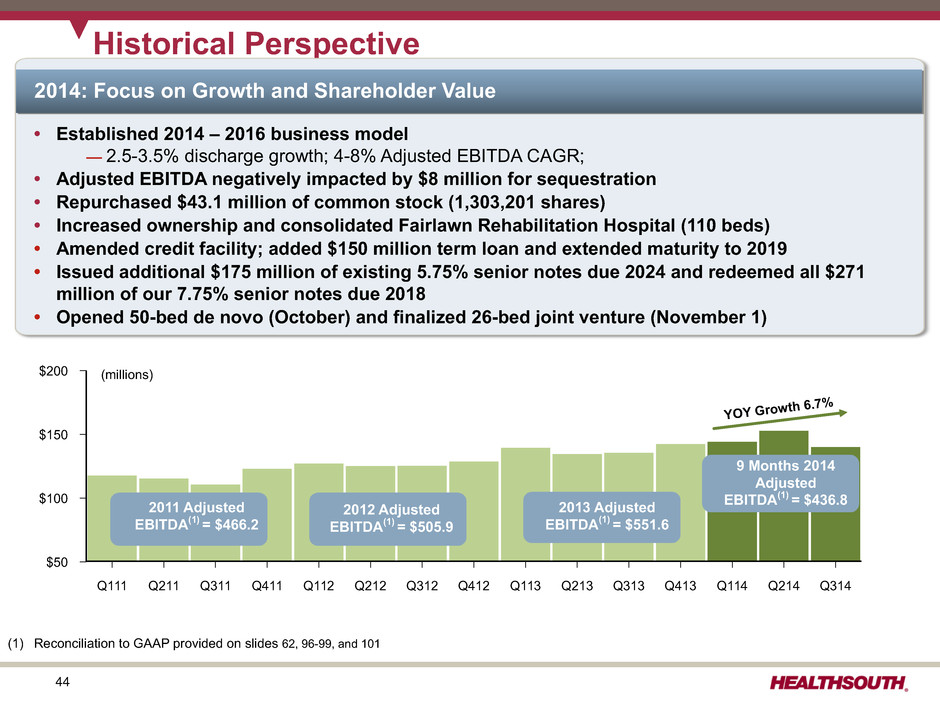
44 $200 $150 $100 $50 Q111 Q211 Q311 Q411 Q112 Q212 Q312 Q412 Q113 Q213 Q313 Q413 Q114 Q214 Q314 Historical Perspective (1) Reconciliation to GAAP provided on slides 62, 96-99, and 101 YOY Growth 6.7 % (millions) 2011 Adjusted EBITDA(1) = $466.2 2012 Adjusted EBITDA(1) = $505.9 2013 Adjusted EBITDA(1) = $551.6 9 Months 2014 Adjusted EBITDA(1) = $436.8 2014: Focus on Growth and Shareholder Value • Established 2014 – 2016 business model — 2.5-3.5% discharge growth; 4-8% Adjusted EBITDA CAGR; • Adjusted EBITDA negatively impacted by $8 million for sequestration • Repurchased $43.1 million of common stock (1,303,201 shares) • Increased ownership and consolidated Fairlawn Rehabilitation Hospital (110 beds) • Amended credit facility; added $150 million term loan and extended maturity to 2019 • Issued additional $175 million of existing 5.75% senior notes due 2024 and redeemed all $271 million of our 7.75% senior notes due 2018 • Opened 50-bed de novo (October) and finalized 26-bed joint venture (November 1)
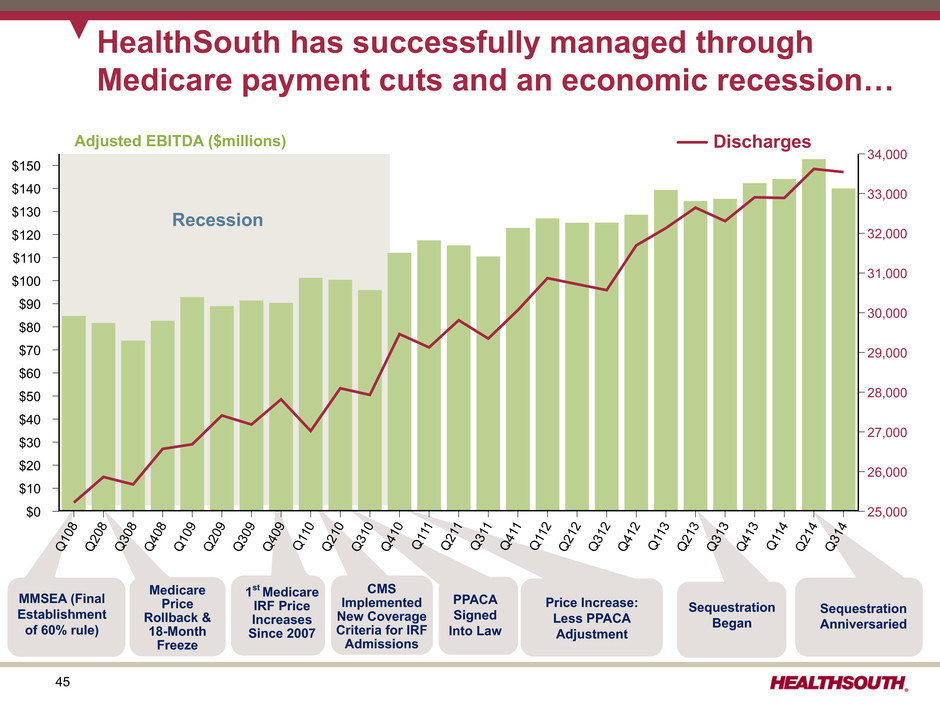
45 HealthSouth has successfully managed through Medicare payment cuts and an economic recession… Recession Adjusted EBITDA ($millions) Discharges Sequestration Anniversaried Sequestration Began Medicare Price Rollback & 18-Month Freeze MMSEA (Final Establishment of 60% rule) 1st Medicare IRF Price Increases Since 2007 CMS Implemented New Coverage Criteria for IRF Admissions PPACA Signed Into Law Price Increase: Less PPACA Adjustment $150 $140 $130 $120 $110 $100 $90 $80 $70 $60 $50 $40 $30 $20 $10 $0 34,000 33,000 32,000 31,000 30,000 29,000 28,000 27,000 26,000 25,000 Q1 08 Q2 08 Q3 08 Q4 08 Q1 09 Q2 09 Q3 09 Q4 09 Q1 10 Q2 10 Q3 10 Q4 10 Q1 11 Q2 11 Q3 11 Q4 11 Q1 12 Q2 12 Q3 12 Q4 12 Q1 13 Q2 13 Q3 13 Q4 13 Q1 14 Q2 14 Q3 14
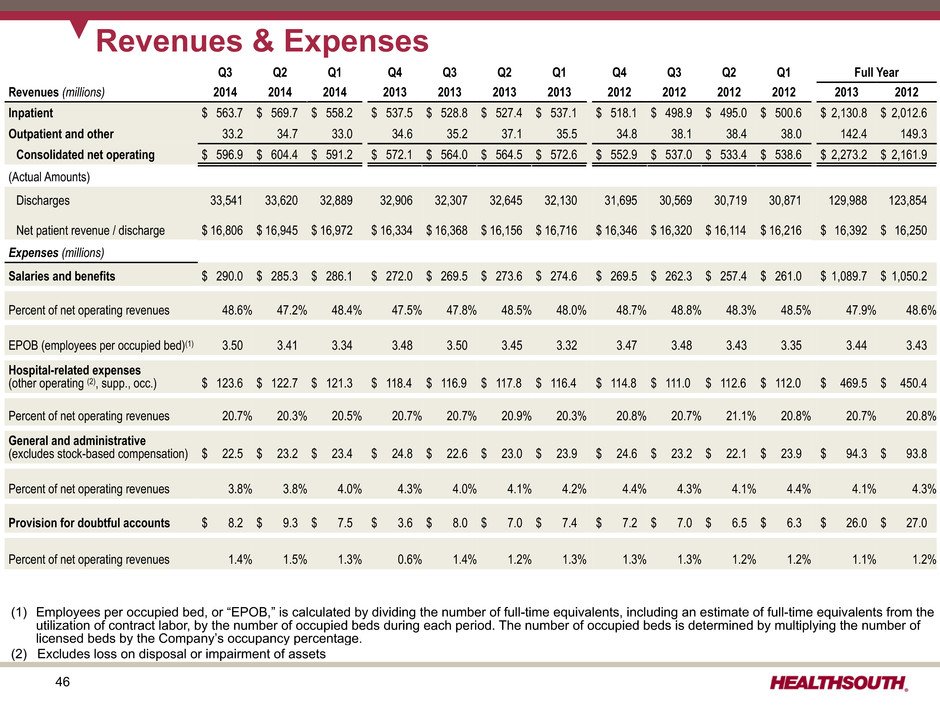
46 Revenues & Expenses Q3 Q2 Q1 Q4 Q3 Q2 Q1 Q4 Q3 Q2 Q1 Full Year Revenues (millions) 2014 2014 2014 2013 2013 2013 2013 2012 2012 2012 2012 2013 2012 Inpatient $ 563.7 $ 569.7 $ 558.2 $ 537.5 $ 528.8 $ 527.4 $ 537.1 $ 518.1 $ 498.9 $ 495.0 $ 500.6 $ 2,130.8 $ 2,012.6 Outpatient and other 33.2 34.7 33.0 34.6 35.2 37.1 35.5 34.8 38.1 38.4 38.0 142.4 149.3 Consolidated net operating $ 596.9 $ 604.4 $ 591.2 $ 572.1 $ 564.0 $ 564.5 $ 572.6 $ 552.9 $ 537.0 $ 533.4 $ 538.6 $ 2,273.2 $ 2,161.9 (Actual Amounts) Discharges 33,541 33,620 32,889 32,906 32,307 32,645 32,130 31,695 30,569 30,719 30,871 129,988 123,854 Net patient revenue / discharge $ 16,806 $ 16,945 $ 16,972 $ 16,334 $ 16,368 $ 16,156 $ 16,716 $ 16,346 $ 16,320 $ 16,114 $ 16,216 $ 16,392 $ 16,250 Expenses (millions) Salaries and benefits $ 290.0 $ 285.3 $ 286.1 $ 272.0 $ 269.5 $ 273.6 $ 274.6 $ 269.5 $ 262.3 $ 257.4 $ 261.0 $ 1,089.7 $ 1,050.2 Percent of net operating revenues 48.6% 47.2% 48.4% 47.5% 47.8% 48.5% 48.0% 48.7% 48.8% 48.3% 48.5% 47.9% 48.6% EPOB (employees per occupied bed)(1) 3.50 3.41 3.34 3.48 3.50 3.45 3.32 3.47 3.48 3.43 3.35 3.44 3.43 Hospital-related expenses (other operating (2), supp., occ.) $ 123.6 $ 122.7 $ 121.3 $ 118.4 $ 116.9 $ 117.8 $ 116.4 $ 114.8 $ 111.0 $ 112.6 $ 112.0 $ 469.5 $ 450.4 Percent of net operating revenues 20.7% 20.3% 20.5% 20.7% 20.7% 20.9% 20.3% 20.8% 20.7% 21.1% 20.8% 20.7% 20.8% General and administrative (excludes stock-based compensation) $ 22.5 $ 23.2 $ 23.4 $ 24.8 $ 22.6 $ 23.0 $ 23.9 $ 24.6 $ 23.2 $ 22.1 $ 23.9 $ 94.3 $ 93.8 Percent of net operating revenues 3.8% 3.8% 4.0% 4.3% 4.0% 4.1% 4.2% 4.4% 4.3% 4.1% 4.4% 4.1% 4.3% Provision for doubtful accounts $ 8.2 $ 9.3 $ 7.5 $ 3.6 $ 8.0 $ 7.0 $ 7.4 $ 7.2 $ 7.0 $ 6.5 $ 6.3 $ 26.0 $ 27.0 Percent of net operating revenues 1.4% 1.5% 1.3% 0.6% 1.4% 1.2% 1.3% 1.3% 1.3% 1.2% 1.2% 1.1% 1.2% (1) Employees per occupied bed, or “EPOB,” is calculated by dividing the number of full-time equivalents, including an estimate of full-time equivalents from the utilization of contract labor, by the number of occupied beds during each period. The number of occupied beds is determined by multiplying the number of licensed beds by the Company’s occupancy percentage. (2) Excludes loss on disposal or impairment of assets
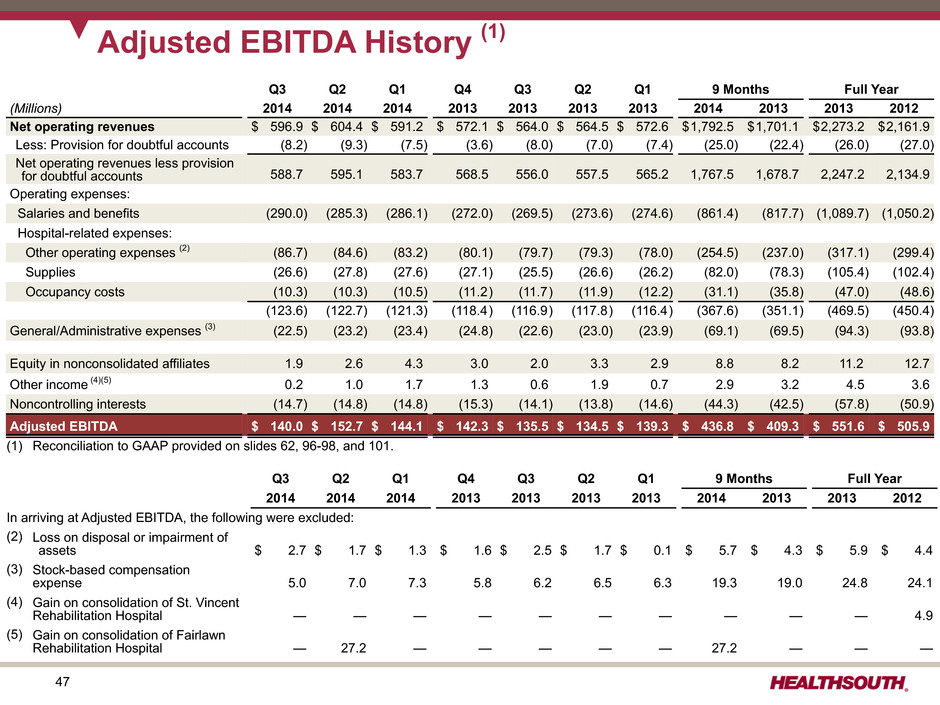
47 Adjusted EBITDA History (1) Q3 Q2 Q1 Q4 Q3 Q2 Q1 9 Months Full Year (Millions) 2014 2014 2014 2013 2013 2013 2013 2014 2013 2013 2012 Net operating revenues $ 596.9 $ 604.4 $ 591.2 $ 572.1 $ 564.0 $ 564.5 $ 572.6 $1,792.5 $1,701.1 $2,273.2 $2,161.9 Less: Provision for doubtful accounts (8.2) (9.3) (7.5) (3.6) (8.0) (7.0) (7.4) (25.0) (22.4) (26.0) (27.0) Net operating revenues less provision for doubtful accounts 588.7 595.1 583.7 568.5 556.0 557.5 565.2 1,767.5 1,678.7 2,247.2 2,134.9 Operating expenses: Salaries and benefits (290.0) (285.3) (286.1) (272.0) (269.5) (273.6) (274.6) (861.4) (817.7) (1,089.7) (1,050.2) Hospital-related expenses: Other operating expenses (2) (86.7) (84.6) (83.2) (80.1) (79.7) (79.3) (78.0) (254.5) (237.0) (317.1) (299.4) Supplies (26.6) (27.8) (27.6) (27.1) (25.5) (26.6) (26.2) (82.0) (78.3) (105.4) (102.4) Occupancy costs (10.3) (10.3) (10.5) (11.2) (11.7) (11.9) (12.2) (31.1) (35.8) (47.0) (48.6) (123.6) (122.7) (121.3) (118.4) (116.9) (117.8) (116.4) (367.6) (351.1) (469.5) (450.4) General/Administrative expenses (3) (22.5) (23.2) (23.4) (24.8) (22.6) (23.0) (23.9) (69.1) (69.5) (94.3) (93.8) Equity in nonconsolidated affiliates 1.9 2.6 4.3 3.0 2.0 3.3 2.9 8.8 8.2 11.2 12.7 Other income (4)(5) 0.2 1.0 1.7 1.3 0.6 1.9 0.7 2.9 3.2 4.5 3.6 Noncontrolling interests (14.7) (14.8) (14.8) (15.3) (14.1) (13.8) (14.6) (44.3) (42.5) (57.8) (50.9) Adjusted EBITDA $ 140.0 $ 152.7 $ 144.1 $ 142.3 $ 135.5 $ 134.5 $ 139.3 $ 436.8 $ 409.3 $ 551.6 $ 505.9 (1) Reconciliation to GAAP provided on slides 62, 96-98, and 101. Q3 Q2 Q1 Q4 Q3 Q2 Q1 9 Months Full Year 2014 2014 2014 2013 2013 2013 2013 2014 2013 2013 2012 In arriving at Adjusted EBITDA, the following were excluded: (2) Loss on disposal or impairment of assets $ 2.7 $ 1.7 $ 1.3 $ 1.6 $ 2.5 $ 1.7 $ 0.1 $ 5.7 $ 4.3 $ 5.9 $ 4.4 (3) Stock-based compensation expense 5.0 7.0 7.3 5.8 6.2 6.5 6.3 19.3 19.0 24.8 24.1 (4) Gain on consolidation of St. Vincent Rehabilitation Hospital — — — — — — — — — — 4.9 (5) Gain on consolidation of Fairlawn Rehabilitation Hospital — 27.2 — — — — — 27.2 — — —

48 Outstanding Share Summary, Warrant Information, Conversion Price (1)(2)(3)(4) – Notes on slide 49 Weighted Average for the Period Q3 9 months Full Year (Millions) 2014 2013 2014 2013 2013 2012 2011 2010 2009 Basic shares outstanding (1) (2) (3) 86.5 86.2 86.8 88.7 88.1 94.6 93.3 92.8 88.8 Diluted shares outstanding (1) (2) (3) (4) 100.5 100.4 100.7 102.4 102.1 108.1 109.2 108.5 103.3 End of Period Q3 9 months Full Year (Millions) 2014 2013 2014 2013 2013 2012 2011 Basic shares outstanding (1) (2) (3) 86.5 86.3 86.5 86.3 86.8 94.6 93.3 Convertible perpetual preferred stock(4) 0.096 0.353 0.096 0.353 0.096 0.353 0.400 If converted, equivalent common shares 3.2 11.6 3.2 11.6 3.2 11.6 13.1 Convertible senior subordinated notes(4) $320.0 — $320.0 — $320.0 — — If converted, equivalent common shares 8.2 — 8.1 — 8.1 — — Approx. Approx. Date Conversion Rates Conversion Price Convertible perpetual preferred stock 10/2/2014 33.6700 $29.70 Convertible senior subordinated notes 10/2/2014 25.7582 $38.82
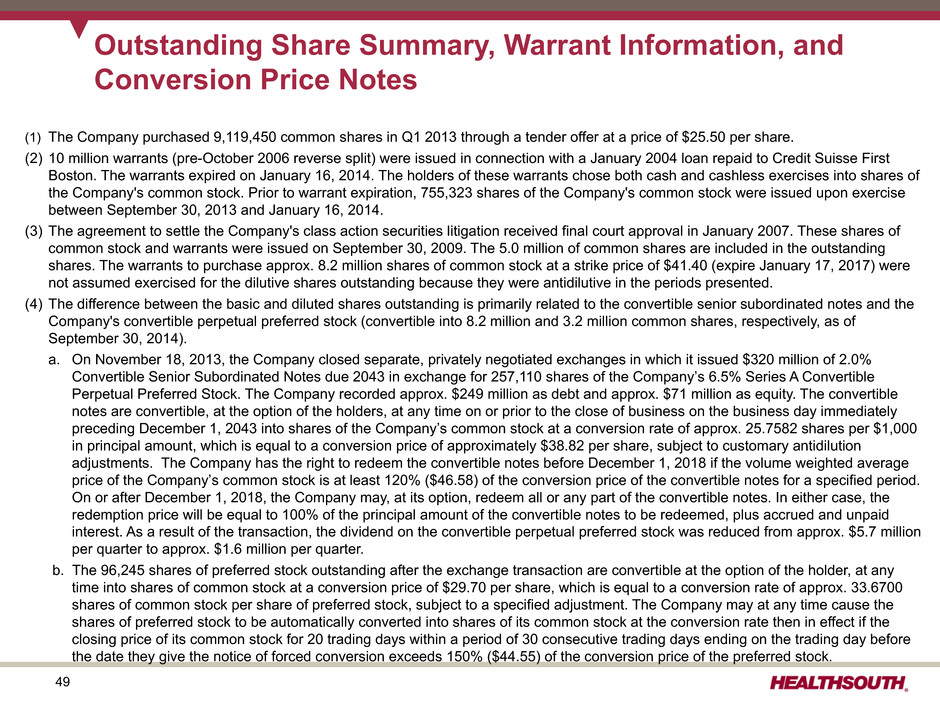
49 Outstanding Share Summary, Warrant Information, and Conversion Price Notes (1) The Company purchased 9,119,450 common shares in Q1 2013 through a tender offer at a price of $25.50 per share. (2) 10 million warrants (pre-October 2006 reverse split) were issued in connection with a January 2004 loan repaid to Credit Suisse First Boston. The warrants expired on January 16, 2014. The holders of these warrants chose both cash and cashless exercises into shares of the Company's common stock. Prior to warrant expiration, 755,323 shares of the Company's common stock were issued upon exercise between September 30, 2013 and January 16, 2014. (3) The agreement to settle the Company's class action securities litigation received final court approval in January 2007. These shares of common stock and warrants were issued on September 30, 2009. The 5.0 million of common shares are included in the outstanding shares. The warrants to purchase approx. 8.2 million shares of common stock at a strike price of $41.40 (expire January 17, 2017) were not assumed exercised for the dilutive shares outstanding because they were antidilutive in the periods presented. (4) The difference between the basic and diluted shares outstanding is primarily related to the convertible senior subordinated notes and the Company's convertible perpetual preferred stock (convertible into 8.2 million and 3.2 million common shares, respectively, as of September 30, 2014). a. On November 18, 2013, the Company closed separate, privately negotiated exchanges in which it issued $320 million of 2.0% Convertible Senior Subordinated Notes due 2043 in exchange for 257,110 shares of the Company’s 6.5% Series A Convertible Perpetual Preferred Stock. The Company recorded approx. $249 million as debt and approx. $71 million as equity. The convertible notes are convertible, at the option of the holders, at any time on or prior to the close of business on the business day immediately preceding December 1, 2043 into shares of the Company’s common stock at a conversion rate of approx. 25.7582 shares per $1,000 in principal amount, which is equal to a conversion price of approximately $38.82 per share, subject to customary antidilution adjustments. The Company has the right to redeem the convertible notes before December 1, 2018 if the volume weighted average price of the Company’s common stock is at least 120% ($46.58) of the conversion price of the convertible notes for a specified period. On or after December 1, 2018, the Company may, at its option, redeem all or any part of the convertible notes. In either case, the redemption price will be equal to 100% of the principal amount of the convertible notes to be redeemed, plus accrued and unpaid interest. As a result of the transaction, the dividend on the convertible perpetual preferred stock was reduced from approx. $5.7 million per quarter to approx. $1.6 million per quarter. b. The 96,245 shares of preferred stock outstanding after the exchange transaction are convertible at the option of the holder, at any time into shares of common stock at a conversion price of $29.70 per share, which is equal to a conversion rate of approx. 33.6700 shares of common stock per share of preferred stock, subject to a specified adjustment. The Company may at any time cause the shares of preferred stock to be automatically converted into shares of its common stock at the conversion rate then in effect if the closing price of its common stock for 20 trading days within a period of 30 consecutive trading days ending on the trading day before the date they give the notice of forced conversion exceeds 150% ($44.55) of the conversion price of the preferred stock.
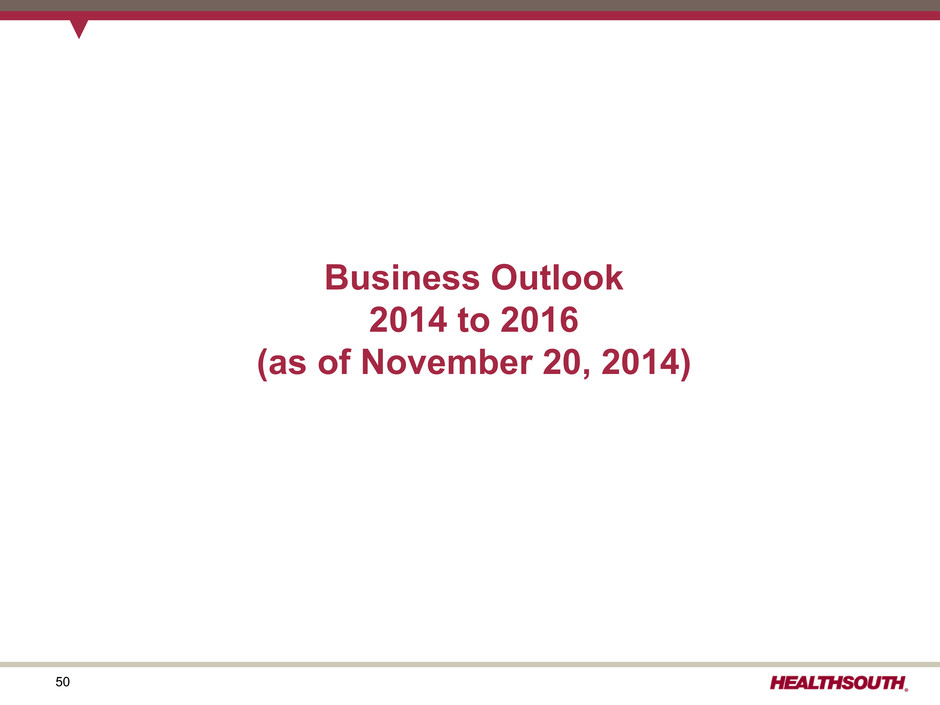
50 Business Outlook 2014 to 2016 (as of November 20, 2014)
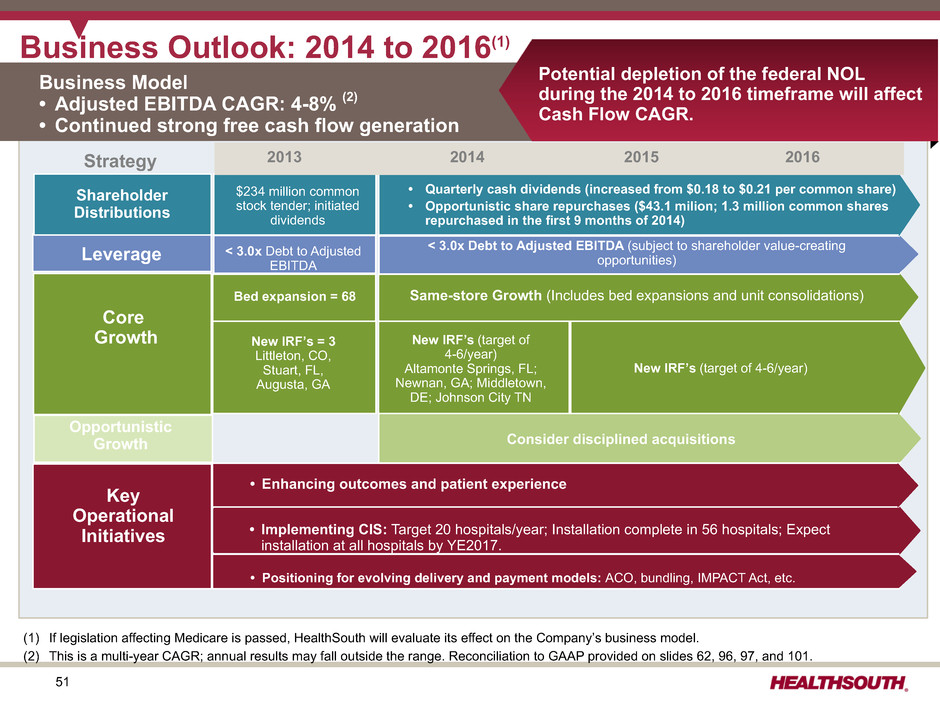
51 (1) If legislation affecting Medicare is passed, HealthSouth will evaluate its effect on the Company’s business model. (2) This is a multi-year CAGR; annual results may fall outside the range. Reconciliation to GAAP provided on slides 62, 96, 97, and 101. Strategy Key Operational Initiatives Potential depletion of the federal NOL during the 2014 to 2016 timeframe will affect Cash Flow CAGR. New IRF’s (target of 4-6/year) Shareholder Distributions $234 million common stock tender; initiated dividends Business Model • Adjusted EBITDA CAGR: 4-8% (2) • Continued strong free cash flow generation Business Outlook: 2014 to 2016(1) • Quarterly cash dividends (increased from $0.18 to $0.21 per common share) • Opportunistic share repurchases ($43.1 milion; 1.3 million common shares repurchased in the first 9 months of 2014) Leverage < 3.0x Debt to Adjusted EBITDA < 3.0x Debt to Adjusted EBITDA (subject to shareholder value-creating opportunities) Core Growth Bed expansion = 68 New IRF’s = 3 Littleton, CO, Stuart, FL, Augusta, GA New IRF’s (target of 4-6/year) Altamonte Springs, FL; Newnan, GA; Middletown, DE; Johnson City TN Opportunistic Growth Consider disciplined acquisitions • Enhancing outcomes and patient experience • Implementing CIS: Target 20 hospitals/year; Installation complete in 56 hospitals; Expect installation at all hospitals by YE2017. • Positioning for evolving delivery and payment models: ACO, bundling, IMPACT Act, etc. Same-store Growth (Includes bed expansions and unit consolidations) 2013 2014 2015 2016
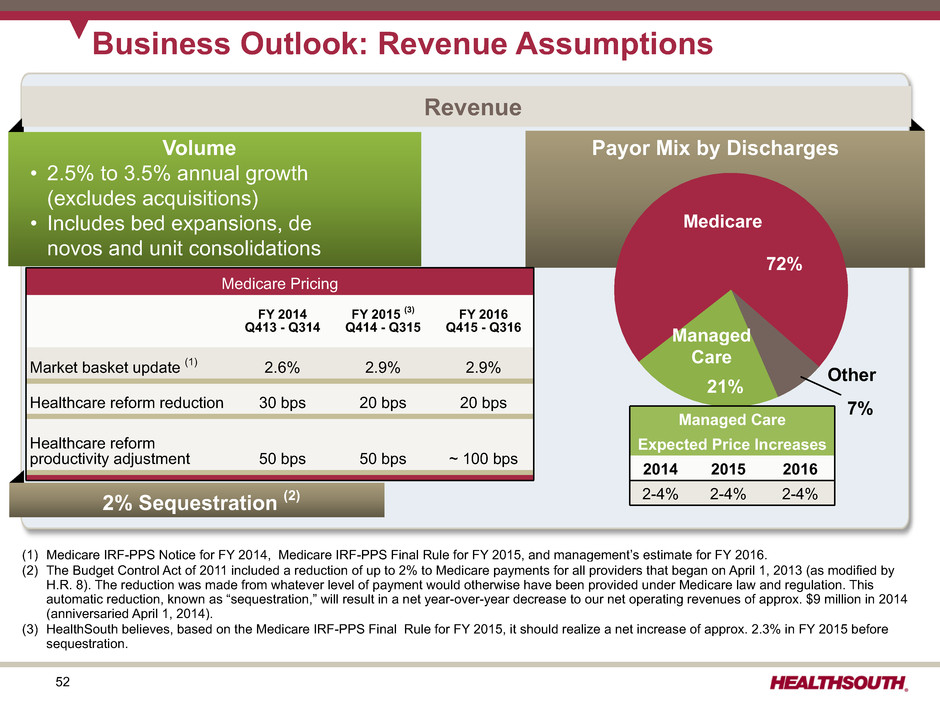
52 Business Outlook: Revenue Assumptions Volume • 2.5% to 3.5% annual growth (excludes acquisitions) • Includes bed expansions, de novos and unit consolidations 2% Sequestration (2) Medicare Pricing FY 2014 Q413 - Q314 FY 2015 (3) Q414 - Q315 FY 2016 Q415 - Q316 Market basket update (1) 2.6% 2.9% 2.9% Healthcare reform reduction 30 bps 20 bps 20 bps Healthcare reform productivity adjustment 50 bps 50 bps ~ 100 bps Payor Mix by Discharges Managed Care Medicare 72% 21% Other 7%Managed Care Expected Price Increases 2014 2015 2016 2-4% 2-4% 2-4% (1) Medicare IRF-PPS Notice for FY 2014, Medicare IRF-PPS Final Rule for FY 2015, and management’s estimate for FY 2016. (2) The Budget Control Act of 2011 included a reduction of up to 2% to Medicare payments for all providers that began on April 1, 2013 (as modified by H.R. 8). The reduction was made from whatever level of payment would otherwise have been provided under Medicare law and regulation. This automatic reduction, known as “sequestration,” will result in a net year-over-year decrease to our net operating revenues of approx. $9 million in 2014 (anniversaried April 1, 2014). (3) HealthSouth believes, based on the Medicare IRF-PPS Final Rule for FY 2015, it should realize a net increase of approx. 2.3% in FY 2015 before sequestration. Revenue
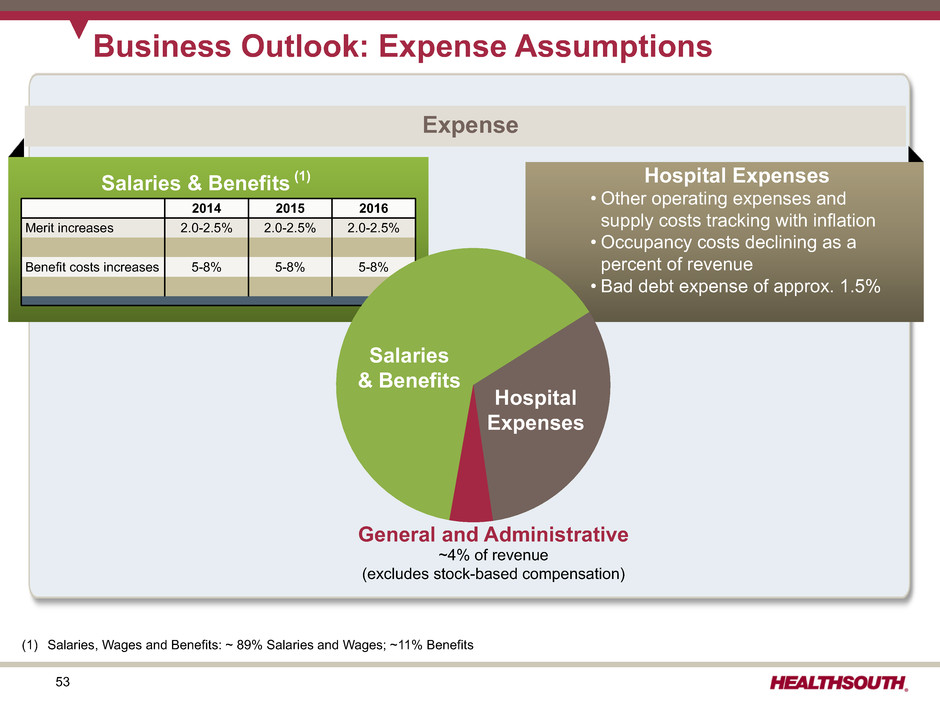
53 Business Outlook: Expense Assumptions General and Administrative ~4% of revenue (excludes stock-based compensation) Expense Salaries & Benefits (1) 2014 2015 2016 Merit increases 2.0-2.5% 2.0-2.5% 2.0-2.5% Benefit costs increases 5-8% 5-8% 5-8% Hospital Expenses • Other operating expenses and supply costs tracking with inflation • Occupancy costs declining as a percent of revenue • Bad debt expense of approx. 1.5% Salaries & Benefits Hospital Expenses (1) Salaries, Wages and Benefits: ~ 89% Salaries and Wages; ~11% Benefits
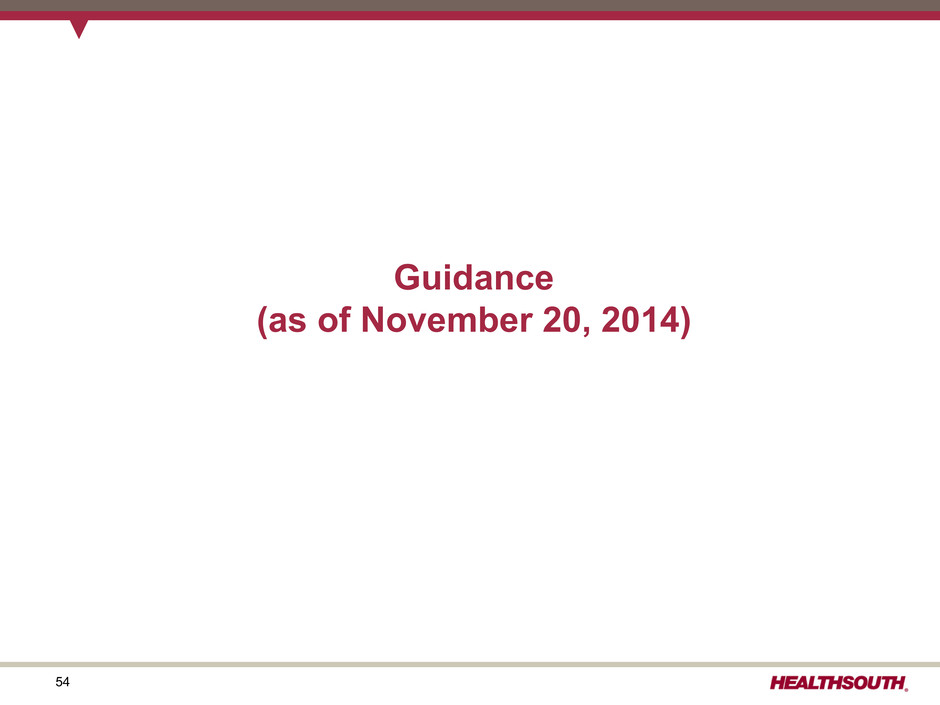
54 Guidance (as of November 20, 2014)
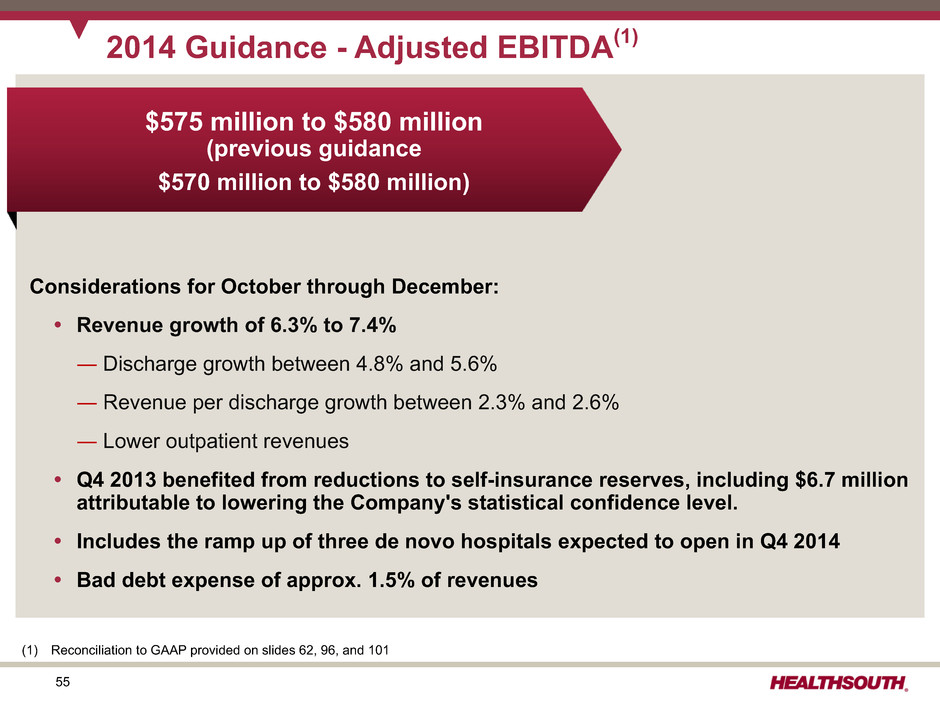
55 2014 Guidance - Adjusted EBITDA(1) Considerations for October through December: Ÿ Revenue growth of 6.3% to 7.4% ― Discharge growth between 4.8% and 5.6% ― Revenue per discharge growth between 2.3% and 2.6% ― Lower outpatient revenues Ÿ Q4 2013 benefited from reductions to self-insurance reserves, including $6.7 million attributable to lowering the Company's statistical confidence level. Ÿ Includes the ramp up of three de novo hospitals expected to open in Q4 2014 Ÿ Bad debt expense of approx. 1.5% of revenues $575 million to $580 million (previous guidance $570 million to $580 million) (1) Reconciliation to GAAP provided on slides 62, 96, and 101
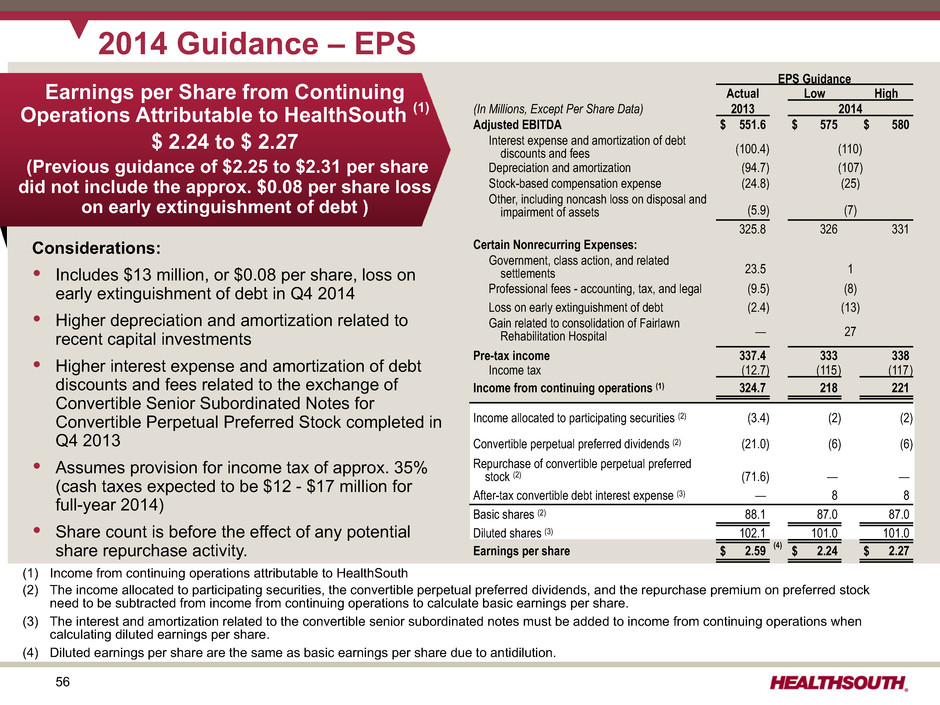
56 2014 Guidance – EPS EPS Guidance Actual Low High (In Millions, Except Per Share Data) 2013 2014 Adjusted EBITDA $ 551.6 $ 575 $ 580 Interest expense and amortization of debt discounts and fees (100.4) (110) Depreciation and amortization (94.7) (107) Stock-based compensation expense (24.8) (25) Other, including noncash loss on disposal and impairment of assets (5.9) (7) 325.8 326 331 Certain Nonrecurring Expenses: Government, class action, and related settlements 23.5 1 Professional fees - accounting, tax, and legal (9.5) (8) Loss on early extinguishment of debt (2.4) (13) Gain related to consolidation of Fairlawn Rehabilitation Hospital — 27 Pre-tax income 337.4 333 338 Income tax (12.7) (115) (117) Income from continuing operations (1) 324.7 218 221 Income allocated to participating securities (2) (3.4) (2) (2) Convertible perpetual preferred dividends (2) (21.0) (6) (6) Repurchase of convertible perpetual preferred stock (2) (71.6) — — After-tax convertible debt interest expense (3) — 8 8 Basic shares (2) 88.1 87.0 87.0 Diluted shares (3) 102.1 101.0 101.0 Earnings per share $ 2.59 (4) $ 2.24 $ 2.27 Considerations: Ÿ Includes $13 million, or $0.08 per share, loss on early extinguishment of debt in Q4 2014 Ÿ Higher depreciation and amortization related to recent capital investments Ÿ Higher interest expense and amortization of debt discounts and fees related to the exchange of Convertible Senior Subordinated Notes for Convertible Perpetual Preferred Stock completed in Q4 2013 Ÿ Assumes provision for income tax of approx. 35% (cash taxes expected to be $12 - $17 million for full-year 2014) Ÿ Share count is before the effect of any potential share repurchase activity. Earnings per Share from Continuing Operations Attributable to HealthSouth (1) $ 2.24 to $ 2.27 (Previous guidance of $2.25 to $2.31 per share did not include the approx. $0.08 per share loss on early extinguishment of debt ) (1) Income from continuing operations attributable to HealthSouth (2) The income allocated to participating securities, the convertible perpetual preferred dividends, and the repurchase premium on preferred stock need to be subtracted from income from continuing operations to calculate basic earnings per share. (3) The interest and amortization related to the convertible senior subordinated notes must be added to income from continuing operations when calculating diluted earnings per share. (4) Diluted earnings per share are the same as basic earnings per share due to antidilution.
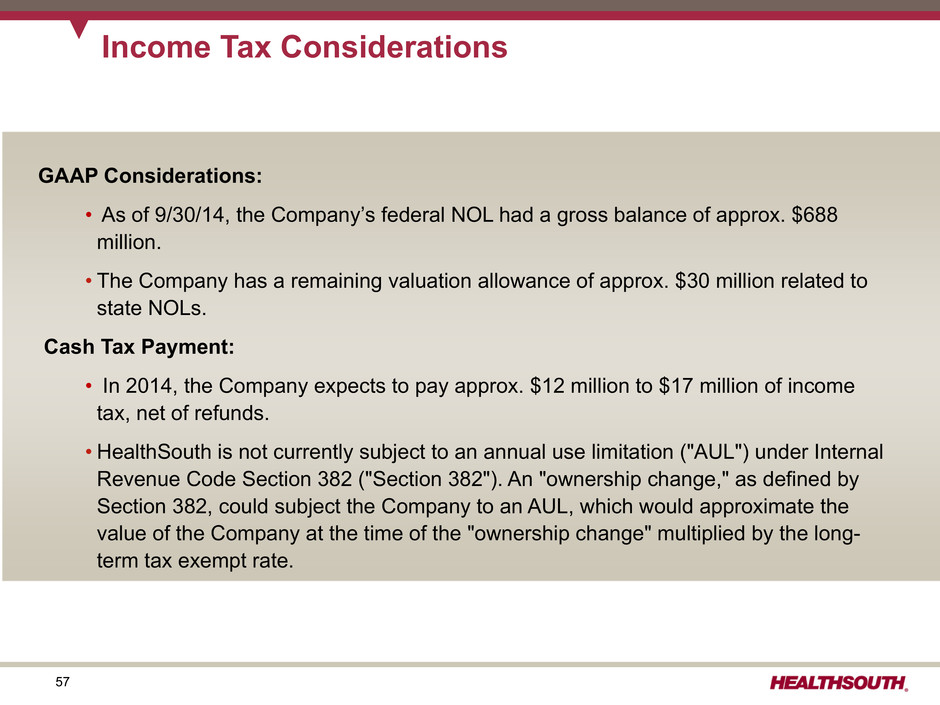
57 Income Tax Considerations GAAP Considerations: • As of 9/30/14, the Company’s federal NOL had a gross balance of approx. $688 million. • The Company has a remaining valuation allowance of approx. $30 million related to state NOLs. Cash Tax Payment: • In 2014, the Company expects to pay approx. $12 million to $17 million of income tax, net of refunds. • HealthSouth is not currently subject to an annual use limitation ("AUL") under Internal Revenue Code Section 382 ("Section 382"). An "ownership change," as defined by Section 382, could subject the Company to an AUL, which would approximate the value of the Company at the time of the "ownership change" multiplied by the long- term tax exempt rate.
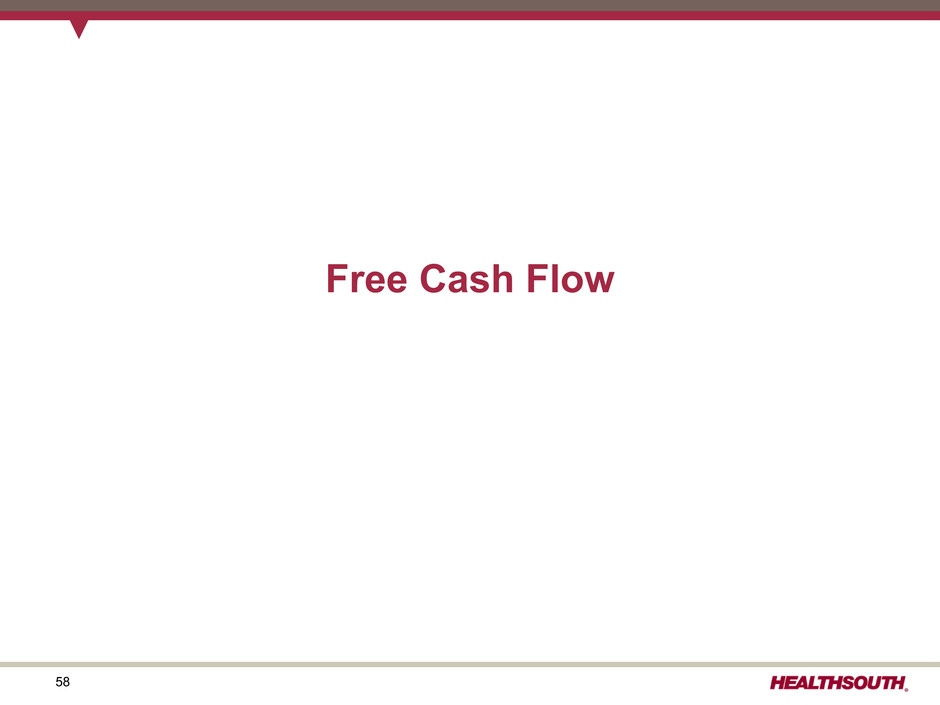
58 Free Cash Flow
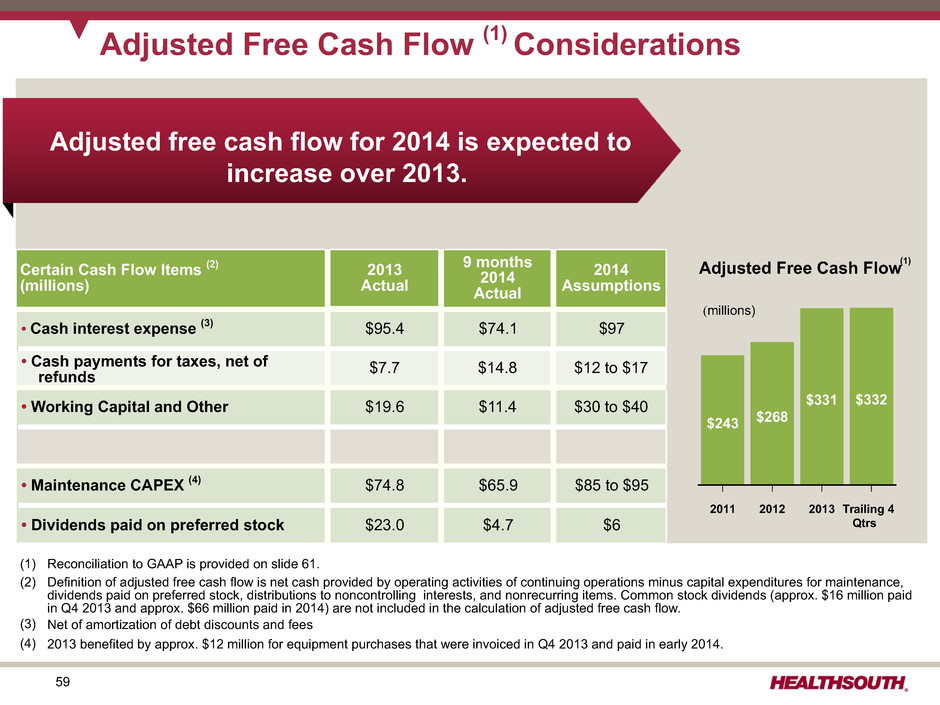
59 (1) Reconciliation to GAAP is provided on slide 61. (2) Definition of adjusted free cash flow is net cash provided by operating activities of continuing operations minus capital expenditures for maintenance, dividends paid on preferred stock, distributions to noncontrolling interests, and nonrecurring items. Common stock dividends (approx. $16 million paid in Q4 2013 and approx. $66 million paid in 2014) are not included in the calculation of adjusted free cash flow. (3) Net of amortization of debt discounts and fees (4) 2013 benefited by approx. $12 million for equipment purchases that were invoiced in Q4 2013 and paid in early 2014. Adjusted Free Cash Flow (1) Considerations Certain Cash Flow Items (2) (millions) 2013 Actual 9 months 2014 Actual 2014 Assumptions • Cash interest expense (3) $95.4 $74.1 $97 • Cash payments for taxes, net of refunds $7.7 $14.8 $12 to $17 • Working Capital and Other $19.6 $11.4 $30 to $40 • Maintenance CAPEX (4) $74.8 $65.9 $85 to $95 • Dividends paid on preferred stock $23.0 $4.7 $6 Adjusted free cash flow for 2014 is expected to increase over 2013. Adjusted Free Cash Flow 2011 2012 2013 Trailing 4 Qtrs $243 $268 $331 $332 (1) (millions)
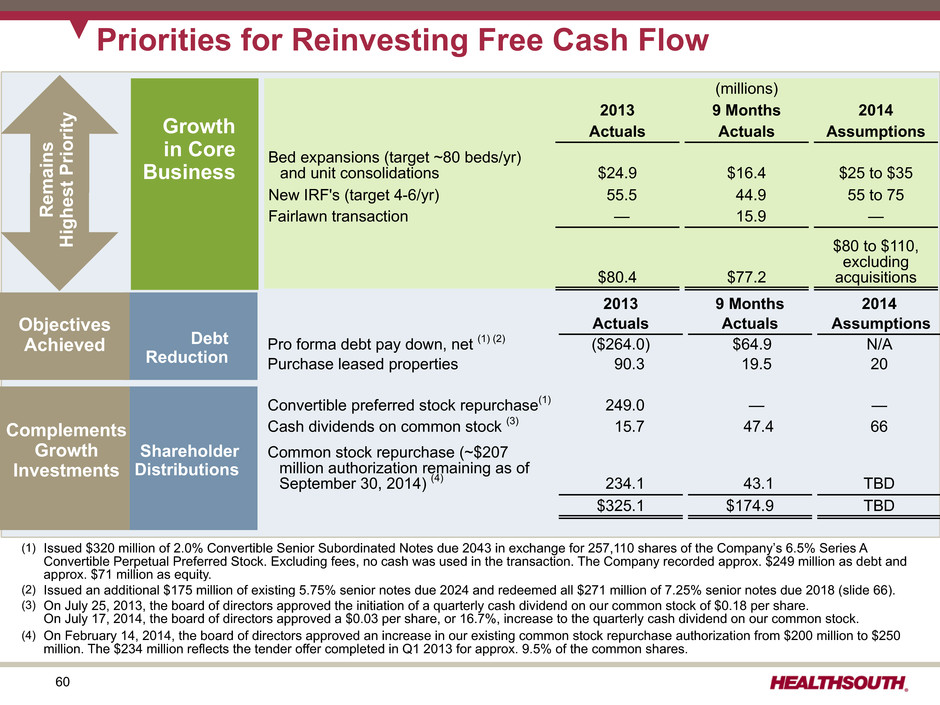
60 Priorities for Reinvesting Free Cash Flow Objectives Achieved «« Remain s Highest Priorit y (millions) 2013 9 Months 2014 Actuals Actuals Assumptions Bed expansions (target ~80 beds/yr) and unit consolidations $24.9 $16.4 $25 to $35 New IRF's (target 4-6/yr) 55.5 44.9 55 to 75 Fairlawn transaction — 15.9 — $80.4 $77.2 $80 to $110, excluding acquisitions 2013 9 Months 2014 Actuals Actuals Assumptions Pro forma debt pay down, net (1) (2) ($264.0) $64.9 N/A Purchase leased properties 90.3 19.5 20 Convertible preferred stock repurchase(1) 249.0 — — Cash dividends on common stock (3) 15.7 47.4 66 Common stock repurchase (~$207 million authorization remaining as of September 30, 2014) (4) 234.1 43.1 TBD $325.1 $174.9 TBD (1) Issued $320 million of 2.0% Convertible Senior Subordinated Notes due 2043 in exchange for 257,110 shares of the Company’s 6.5% Series A Convertible Perpetual Preferred Stock. Excluding fees, no cash was used in the transaction. The Company recorded approx. $249 million as debt and approx. $71 million as equity. (2) Issued an additional $175 million of existing 5.75% senior notes due 2024 and redeemed all $271 million of 7.25% senior notes due 2018 (slide 66). (3) On July 25, 2013, the board of directors approved the initiation of a quarterly cash dividend on our common stock of $0.18 per share. On July 17, 2014, the board of directors approved a $0.03 per share, or 16.7%, increase to the quarterly cash dividend on our common stock. (4) On February 14, 2014, the board of directors approved an increase in our existing common stock repurchase authorization from $200 million to $250 million. The $234 million reflects the tender offer completed in Q1 2013 for approx. 9.5% of the common shares. Complements Growth Investments Shareholder Distributions Growth in Core Business Debt Reduction
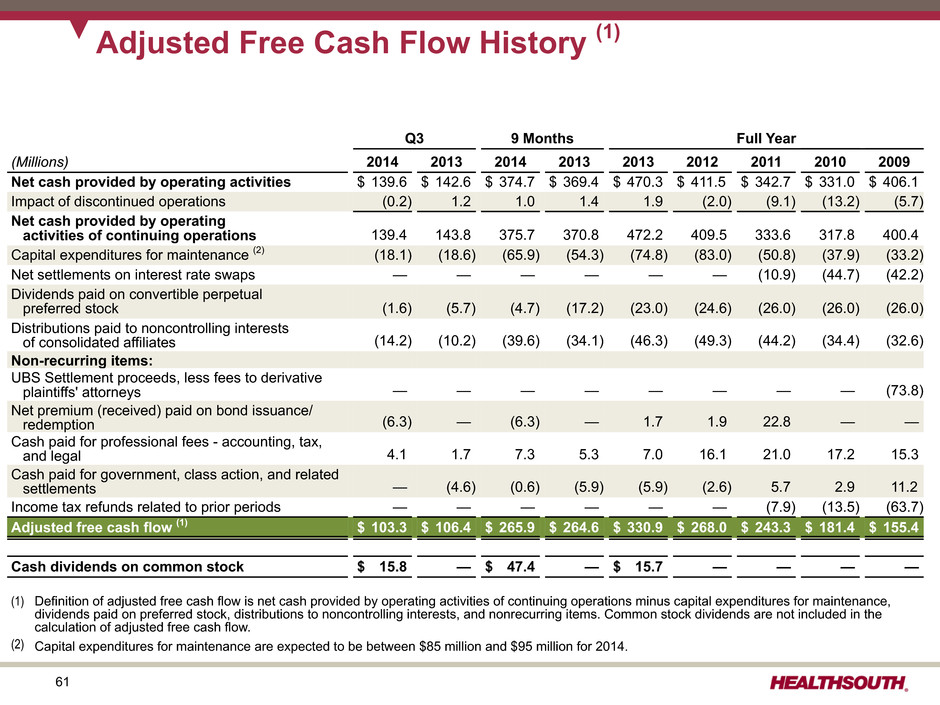
61 Adjusted Free Cash Flow History (1) Q3 9 Months Full Year (Millions) 2014 2013 2014 2013 2013 2012 2011 2010 2009 Net cash provided by operating activities $ 139.6 $ 142.6 $ 374.7 $ 369.4 $ 470.3 $ 411.5 $ 342.7 $ 331.0 $ 406.1 Impact of discontinued operations (0.2) 1.2 1.0 1.4 1.9 (2.0) (9.1) (13.2) (5.7) Net cash provided by operating activities of continuing operations 139.4 143.8 375.7 370.8 472.2 409.5 333.6 317.8 400.4 Capital expenditures for maintenance (2) (18.1) (18.6) (65.9) (54.3) (74.8) (83.0) (50.8) (37.9) (33.2) Net settlements on interest rate swaps — — — — — — (10.9) (44.7) (42.2) Dividends paid on convertible perpetual preferred stock (1.6) (5.7) (4.7) (17.2) (23.0) (24.6) (26.0) (26.0) (26.0) Distributions paid to noncontrolling interests of consolidated affiliates (14.2) (10.2) (39.6) (34.1) (46.3) (49.3) (44.2) (34.4) (32.6) Non-recurring items: UBS Settlement proceeds, less fees to derivative plaintiffs' attorneys — — — — — — — — (73.8) Net premium (received) paid on bond issuance/ redemption (6.3) — (6.3) — 1.7 1.9 22.8 — — Cash paid for professional fees - accounting, tax, and legal 4.1 1.7 7.3 5.3 7.0 16.1 21.0 17.2 15.3 Cash paid for government, class action, and related settlements — (4.6) (0.6) (5.9) (5.9) (2.6) 5.7 2.9 11.2 Income tax refunds related to prior periods — — — — — — (7.9) (13.5) (63.7) Adjusted free cash flow (1) $ 103.3 $ 106.4 $ 265.9 $ 264.6 $ 330.9 $ 268.0 $ 243.3 $ 181.4 $ 155.4 Cash dividends on common stock $ 15.8 — $ 47.4 — $ 15.7 — — — — (1) Definition of adjusted free cash flow is net cash provided by operating activities of continuing operations minus capital expenditures for maintenance, dividends paid on preferred stock, distributions to noncontrolling interests, and nonrecurring items. Common stock dividends are not included in the calculation of adjusted free cash flow. (2) Capital expenditures for maintenance are expected to be between $85 million and $95 million for 2014.
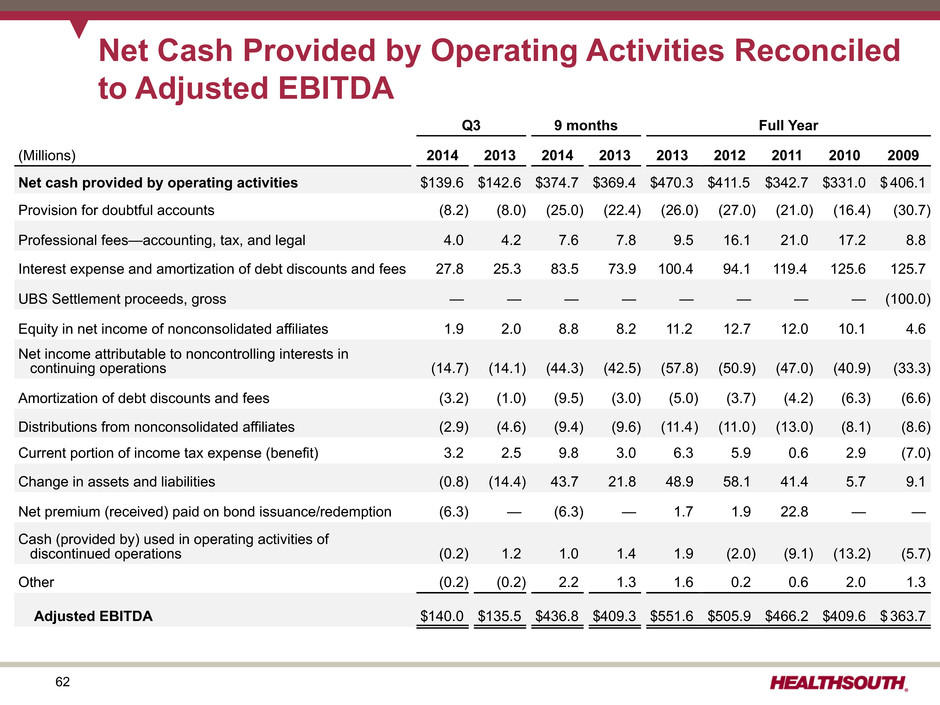
62 Net Cash Provided by Operating Activities Reconciled to Adjusted EBITDA Q3 9 months Full Year (Millions) 2014 2013 2014 2013 2013 2012 2011 2010 2009 Net cash provided by operating activities $139.6 $142.6 $374.7 $369.4 $470.3 $411.5 $342.7 $331.0 $ 406.1 Provision for doubtful accounts (8.2) (8.0) (25.0) (22.4) (26.0) (27.0) (21.0) (16.4) (30.7) Professional fees—accounting, tax, and legal 4.0 4.2 7.6 7.8 9.5 16.1 21.0 17.2 8.8 Interest expense and amortization of debt discounts and fees 27.8 25.3 83.5 73.9 100.4 94.1 119.4 125.6 125.7 UBS Settlement proceeds, gross — — — — — — — — (100.0) Equity in net income of nonconsolidated affiliates 1.9 2.0 8.8 8.2 11.2 12.7 12.0 10.1 4.6 Net income attributable to noncontrolling interests in continuing operations (14.7) (14.1) (44.3) (42.5) (57.8) (50.9) (47.0) (40.9) (33.3) Amortization of debt discounts and fees (3.2) (1.0) (9.5) (3.0) (5.0) (3.7) (4.2) (6.3) (6.6) Distributions from nonconsolidated affiliates (2.9) (4.6) (9.4) (9.6) (11.4) (11.0) (13.0) (8.1) (8.6) Current portion of income tax expense (benefit) 3.2 2.5 9.8 3.0 6.3 5.9 0.6 2.9 (7.0) Change in assets and liabilities (0.8) (14.4) 43.7 21.8 48.9 58.1 41.4 5.7 9.1 Net premium (received) paid on bond issuance/redemption (6.3) — (6.3) — 1.7 1.9 22.8 — — Cash (provided by) used in operating activities of discontinued operations (0.2) 1.2 1.0 1.4 1.9 (2.0) (9.1) (13.2) (5.7) Other (0.2) (0.2) 2.2 1.3 1.6 0.2 0.6 2.0 1.3 Adjusted EBITDA $140.0 $135.5 $436.8 $409.3 $551.6 $505.9 $466.2 $409.6 $ 363.7
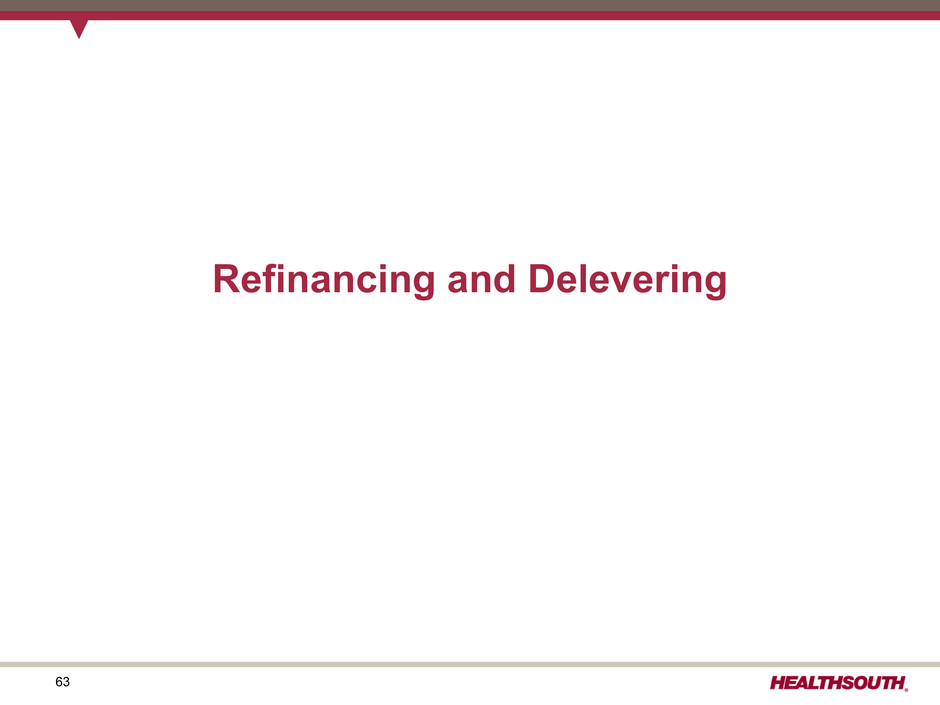
63 Refinancing and Delevering
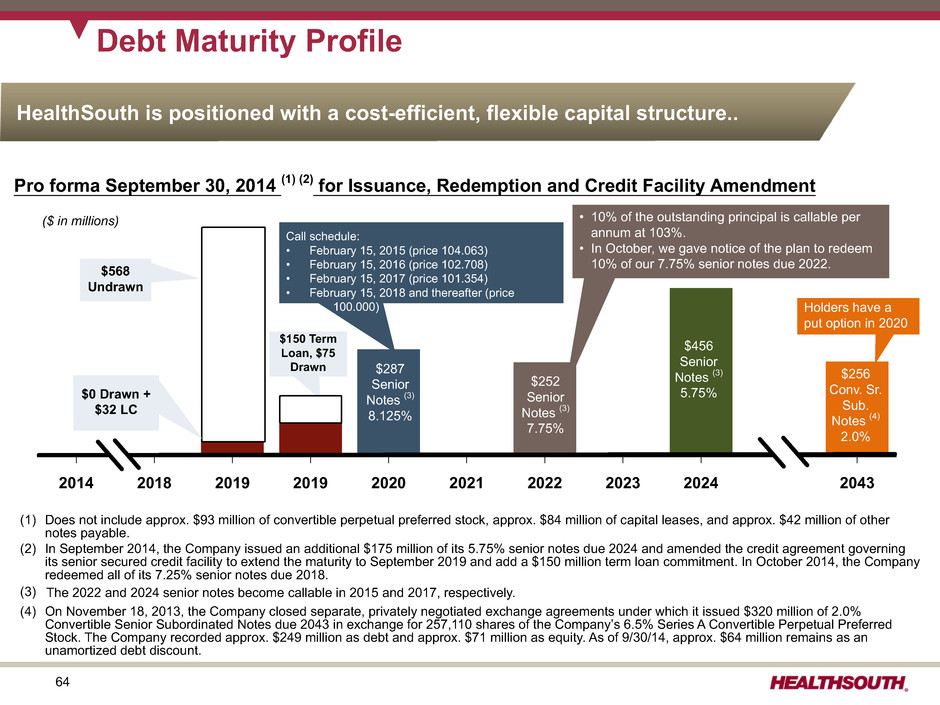
64 2014 2018 2019 2019 2020 2021 2022 2023 2024 2043 $287 Senior Notes (3) 8.125% $456 Senior Notes (3) 5.75% $256 Conv. Sr. Sub. Notes (4) 2.0% $252 Senior Notes (3) 7.75% $568 Undrawn $0 Drawn + $32 LC • 10% of the outstanding principal is callable per annum at 103%. • In October, we gave notice of the plan to redeem 10% of our 7.75% senior notes due 2022. Holders have a put option in 2020 Pro forma September 30, 2014 (1) (2) for Issuance, Redemption and Credit Facility Amendment Debt Maturity Profile (1) Does not include approx. $93 million of convertible perpetual preferred stock, approx. $84 million of capital leases, and approx. $42 million of other notes payable. (2) In September 2014, the Company issued an additional $175 million of its 5.75% senior notes due 2024 and amended the credit agreement governing its senior secured credit facility to extend the maturity to September 2019 and add a $150 million term loan commitment. In October 2014, the Company redeemed all of its 7.25% senior notes due 2018. (3) The 2022 and 2024 senior notes become callable in 2015 and 2017, respectively. (4) On November 18, 2013, the Company closed separate, privately negotiated exchange agreements under which it issued $320 million of 2.0% Convertible Senior Subordinated Notes due 2043 in exchange for 257,110 shares of the Company’s 6.5% Series A Convertible Perpetual Preferred Stock. The Company recorded approx. $249 million as debt and approx. $71 million as equity. As of 9/30/14, approx. $64 million remains as an unamortized debt discount. Call schedule: • February 15, 2015 (price 104.063) • February 15, 2016 (price 102.708) • February 15, 2017 (price 101.354) • February 15, 2018 and thereafter (price 100.000) HealthSouth is positioned with a cost-efficient, flexible capital structure.. ($ in millions) $150 Term Loan, $75 Drawn
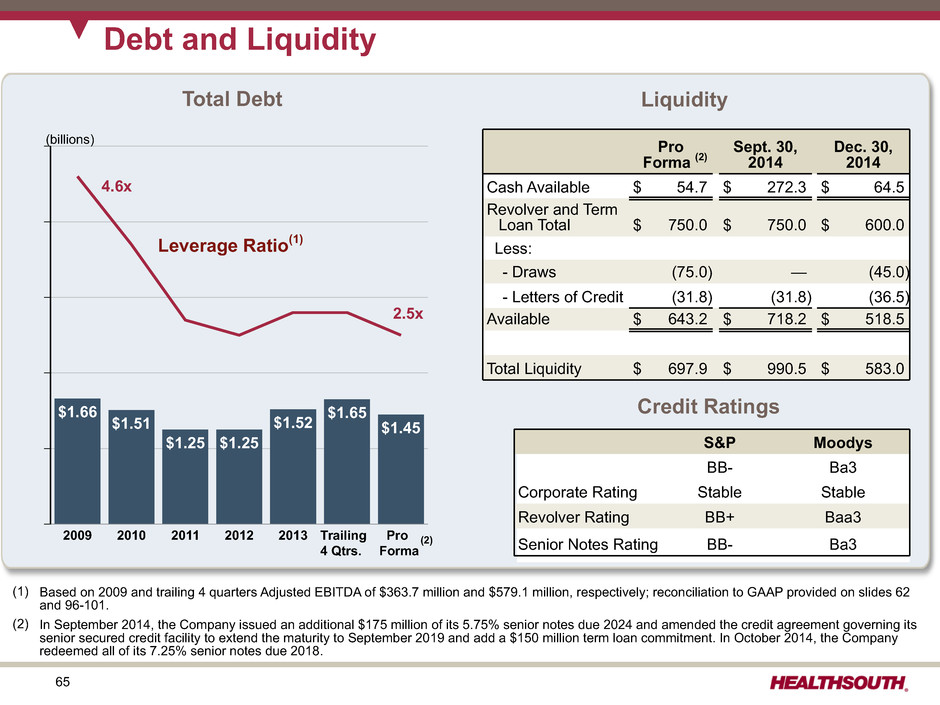
65 S&P Moodys Corporate Rating BB- Ba3 Stable Stable Revolver Rating BB+ Baa3 Senior Notes Rating BB- Ba3 Debt and Liquidity (1) Liquidity Credit Ratings (1) Based on 2009 and trailing 4 quarters Adjusted EBITDA of $363.7 million and $579.1 million, respectively; reconciliation to GAAP provided on slides 62 and 96-101. (2) In September 2014, the Company issued an additional $175 million of its 5.75% senior notes due 2024 and amended the credit agreement governing its senior secured credit facility to extend the maturity to September 2019 and add a $150 million term loan commitment. In October 2014, the Company redeemed all of its 7.25% senior notes due 2018. 2009 2010 2011 2012 2013 Trailing 4 Qtrs. Pro Forma $1.66 $1.51 $1.25 $1.25 $1.52 $1.65 $1.45 (billions) Leverage Ratio(1) Total Debt 4.6x 2.5x Pro Forma (2) Sept. 30, 2014 Dec. 30, 2014 Cash Available $ 54.7 $ 272.3 $ 64.5 Revolver and Term Loan Total $ 750.0 $ 750.0 $ 600.0 Less: - Draws (75.0) — (45.0) - Letters of Credit (31.8) (31.8) (36.5) Available $ 643.2 $ 718.2 $ 518.5 Total Liquidity $ 697.9 $ 990.5 $ 583.0 (2)
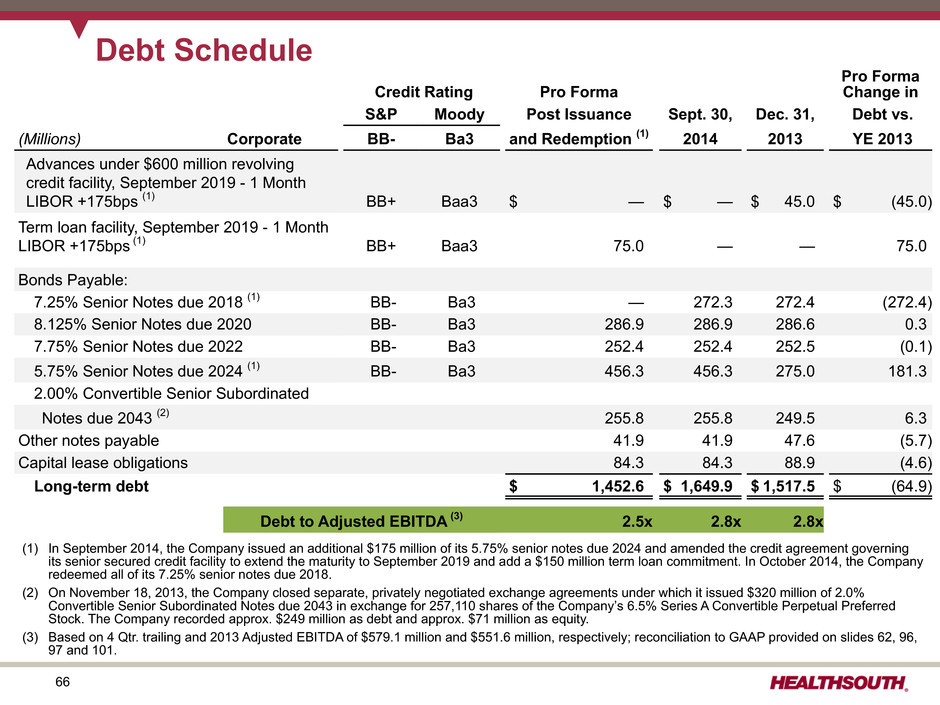
66 Debt Schedule Credit Rating Pro Forma Pro Forma Change in S&P Moody Post Issuance Sept. 30, Dec. 31, Debt vs. (Millions) Corporate BB- Ba3 and Redemption (1) 2014 2013 YE 2013 Advances under $600 million revolving credit facility, September 2019 - 1 Month LIBOR +175bps (1) BB+ Baa3 $ — $ — $ 45.0 $ (45.0) Term loan facility, September 2019 - 1 Month LIBOR +175bps (1) BB+ Baa3 75.0 — — 75.0 Bonds Payable: 7.25% Senior Notes due 2018 (1) BB- Ba3 — 272.3 272.4 (272.4) 8.125% Senior Notes due 2020 BB- Ba3 286.9 286.9 286.6 0.3 7.75% Senior Notes due 2022 BB- Ba3 252.4 252.4 252.5 (0.1) 5.75% Senior Notes due 2024 (1) BB- Ba3 456.3 456.3 275.0 181.3 2.00% Convertible Senior Subordinated Notes due 2043 (2) 255.8 255.8 249.5 6.3 Other notes payable 41.9 41.9 47.6 (5.7) Capital lease obligations 84.3 84.3 88.9 (4.6) Long-term debt $ 1,452.6 $ 1,649.9 $ 1,517.5 $ (64.9) Debt to Adjusted EBITDA (3) 2.5x 2.8x 2.8x (1) In September 2014, the Company issued an additional $175 million of its 5.75% senior notes due 2024 and amended the credit agreement governing its senior secured credit facility to extend the maturity to September 2019 and add a $150 million term loan commitment. In October 2014, the Company redeemed all of its 7.25% senior notes due 2018. (2) On November 18, 2013, the Company closed separate, privately negotiated exchange agreements under which it issued $320 million of 2.0% Convertible Senior Subordinated Notes due 2043 in exchange for 257,110 shares of the Company’s 6.5% Series A Convertible Perpetual Preferred Stock. The Company recorded approx. $249 million as debt and approx. $71 million as equity. (3) Based on 4 Qtr. trailing and 2013 Adjusted EBITDA of $579.1 million and $551.6 million, respectively; reconciliation to GAAP provided on slides 62, 96, 97 and 101.
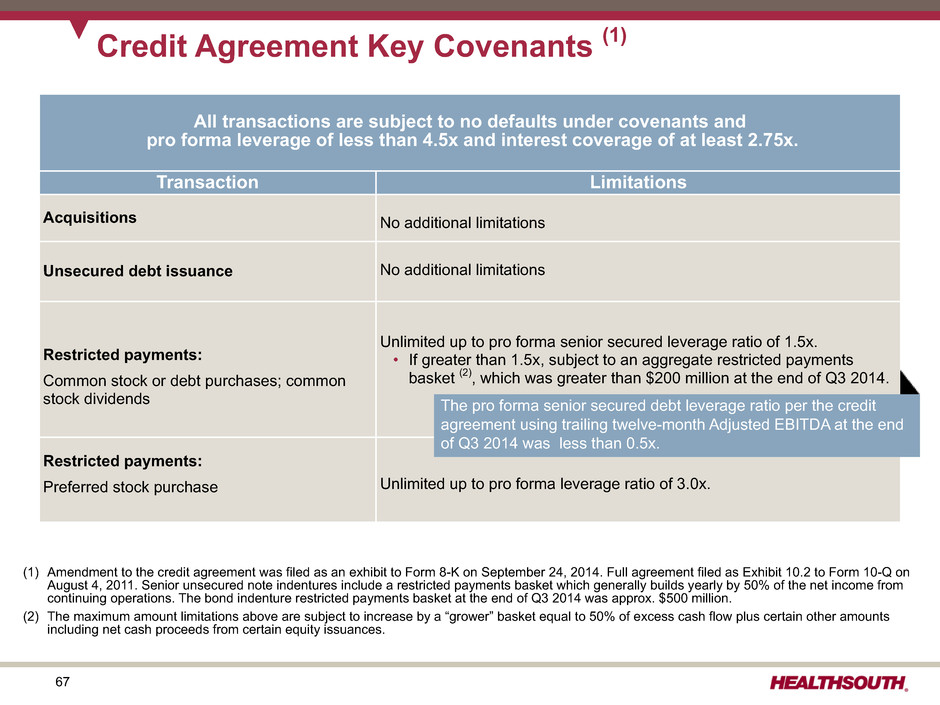
67 Credit Agreement Key Covenants (1) All transactions are subject to no defaults under covenants and pro forma leverage of less than 4.5x and interest coverage of at least 2.75x. Transaction Limitations Acquisitions No additional limitations Unsecured debt issuance No additional limitations Restricted payments: Common stock or debt purchases; common stock dividends Unlimited up to pro forma senior secured leverage ratio of 1.5x. • If greater than 1.5x, subject to an aggregate restricted payments basket (2), which was greater than $200 million at the end of Q3 2014. Restricted payments: Preferred stock purchase Unlimited up to pro forma leverage ratio of 3.0x. The pro forma senior secured debt leverage ratio per the credit agreement using trailing twelve-month Adjusted EBITDA at the end of Q3 2014 was less than 0.5x. (1) Amendment to the credit agreement was filed as an exhibit to Form 8-K on September 24, 2014. Full agreement filed as Exhibit 10.2 to Form 10-Q on August 4, 2011. Senior unsecured note indentures include a restricted payments basket which generally builds yearly by 50% of the net income from continuing operations. The bond indenture restricted payments basket at the end of Q3 2014 was approx. $500 million. (2) The maximum amount limitations above are subject to increase by a “grower” basket equal to 50% of excess cash flow plus certain other amounts including net cash proceeds from certain equity issuances.
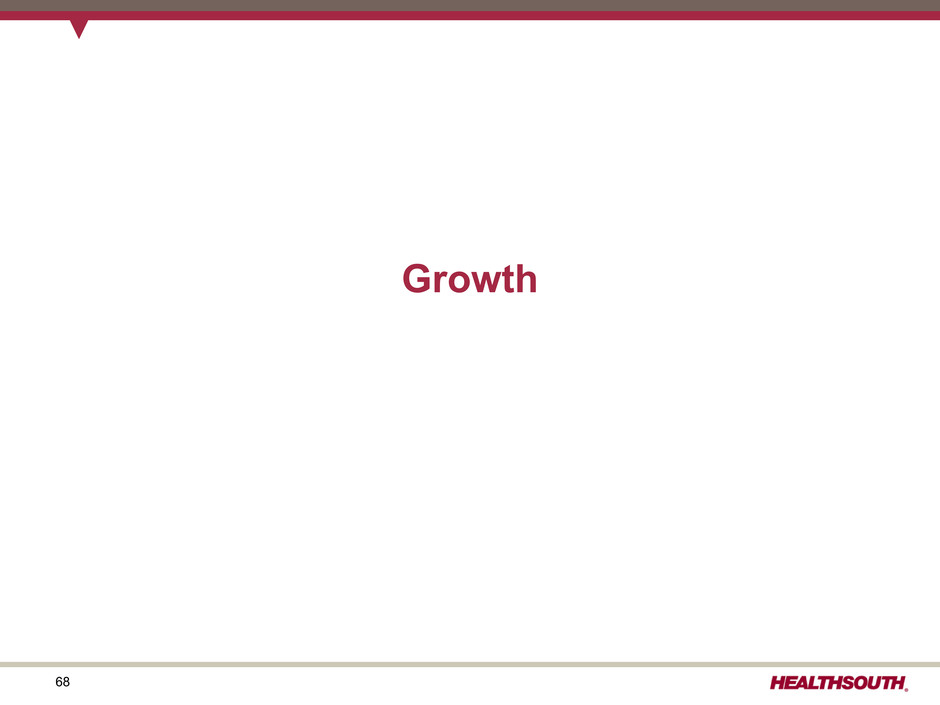
68 Growth

69 Organic Growth: A Strategic Framework Bottoms-up approach to HealthSouth’s growth projections Market Dynamics • Existing IRF beds • Managed care penetration • Competition Sales and Marketing Strategies • Defining “upstream” opportunities • Identifying CMS-13 discharges • “Converting” CMS-13 patients to rehab Growth goals for the market and/or hospital Demographics + population growth and changes (weighted by age) = Rehab CAGR
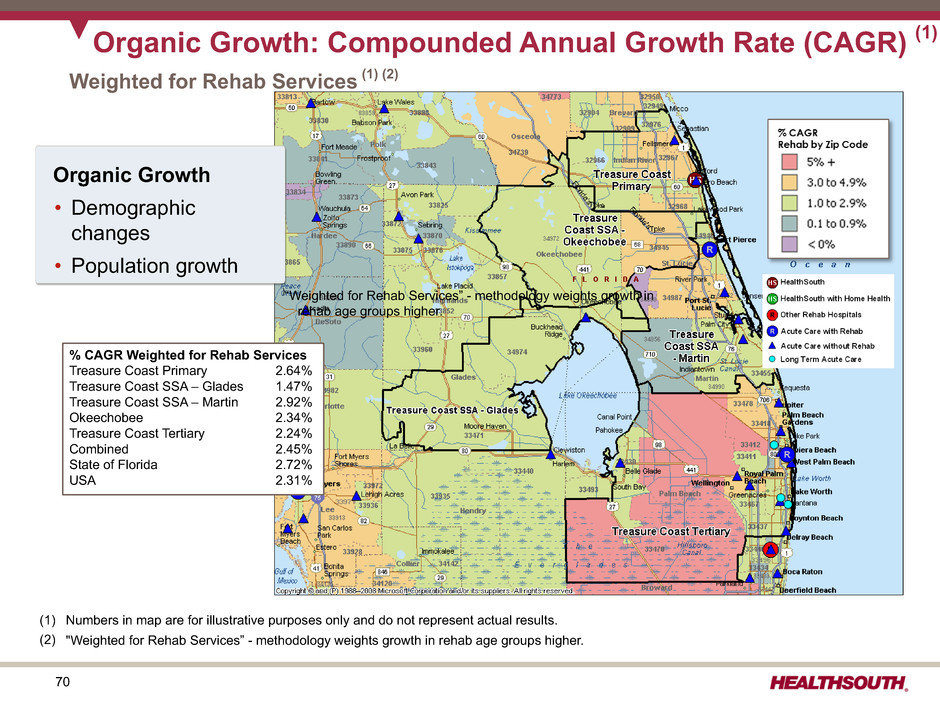
70 Organic Growth: Compounded Annual Growth Rate (CAGR) (1) Weighted for Rehab Services (1) (2) % CAGR Weighted for Rehab Services Treasure Coast Primary 2.64% Treasure Coast SSA – Glades 1.47% Treasure Coast SSA – Martin 2.92% Okeechobee 2.34% Treasure Coast Tertiary 2.24% Combined 2.45% State of Florida 2.72% USA 2.31% (1) Numbers in map are for illustrative purposes only and do not represent actual results. (2) "Weighted for Rehab Services” - methodology weights growth in rehab age groups higher. )“Weighted for Rehab Services” - methodology weights growth in rehab age groups higher. Organic Growth • Demographic changes • Population growth
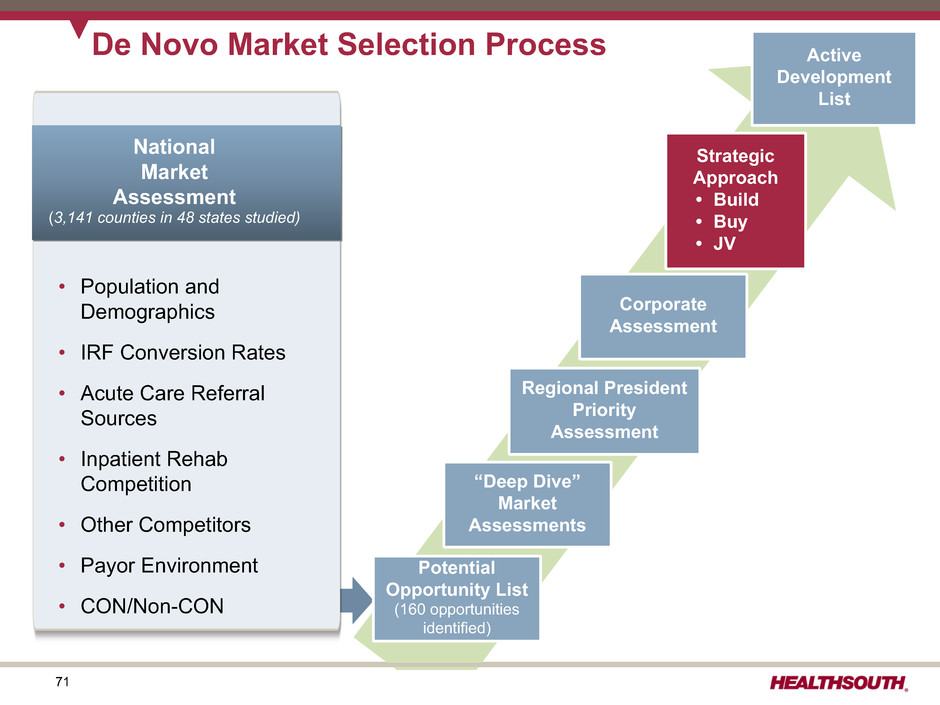
71 De Novo Market Selection Process Active Development List Corporate Assessment Strategic Approach • Build • Buy • JV Regional President Priority Assessment “Deep Dive” Market Assessments Potential Opportunity List (160 opportunities identified) • Population and Demographics • IRF Conversion Rates • Acute Care Referral Sources • Inpatient Rehab Competition • Other Competitors • Payor Environment • CON/Non-CON National Market Assessment (3,141 counties in 48 states studied)
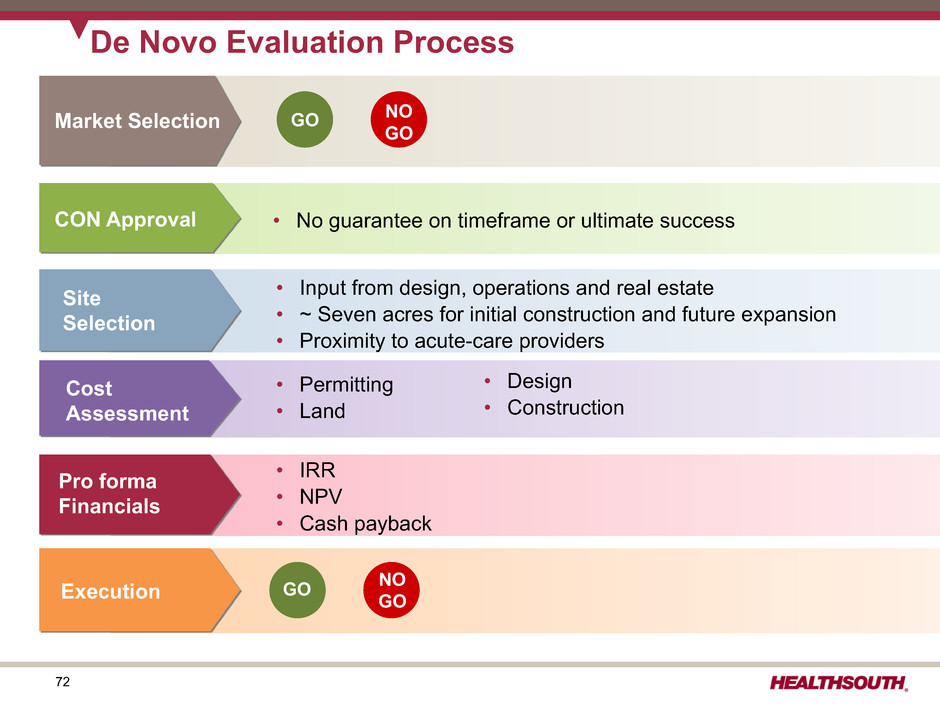
72 De Novo Evaluation Process Market Selection CON Approval • No guarantee on timeframe or ultimate success Site Selection • Input from design, operations and real estate • ~ Seven acres for initial construction and future expansion • Proximity to acute-care providers Cost Assessment • Permitting • Land • Design • Construction • IRR • NPV • Cash payback Pro forma Financials Execution NO GO GO GO NOGO
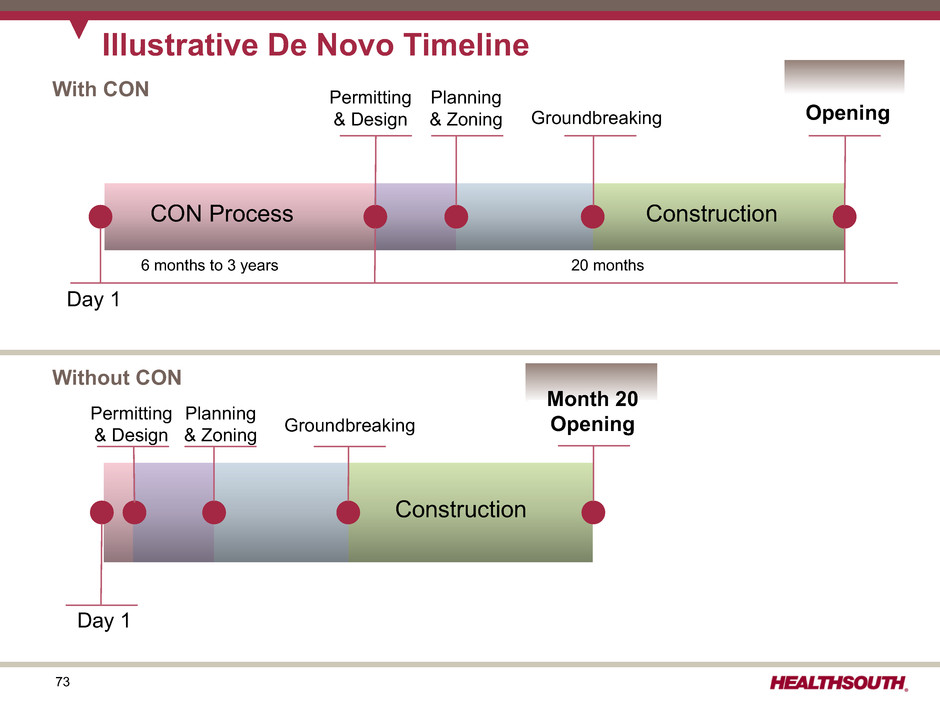
73 Illustrative De Novo Timeline Day 1 With CON Permitting & Design Planning & Zoning Groundbreaking Permitting & Design Planning & Zoning Groundbreaking Day 1 Without CON 6 months to 3 years 20 months CON Process Construction Construction Opening Month 20 Opening
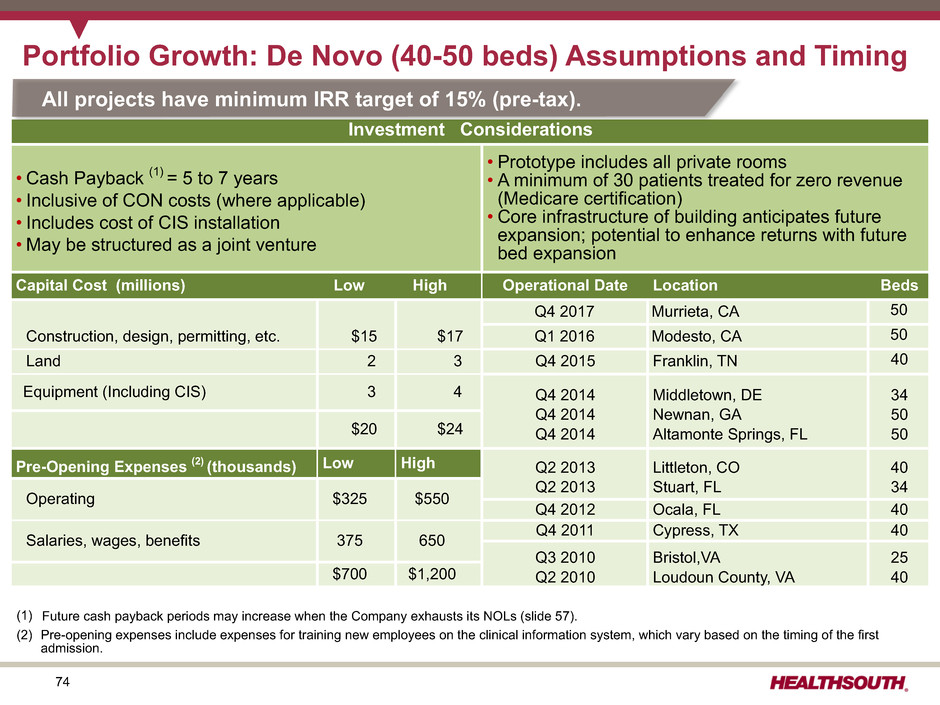
74 Investment Considerations • Cash Payback (1) = 5 to 7 years • Inclusive of CON costs (where applicable) • Includes cost of CIS installation • May be structured as a joint venture • Prototype includes all private rooms • A minimum of 30 patients treated for zero revenue (Medicare certification) • Core infrastructure of building anticipates future expansion; potential to enhance returns with future bed expansion Capital Cost (millions) Low High Operational Date Location Beds Q4 2017 Murrieta, CA 50 Construction, design, permitting, etc. $15 $17 Q1 2016 Modesto, CA 50 Land 2 3 Q4 2015 Franklin, TN 40 Equipment (Including CIS) 3 4 Q4 2014 Q4 2014 Q4 2014 Middletown, DE Newnan, GA Altamonte Springs, FL 34 50 50$20 $24 Pre-Opening Expenses (2) (thousands) Low High Q2 2013 Q2 2013 Littleton, CO Stuart, FL 40 34 Operating $325 $550 Q4 2012 Ocala, FL 40 Salaries, wages, benefits 375 650 Q4 2011 Cypress, TX 40 Q3 2010 Q2 2010 Bristol,VA Loudoun County, VA 25 40$700 $1,200 Portfolio Growth: De Novo (40-50 beds) Assumptions and Timing All projects have minimum IRR target of 15% (pre-tax). (1) Future cash payback periods may increase when the Company exhausts its NOLs (slide 57). (2) Pre-opening expenses include expenses for training new employees on the clinical information system, which vary based on the timing of the first admission.
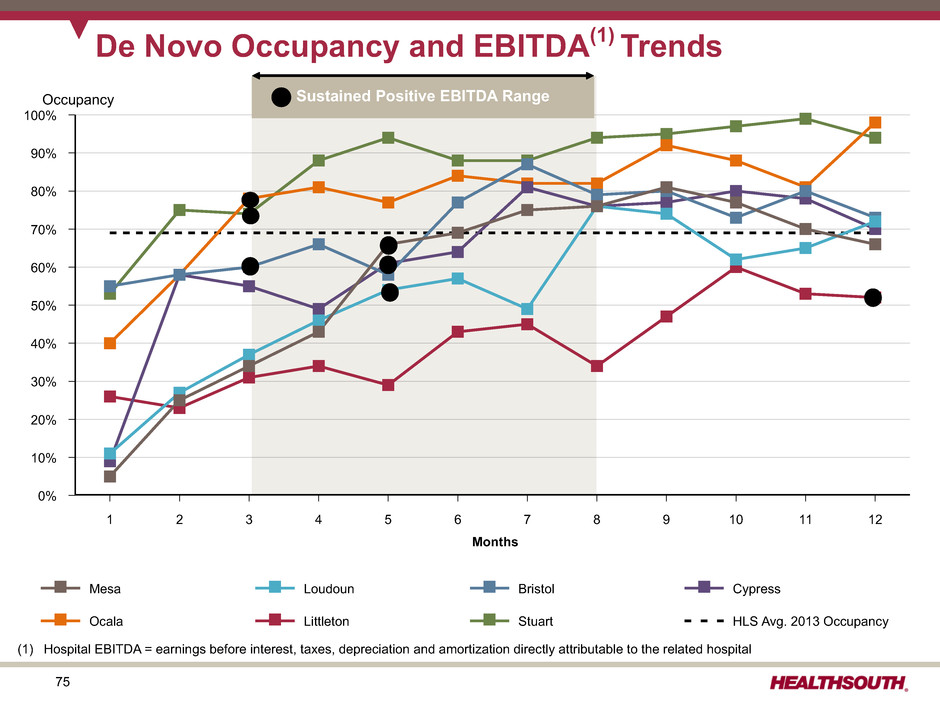
75 Mesa Loudoun Bristol Cypress Ocala Littleton Stuart HLS Avg. 2013 Occupancy 100% 90% 80% 70% 60% 50% 40% 30% 20% 10% 0% 1 2 3 4 5 6 7 8 9 10 11 12 Months De Novo Occupancy and EBITDA(1) Trends Occupancy Sustained Positive EBITDA Range (1) Hospital EBITDA = earnings before interest, taxes, depreciation and amortization directly attributable to the related hospital
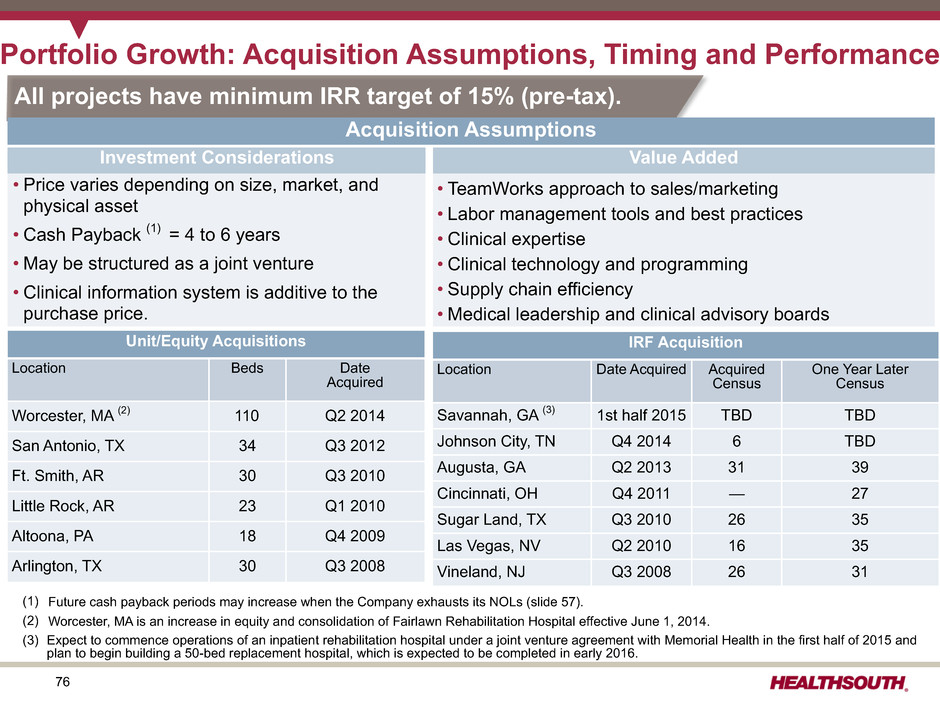
76 Portfolio Growth: Acquisition Assumptions, Timing and Performance Unit/Equity Acquisitions Location Beds Date Acquired Worcester, MA (2) 110 Q2 2014 San Antonio, TX 34 Q3 2012 Ft. Smith, AR 30 Q3 2010 Little Rock, AR 23 Q1 2010 Altoona, PA 18 Q4 2009 Arlington, TX 30 Q3 2008 IRF Acquisition Location Date Acquired Acquired Census One Year Later Census Savannah, GA (3) 1st half 2015 TBD TBD Johnson City, TN Q4 2014 6 TBD Augusta, GA Q2 2013 31 39 Cincinnati, OH Q4 2011 — 27 Sugar Land, TX Q3 2010 26 35 Las Vegas, NV Q2 2010 16 35 Vineland, NJ Q3 2008 26 31 All projects have minimum IRR target of 15% (pre-tax). Acquisition Assumptions Investment Considerations Value Added • Price varies depending on size, market, and physical asset • Cash Payback (1) = 4 to 6 years • May be structured as a joint venture • Clinical information system is additive to the purchase price. • TeamWorks approach to sales/marketing • Labor management tools and best practices • Clinical expertise • Clinical technology and programming • Supply chain efficiency • Medical leadership and clinical advisory boards (1) Future cash payback periods may increase when the Company exhausts its NOLs (slide 57). (2) Worcester, MA is an increase in equity and consolidation of Fairlawn Rehabilitation Hospital effective June 1, 2014. (3) Expect to commence operations of an inpatient rehabilitation hospital under a joint venture agreement with Memorial Health in the first half of 2015 and plan to begin building a 50-bed replacement hospital, which is expected to be completed in early 2016. .
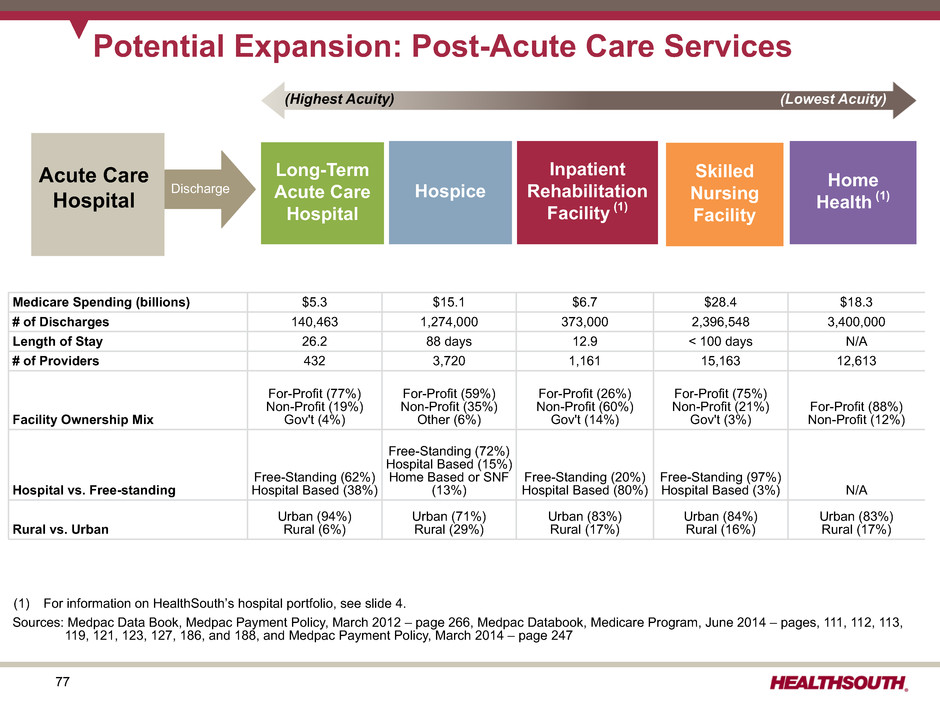
77 Potential Expansion: Post-Acute Care Services Acute Care Hospital Home Health (1)Hospice Long-Term Acute Care Hospital Inpatient Rehabilitation Facility (1) Skilled Nursing Facility Discharge Medicare Spending (billions) $5.3 $15.1 $6.7 $28.4 $18.3 # of Discharges 140,463 1,274,000 373,000 2,396,548 3,400,000 Length of Stay 26.2 88 days 12.9 < 100 days N/A # of Providers 432 3,720 1,161 15,163 12,613 Facility Ownership Mix For-Profit (77%) Non-Profit (19%) Gov't (4%) For-Profit (59%) Non-Profit (35%) Other (6%) For-Profit (26%) Non-Profit (60%) Gov't (14%) For-Profit (75%) Non-Profit (21%) Gov't (3%) For-Profit (88%) Non-Profit (12%) Hospital vs. Free-standing Free-Standing (62%) Hospital Based (38%) Free-Standing (72%) Hospital Based (15%) Home Based or SNF (13%) Free-Standing (20%) Hospital Based (80%) Free-Standing (97%) Hospital Based (3%) N/A Rural vs. Urban Urban (94%) Rural (6%) Urban (71%) Rural (29%) Urban (83%) Rural (17%) Urban (84%) Rural (16%) Urban (83%) Rural (17%) (Lowest Acuity)(Highest Acuity) (1) For information on HealthSouth’s hospital portfolio, see slide 4. Sources: Medpac Data Book, Medpac Payment Policy, March 2012 – page 266, Medpac Databook, Medicare Program, June 2014 – pages, 111, 112, 113, 119, 121, 123, 127, 186, and 188, and Medpac Payment Policy, March 2014 – page 247
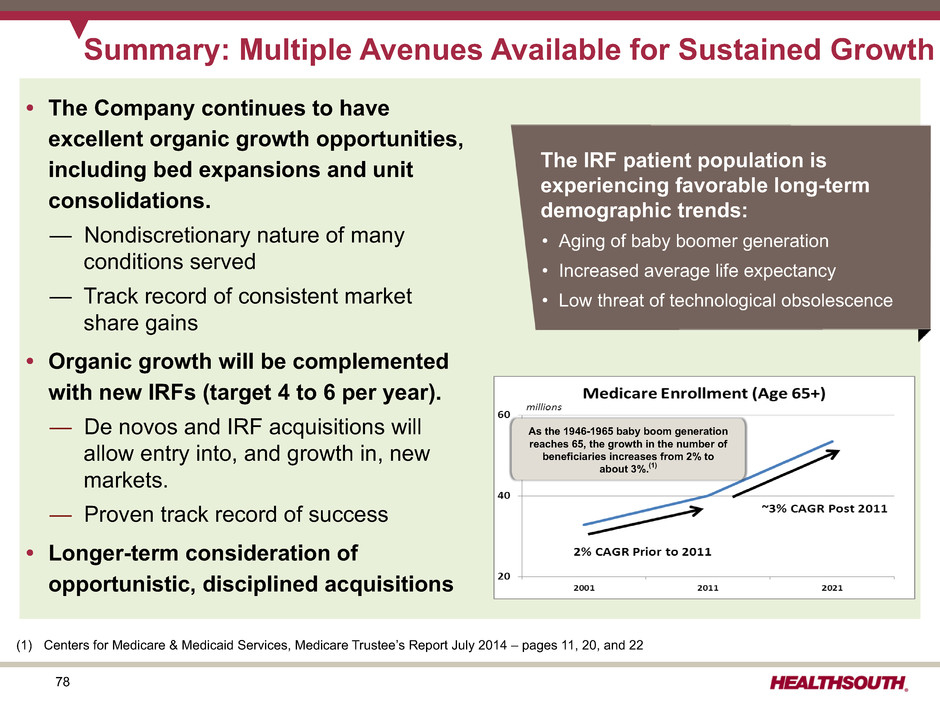
78 Summary: Multiple Avenues Available for Sustained Growth • The Company continues to have excellent organic growth opportunities, including bed expansions and unit consolidations. — Nondiscretionary nature of many conditions served — Track record of consistent market share gains • Organic growth will be complemented with new IRFs (target 4 to 6 per year). — De novos and IRF acquisitions will allow entry into, and growth in, new markets. — Proven track record of success • Longer-term consideration of opportunistic, disciplined acquisitions The IRF patient population is experiencing favorable long-term demographic trends: • Aging of baby boomer generation • Increased average life expectancy • Low threat of technological obsolescence As the 1946-1965 baby boom generation reaches 65, the growth in the number of beneficiaries increases from 2% to about 3%.(1) (1) Centers for Medicare & Medicaid Services, Medicare Trustee’s Report July 2014 – pages 11, 20, and 22
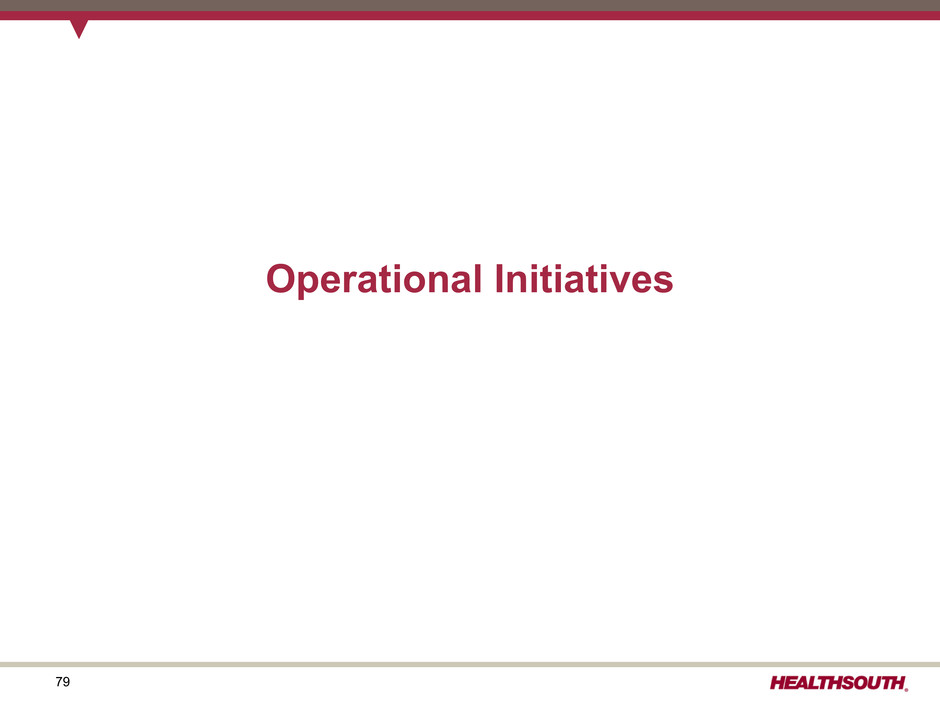
79 Operational Initiatives
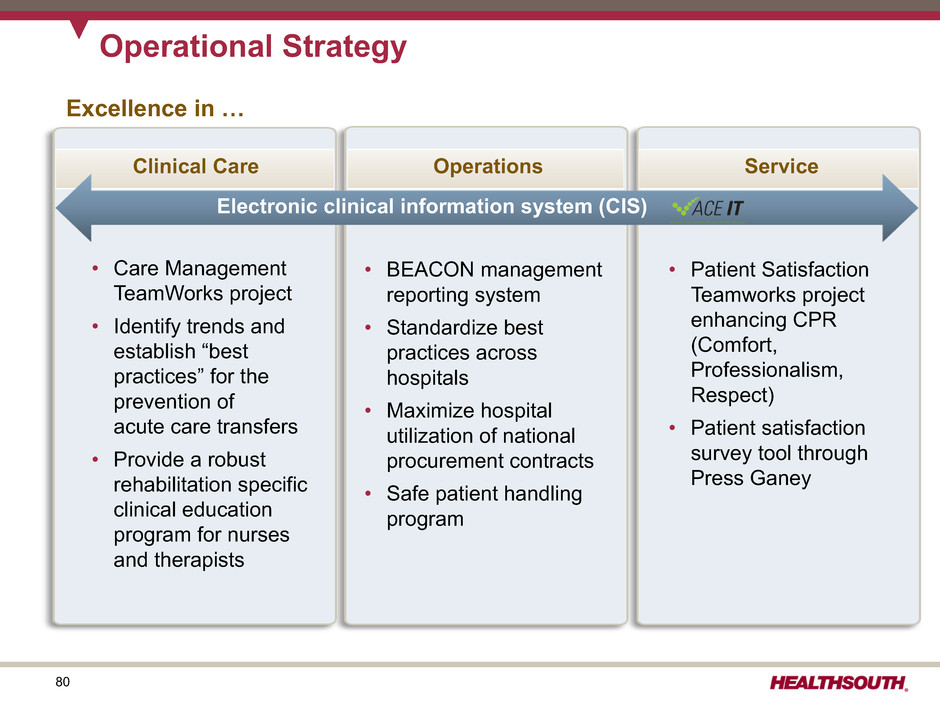
80 Operational Strategy Excellence in … • Care Management TeamWorks project • Identify trends and establish “best practices” for the prevention of acute care transfers • Provide a robust rehabilitation specific clinical education program for nurses and therapists • BEACON management reporting system • Standardize best practices across hospitals • Maximize hospital utilization of national procurement contracts • Safe patient handling program • Patient Satisfaction Teamworks project enhancing CPR (Comfort, Professionalism, Respect) • Patient satisfaction survey tool through Press Ganey ServiceOperationsClinical Care Electronic clinical information system (CIS)
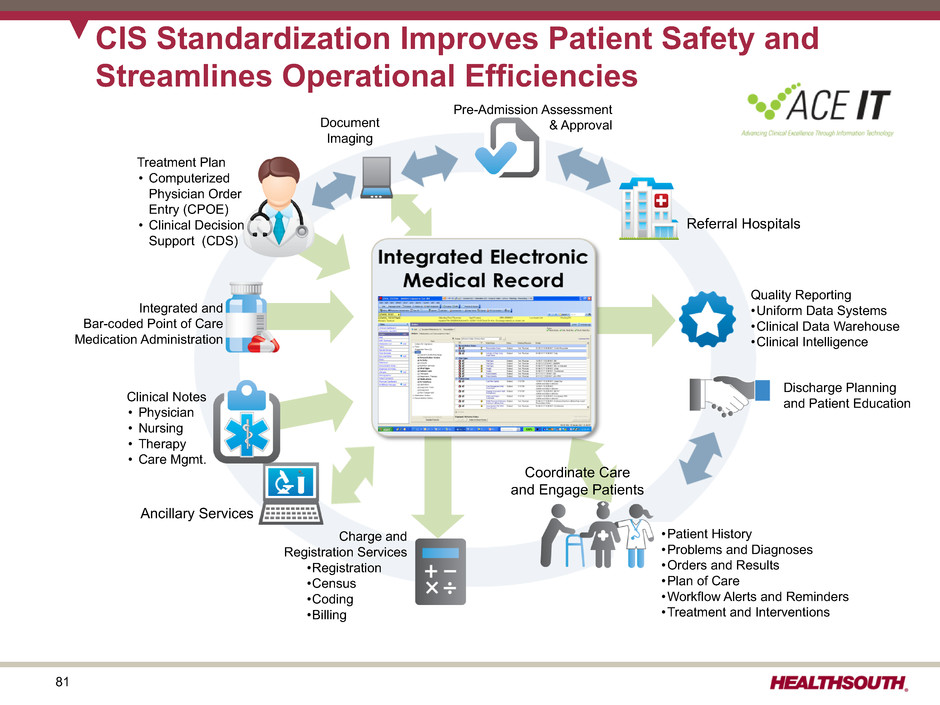
81 CIS Standardization Improves Patient Safety and Streamlines Operational Efficiencies Pre-Admission Assessment & Approval Discharge Planning and Patient Education •Patient History •Problems and Diagnoses •Orders and Results •Plan of Care •Workflow Alerts and Reminders •Treatment and Interventions Document Imaging Charge and Registration Services •Registration •Census •Coding •Billing Quality Reporting •Uniform Data Systems •Clinical Data Warehouse •Clinical Intelligence Referral Hospitals Ancillary Services Clinical Notes • Physician • Nursing • Therapy • Care Mgmt. Integrated and Bar-coded Point of Care Medication Administration Treatment Plan • Computerized Physician Order Entry (CPOE) • Clinical Decision Support (CDS) Coordinate Care and Engage Patients
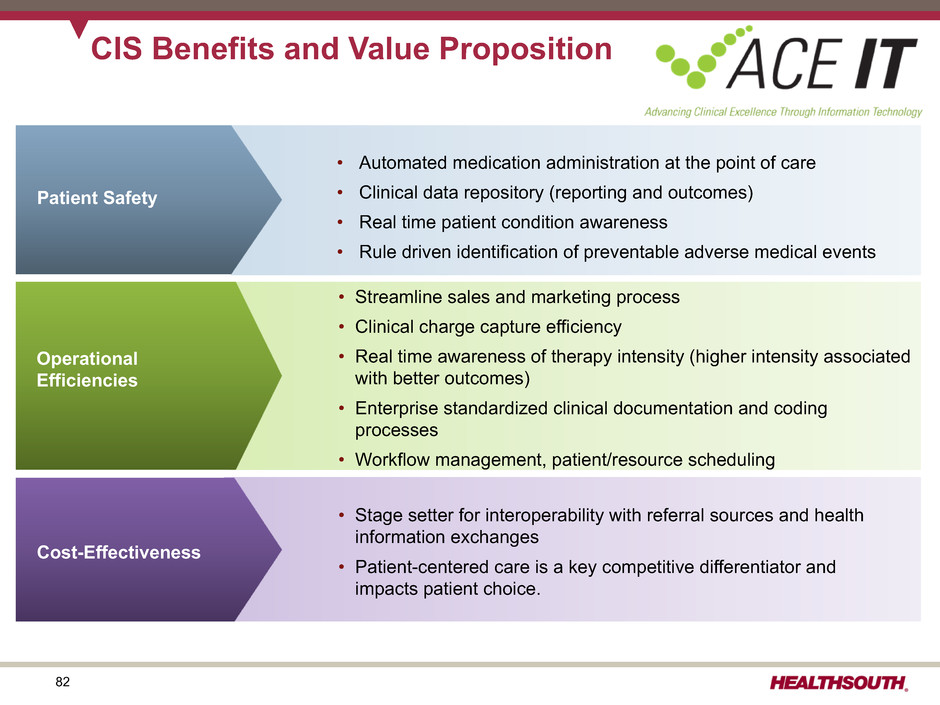
82 CIS Benefits and Value Proposition Operational Efficiencies Cost-Effectiveness • Automated medication administration at the point of care • Clinical data repository (reporting and outcomes) • Real time patient condition awareness • Rule driven identification of preventable adverse medical events Patient Safety • Streamline sales and marketing process • Clinical charge capture efficiency • Real time awareness of therapy intensity (higher intensity associated with better outcomes) • Enterprise standardized clinical documentation and coding processes • Workflow management, patient/resource scheduling • Stage setter for interoperability with referral sources and health information exchanges • Patient-centered care is a key competitive differentiator and impacts patient choice.
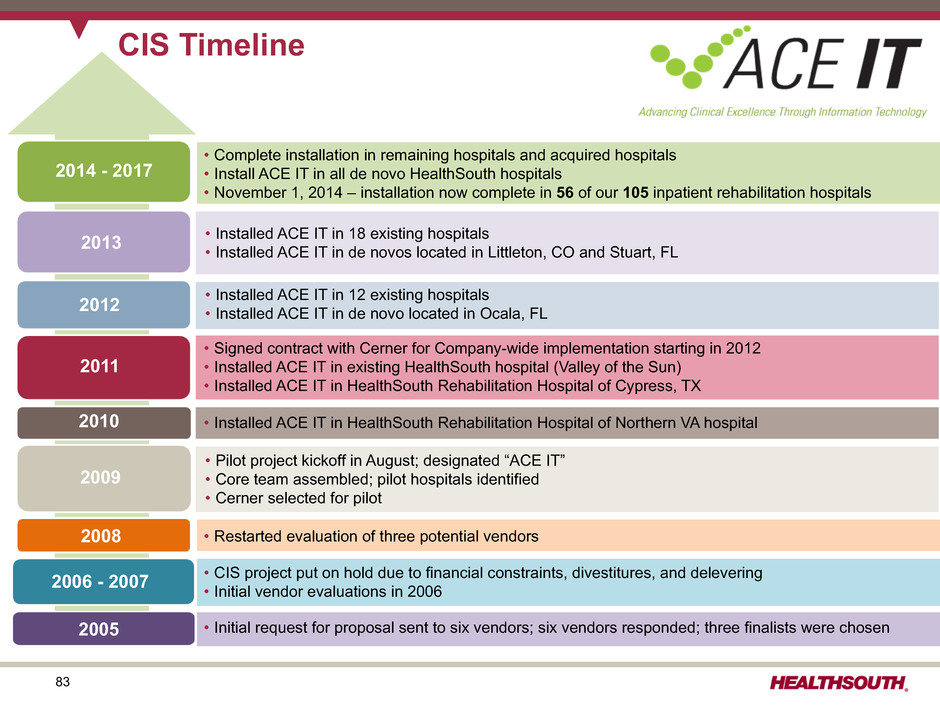
83 • Installed ACE IT in HealthSouth Rehabilitation Hospital of Northern VA hospital • Pilot project kickoff in August; designated “ACE IT” • Core team assembled; pilot hospitals identified • Cerner selected for pilot • Signed contract with Cerner for Company-wide implementation starting in 2012 • Installed ACE IT in existing HealthSouth hospital (Valley of the Sun) • Installed ACE IT in HealthSouth Rehabilitation Hospital of Cypress, TX • Installed ACE IT in 12 existing hospitals • Installed ACE IT in de novo located in Ocala, FL • Complete installation in remaining hospitals and acquired hospitals • Install ACE IT in all de novo HealthSouth hospitals • November 1, 2014 – installation now complete in 56 of our 105 inpatient rehabilitation hospitals CIS Timeline • Restarted evaluation of three potential vendors • CIS project put on hold due to financial constraints, divestitures, and delevering • Initial vendor evaluations in 2006 • Initial request for proposal sent to six vendors; six vendors responded; three finalists were chosen • Installed ACE IT in 18 existing hospitals • Installed ACE IT in de novos located in Littleton, CO and Stuart, FL 2014 - 2017 2013 2012 2011 2010 2009 2008 2006 - 2007 2005
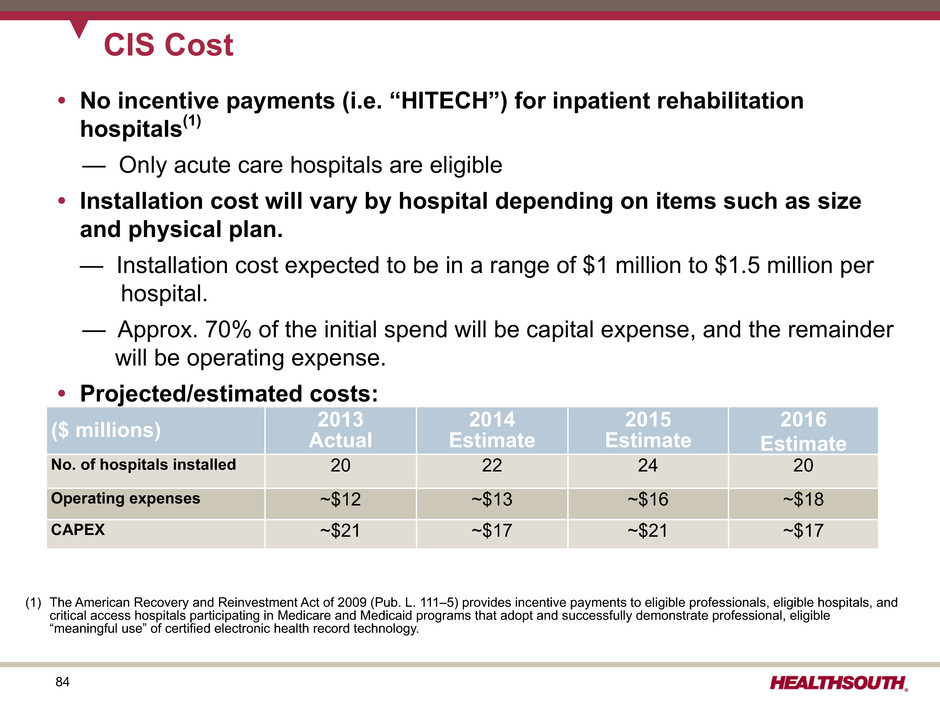
84 CIS Cost • No incentive payments (i.e. “HITECH”) for inpatient rehabilitation hospitals(1) — Only acute care hospitals are eligible • Installation cost will vary by hospital depending on items such as size and physical plan. — Installation cost expected to be in a range of $1 million to $1.5 million per hospital. — Approx. 70% of the initial spend will be capital expense, and the remainder will be operating expense. • Projected/estimated costs: ($ millions) 2013Actual 2014 Estimate 2015 Estimate 2016 Estimate No. of hospitals installed 20 22 24 20 Operating expenses ~$12 ~$13 ~$16 ~$18 CAPEX ~$21 ~$17 ~$21 ~$17 (1) The American Recovery and Reinvestment Act of 2009 (Pub. L. 111–5) provides incentive payments to eligible professionals, eligible hospitals, and critical access hospitals participating in Medicare and Medicaid programs that adopt and successfully demonstrate professional, eligible “meaningful use” of certified electronic health record technology.
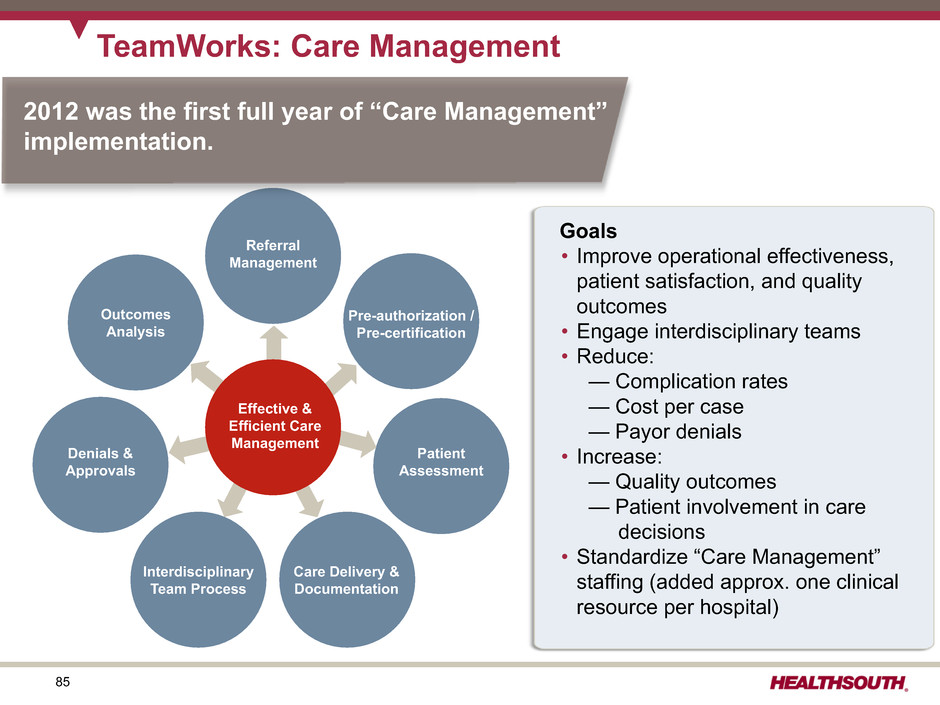
85 TeamWorks: Care Management Goals • Improve operational effectiveness, patient satisfaction, and quality outcomes • Engage interdisciplinary teams • Reduce: — Complication rates — Cost per case — Payor denials • Increase: — Quality outcomes — Patient involvement in care decisions • Standardize “Care Management” staffing (added approx. one clinical resource per hospital) 2012 was the first full year of “Care Management” implementation. Referral Management Pre-authorization / Pre-certification Patient Assessment Care Delivery & Documentation Interdisciplinary Team Process Denials & Approvals Outcomes Analysis Effective & Efficient Care Management
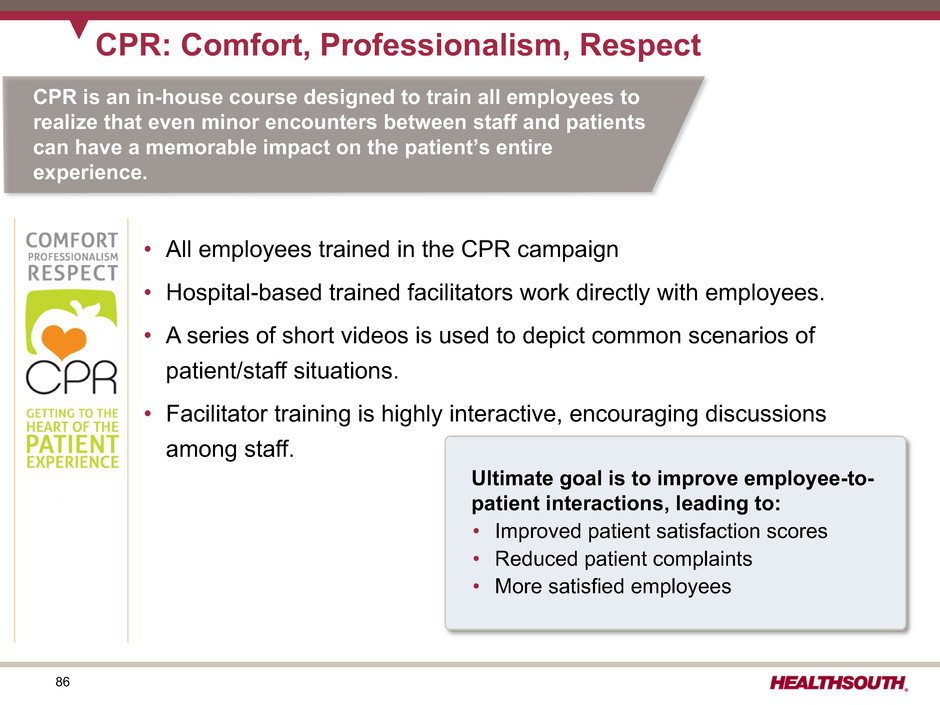
86 CPR: Comfort, Professionalism, Respect • All employees trained in the CPR campaign • Hospital-based trained facilitators work directly with employees. • A series of short videos is used to depict common scenarios of patient/staff situations. • Facilitator training is highly interactive, encouraging discussions among staff. CPR is an in-house course designed to train all employees to realize that even minor encounters between staff and patients can have a memorable impact on the patient’s entire experience. Ultimate goal is to improve employee-to- patient interactions, leading to: • Improved patient satisfaction scores • Reduced patient complaints • More satisfied employees
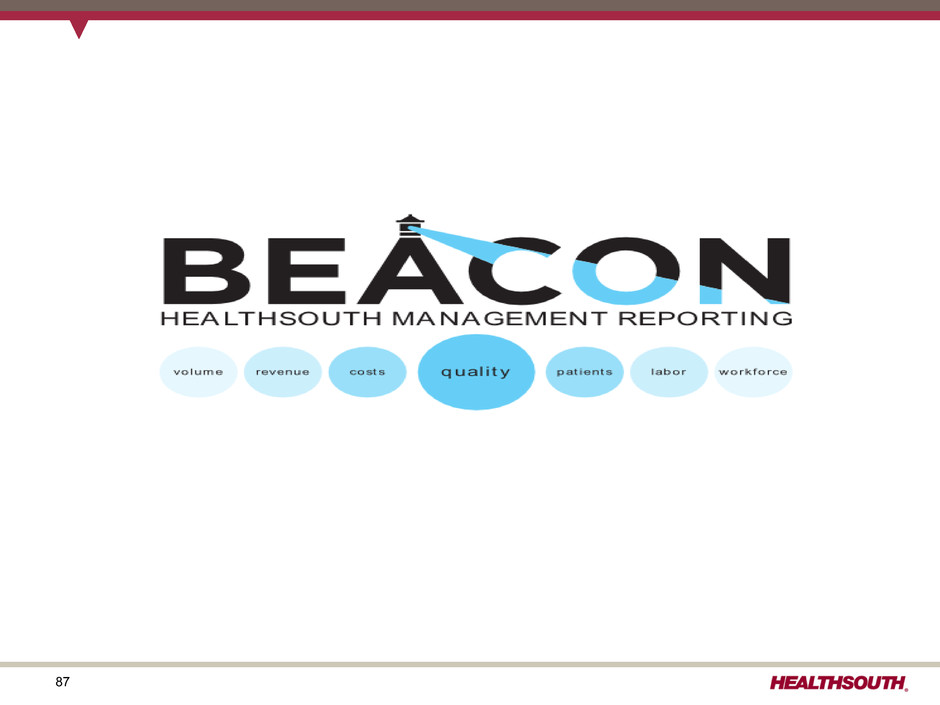
87
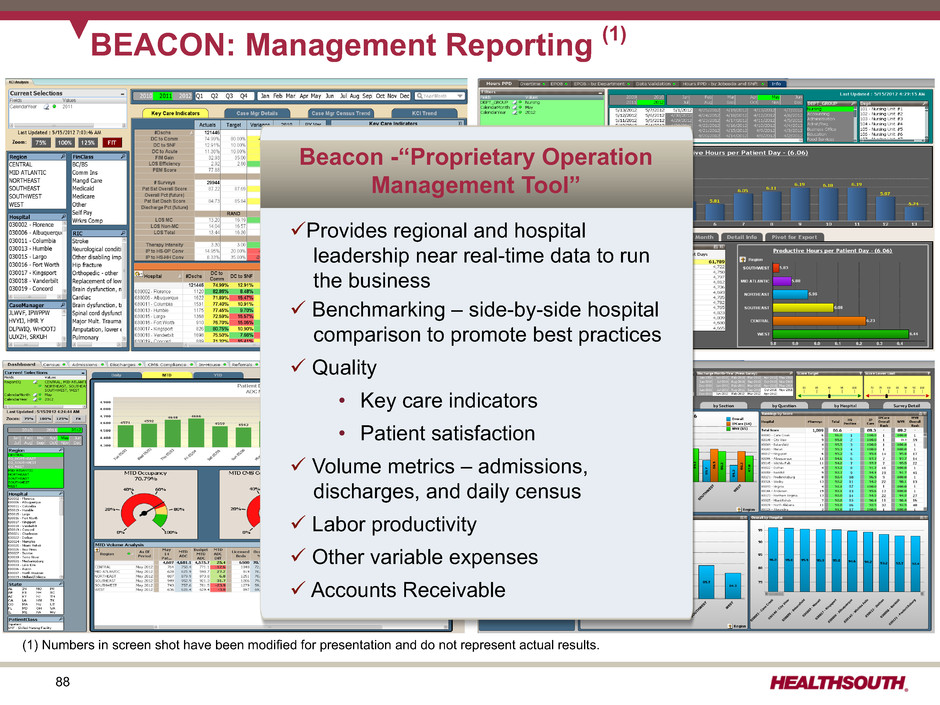
88 BEACON: Management Reporting (1) (1) Numbers in screen shot have been modified for presentation and do not represent actual results. Beacon -“Proprietary Operation Management Tool” üProvides regional and hospital leadership near real-time data to run the business ü Benchmarking – side-by-side hospital comparison to promote best practices ü Quality • Key care indicators • Patient satisfaction ü Volume metrics – admissions, discharges, and daily census ü Labor productivity ü Other variable expenses ü Accounts Receivable
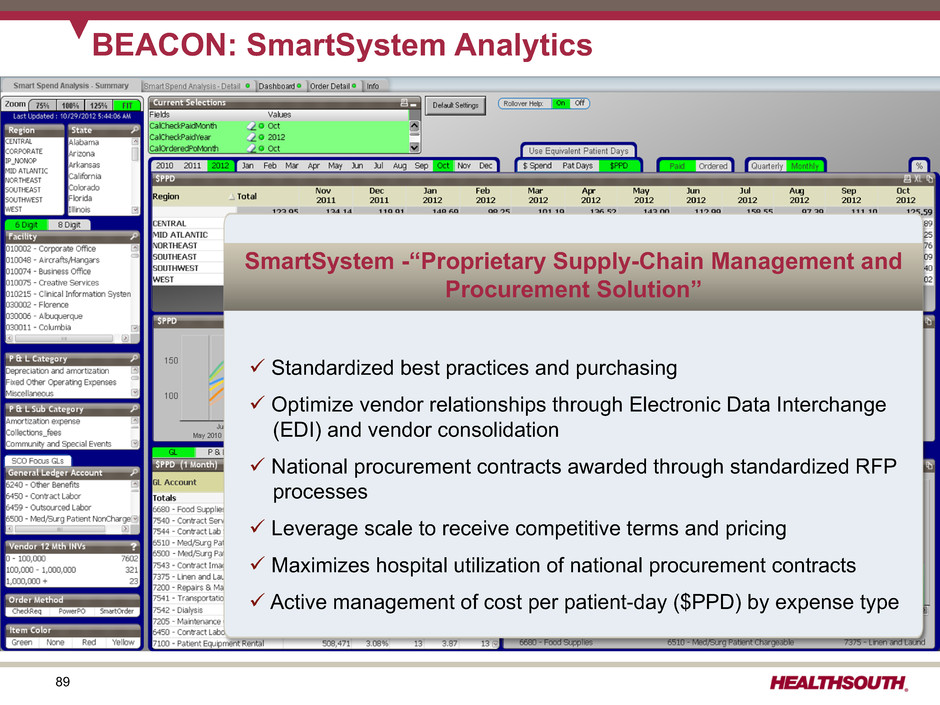
89 BEACON: SmartSystem Analytics ü Standardized best practices and purchasing ü Optimize vendor relationships through Electronic Data Interchange (EDI) and vendor consolidation ü National procurement contracts awarded through standardized RFP processes ü Leverage scale to receive competitive terms and pricing ü Maximizes hospital utilization of national procurement contracts ü Active management of cost per patient-day ($PPD) by expense type SmartSystem -“Proprietary Supply-Chain Management and Procurement Solution”
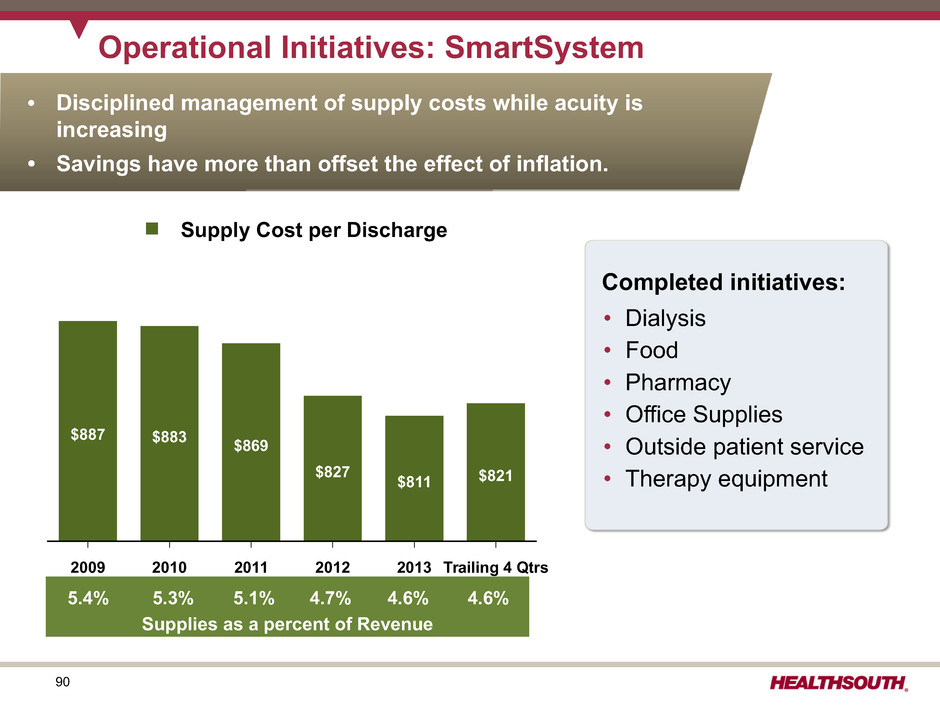
90 Operational Initiatives: SmartSystem Completed initiatives: • Dialysis • Food • Pharmacy • Office Supplies • Outside patient service • Therapy equipment Supply Cost per Discharge 2009 2010 2011 2012 2013 Trailing 4 Qtrs $887 $883 $869 $827 $811 $821 5.4% 5.3% 5.1% 4.7% 4.6% 4.6% Supplies as a percent of Revenue • Disciplined management of supply costs while acuity is increasing • Savings have more than offset the effect of inflation.
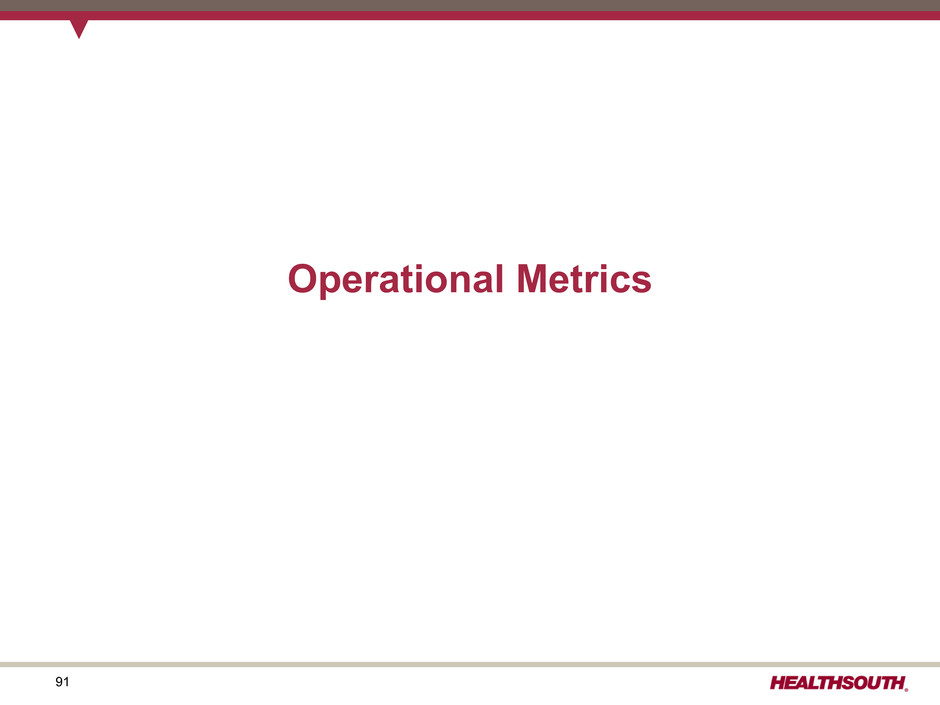
91 Operational Metrics
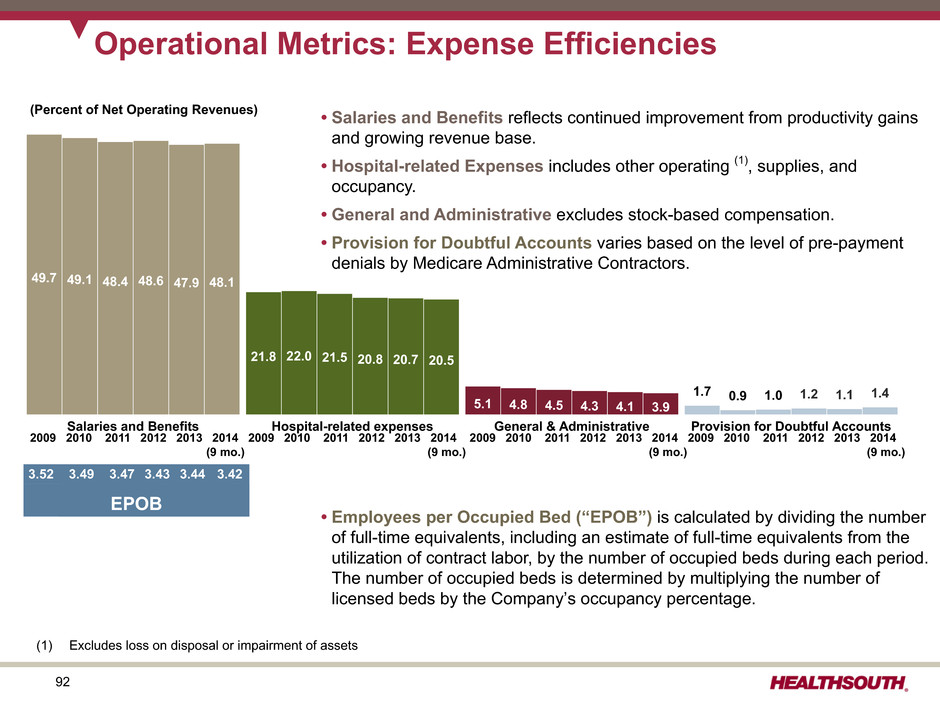
92 • Salaries and Benefits reflects continued improvement from productivity gains and growing revenue base. • Hospital-related Expenses includes other operating (1), supplies, and occupancy. • General and Administrative excludes stock-based compensation. • Provision for Doubtful Accounts varies based on the level of pre-payment denials by Medicare Administrative Contractors. • Employees per Occupied Bed (“EPOB”) is calculated by dividing the number of full-time equivalents, including an estimate of full-time equivalents from the utilization of contract labor, by the number of occupied beds during each period. The number of occupied beds is determined by multiplying the number of licensed beds by the Company’s occupancy percentage. Operational Metrics: Expense Efficiencies Salaries and Benefits Hospital-related expenses General & Administrative Provision for Doubtful Accounts 49.7 21.8 5.1 1.7 49.1 22.0 4.8 0.9 48.4 21.5 4.5 1.0 48.6 20.8 4.3 1.2 47.9 20.7 4.1 1.1 48.1 20.5 3.9 1.4 2009 2010 2011 2012 2013 2014 2009 2010 2011 2012 2013 2014 2009 2010 2011 2012 2013 2014 2009 2010 2011 2012 2013 2014 (9 mo.) (9 mo.) (9 mo.) (9 mo.) 3.52 3.49 3.47 3.43 3.44 3.42 EPOB (1) Excludes loss on disposal or impairment of assets (Percent of Net Operating Revenues)
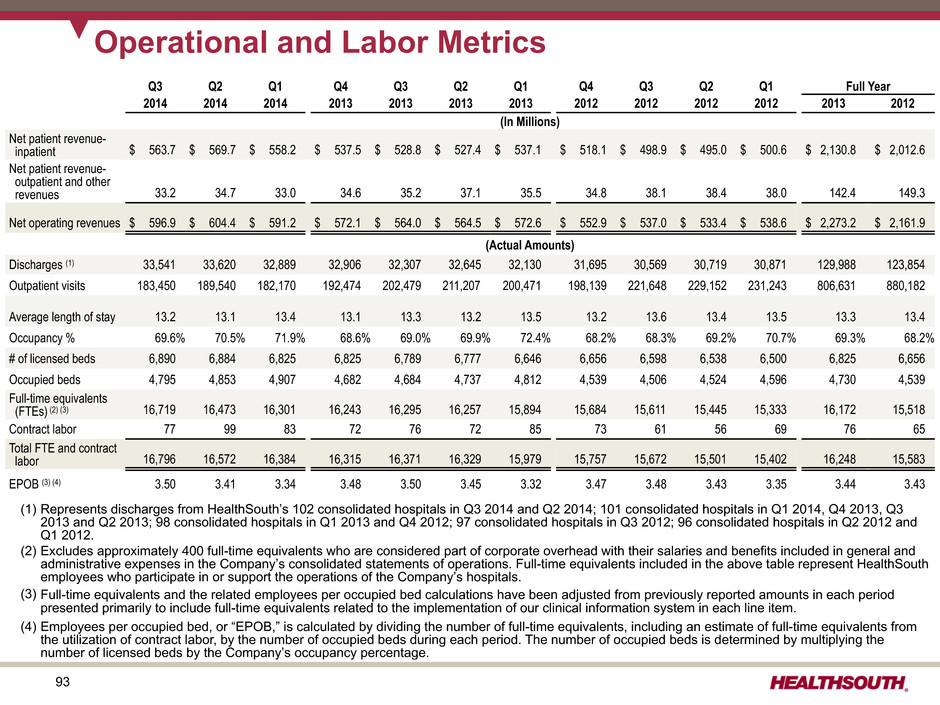
93 Operational and Labor Metrics Q3 Q2 Q1 Q4 Q3 Q2 Q1 Q4 Q3 Q2 Q1 Full Year 2014 2014 2014 2013 2013 2013 2013 2012 2012 2012 2012 2013 2012 (In Millions) Net patient revenue- inpatient $ 563.7 $ 569.7 $ 558.2 $ 537.5 $ 528.8 $ 527.4 $ 537.1 $ 518.1 $ 498.9 $ 495.0 $ 500.6 $ 2,130.8 $ 2,012.6 Net patient revenue- outpatient and other revenues 33.2 34.7 33.0 34.6 35.2 37.1 35.5 34.8 38.1 38.4 38.0 142.4 149.3 Net operating revenues $ 596.9 $ 604.4 $ 591.2 $ 572.1 $ 564.0 $ 564.5 $ 572.6 $ 552.9 $ 537.0 $ 533.4 $ 538.6 $ 2,273.2 $ 2,161.9 (Actual Amounts) Discharges (1) 33,541 33,620 32,889 32,906 32,307 32,645 32,130 31,695 30,569 30,719 30,871 129,988 123,854 Outpatient visits 183,450 189,540 182,170 192,474 202,479 211,207 200,471 198,139 221,648 229,152 231,243 806,631 880,182 Average length of stay 13.2 13.1 13.4 13.1 13.3 13.2 13.5 13.2 13.6 13.4 13.5 13.3 13.4 Occupancy % 69.6% 70.5% 71.9% 68.6% 69.0% 69.9% 72.4% 68.2% 68.3% 69.2% 70.7% 69.3% 68.2% # of licensed beds 6,890 6,884 6,825 6,825 6,789 6,777 6,646 6,656 6,598 6,538 6,500 6,825 6,656 Occupied beds 4,795 4,853 4,907 4,682 4,684 4,737 4,812 4,539 4,506 4,524 4,596 4,730 4,539 Full-time equivalents (FTEs) (2) (3) 16,719 16,473 16,301 16,243 16,295 16,257 15,894 15,684 15,611 15,445 15,333 16,172 15,518 Contract labor 77 99 83 72 76 72 85 73 61 56 69 76 65 Total FTE and contract labor 16,796 16,572 16,384 16,315 16,371 16,329 15,979 15,757 15,672 15,501 15,402 16,248 15,583 EPOB (3) (4) 3.50 3.41 3.34 3.48 3.50 3.45 3.32 3.47 3.48 3.43 3.35 3.44 3.43 (1) Represents discharges from HealthSouth’s 102 consolidated hospitals in Q3 2014 and Q2 2014; 101 consolidated hospitals in Q1 2014, Q4 2013, Q3 2013 and Q2 2013; 98 consolidated hospitals in Q1 2013 and Q4 2012; 97 consolidated hospitals in Q3 2012; 96 consolidated hospitals in Q2 2012 and Q1 2012. (2) Excludes approximately 400 full-time equivalents who are considered part of corporate overhead with their salaries and benefits included in general and administrative expenses in the Company’s consolidated statements of operations. Full-time equivalents included in the above table represent HealthSouth employees who participate in or support the operations of the Company’s hospitals. (3) Full-time equivalents and the related employees per occupied bed calculations have been adjusted from previously reported amounts in each period presented primarily to include full-time equivalents related to the implementation of our clinical information system in each line item. (4) Employees per occupied bed, or “EPOB,” is calculated by dividing the number of full-time equivalents, including an estimate of full-time equivalents from the utilization of contract labor, by the number of occupied beds during each period. The number of occupied beds is determined by multiplying the number of licensed beds by the Company’s occupancy percentage.
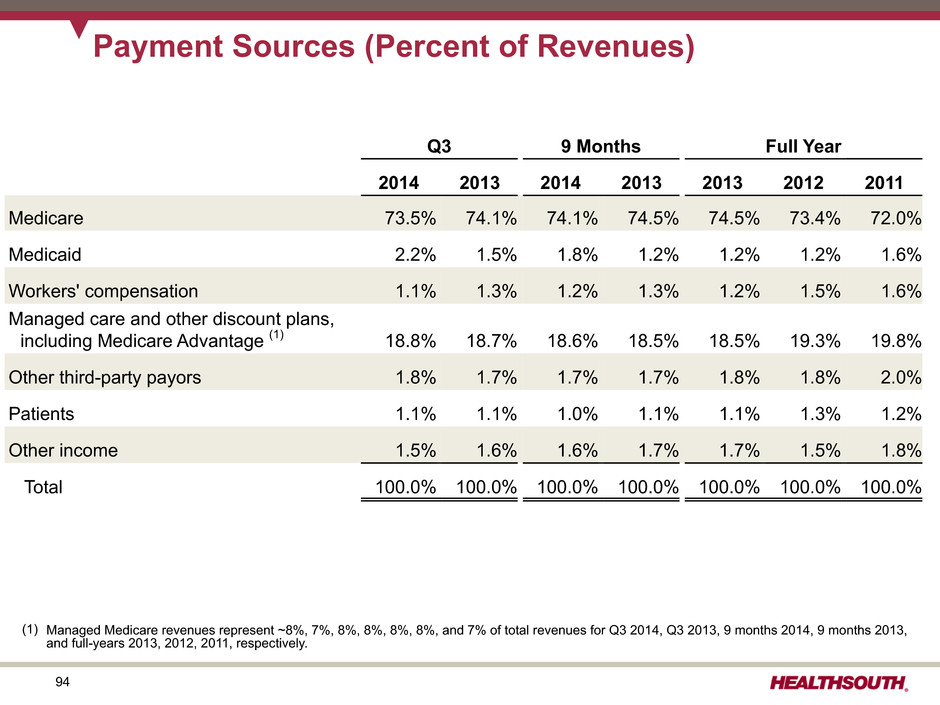
94 Payment Sources (Percent of Revenues) (1) Managed Medicare revenues represent ~8%, 7%, 8%, 8%, 8%, 8%, and 7% of total revenues for Q3 2014, Q3 2013, 9 months 2014, 9 months 2013, and full-years 2013, 2012, 2011, respectively. Q3 9 Months Full Year 2014 2013 2014 2013 2013 2012 2011 Medicare 73.5% 74.1% 74.1% 74.5% 74.5% 73.4% 72.0% Medicaid 2.2% 1.5% 1.8% 1.2% 1.2% 1.2% 1.6% Workers' compensation 1.1% 1.3% 1.2% 1.3% 1.2% 1.5% 1.6% Managed care and other discount plans, including Medicare Advantage (1) 18.8% 18.7% 18.6% 18.5% 18.5% 19.3% 19.8% Other third-party payors 1.8% 1.7% 1.7% 1.7% 1.8% 1.8% 2.0% Patients 1.1% 1.1% 1.0% 1.1% 1.1% 1.3% 1.2% Other income 1.5% 1.6% 1.6% 1.7% 1.7% 1.5% 1.8% Total 100.0% 100.0% 100.0% 100.0% 100.0% 100.0% 100.0%
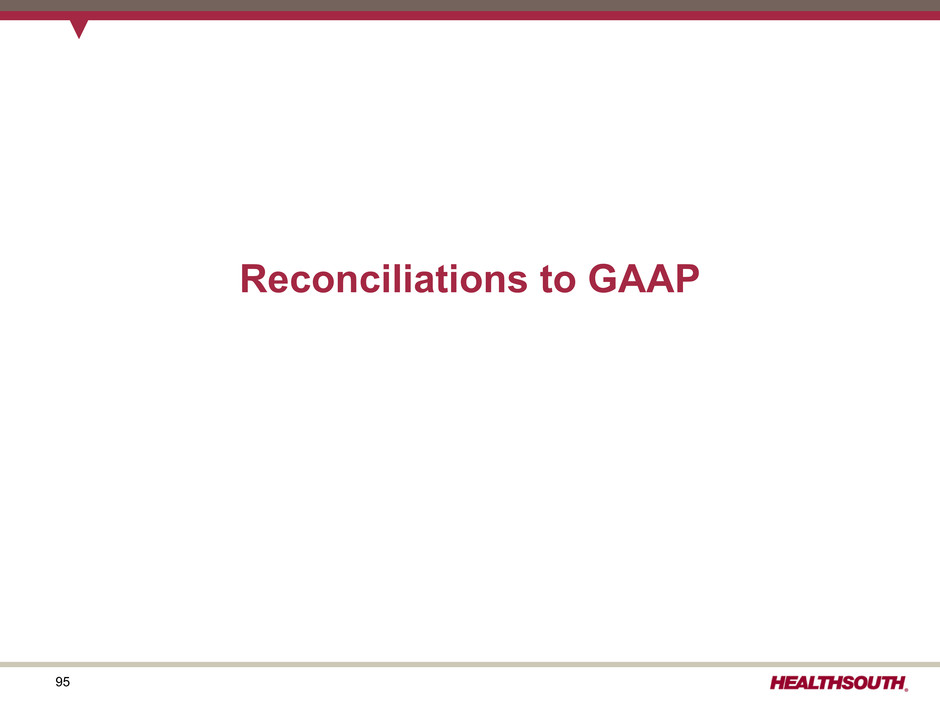
95 Reconciliations to GAAP
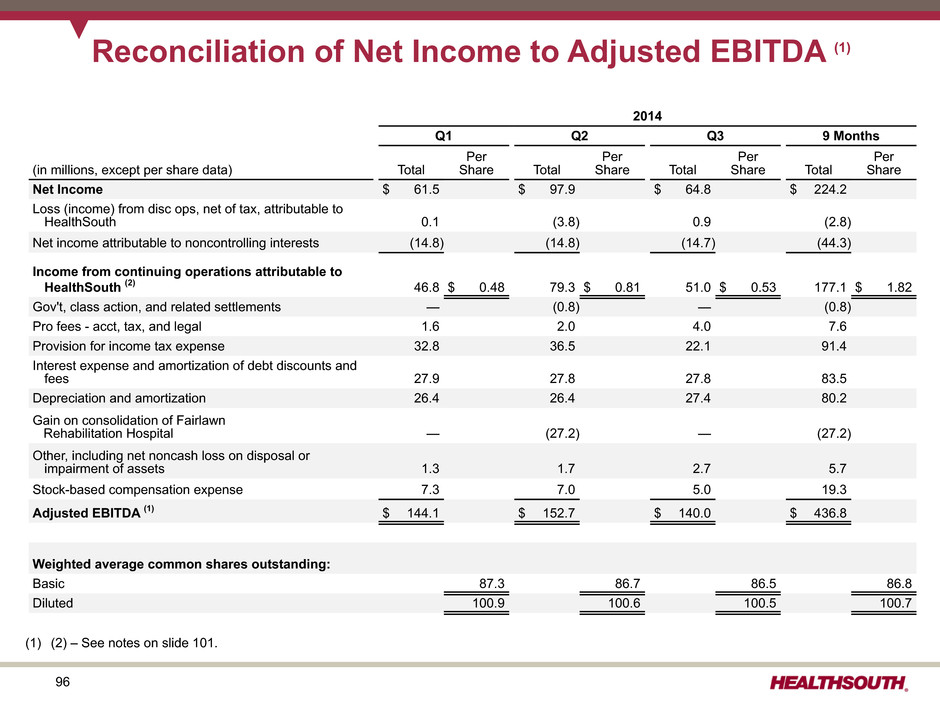
96 Reconciliation of Net Income to Adjusted EBITDA (1) 2014 Q1 Q2 Q3 9 Months (in millions, except per share data) Total Per Share Total Per Share Total Per Share Total Per Share Net Income $ 61.5 $ 97.9 $ 64.8 $ 224.2 Loss (income) from disc ops, net of tax, attributable to HealthSouth 0.1 (3.8) 0.9 (2.8) Net income attributable to noncontrolling interests (14.8) (14.8) (14.7) (44.3) Income from continuing operations attributable to HealthSouth (2) 46.8 $ 0.48 79.3 $ 0.81 51.0 $ 0.53 177.1 $ 1.82 Gov't, class action, and related settlements — (0.8) — (0.8) Pro fees - acct, tax, and legal 1.6 2.0 4.0 7.6 Provision for income tax expense 32.8 36.5 22.1 91.4 Interest expense and amortization of debt discounts and fees 27.9 27.8 27.8 83.5 Depreciation and amortization 26.4 26.4 27.4 80.2 Gain on consolidation of Fairlawn Rehabilitation Hospital — (27.2) — (27.2) Other, including net noncash loss on disposal or impairment of assets 1.3 1.7 2.7 5.7 Stock-based compensation expense 7.3 7.0 5.0 19.3 Adjusted EBITDA (1) $ 144.1 $ 152.7 $ 140.0 $ 436.8 Weighted average common shares outstanding: Basic 87.3 86.7 86.5 86.8 Diluted 100.9 100.6 100.5 100.7 (1) (2) – See notes on slide 101.
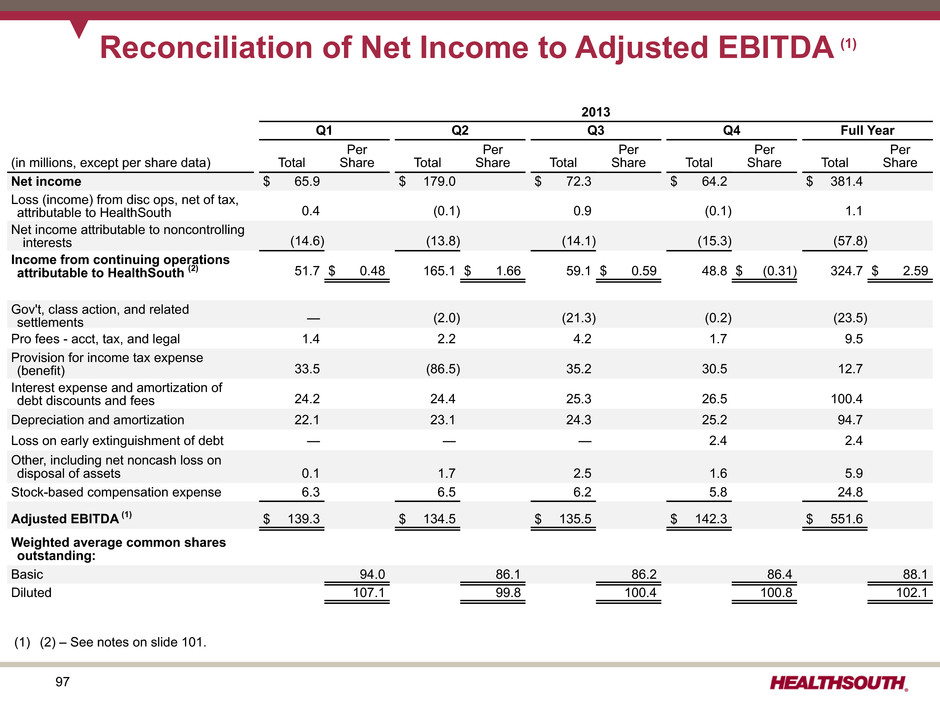
97 Reconciliation of Net Income to Adjusted EBITDA (1) 2013 Q1 Q2 Q3 Q4 Full Year (in millions, except per share data) Total Per Share Total Per Share Total Per Share Total Per Share Total Per Share Net income $ 65.9 $ 179.0 $ 72.3 $ 64.2 $ 381.4 Loss (income) from disc ops, net of tax, attributable to HealthSouth 0.4 (0.1) 0.9 (0.1) 1.1 Net income attributable to noncontrolling interests (14.6) (13.8) (14.1) (15.3) (57.8) Income from continuing operations attributable to HealthSouth (2) 51.7 $ 0.48 165.1 $ 1.66 59.1 $ 0.59 48.8 $ (0.31) 324.7 $ 2.59 Gov't, class action, and related settlements — (2.0) (21.3) (0.2) (23.5) Pro fees - acct, tax, and legal 1.4 2.2 4.2 1.7 9.5 Provision for income tax expense (benefit) 33.5 (86.5) 35.2 30.5 12.7 Interest expense and amortization of debt discounts and fees 24.2 24.4 25.3 26.5 100.4 Depreciation and amortization 22.1 23.1 24.3 25.2 94.7 Loss on early extinguishment of debt — — — 2.4 2.4 Other, including net noncash loss on disposal of assets 0.1 1.7 2.5 1.6 5.9 Stock-based compensation expense 6.3 6.5 6.2 5.8 24.8 Adjusted EBITDA (1) $ 139.3 $ 134.5 $ 135.5 $ 142.3 $ 551.6 Weighted average common shares outstanding: Basic 94.0 86.1 86.2 86.4 88.1 Diluted 107.1 99.8 100.4 100.8 102.1 (1) (2) – See notes on slide 101.
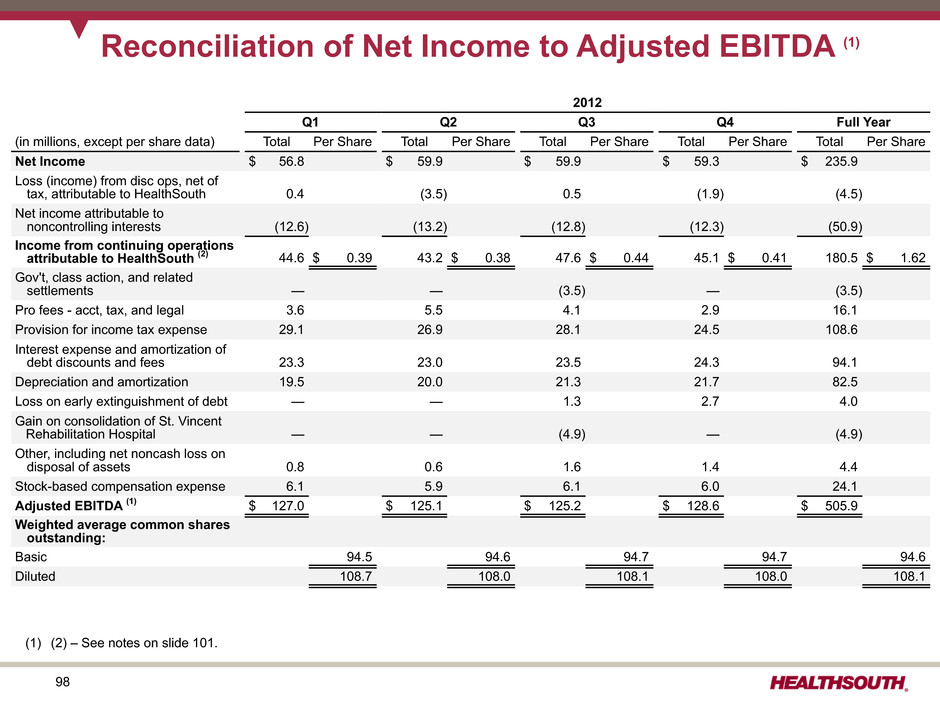
98 Reconciliation of Net Income to Adjusted EBITDA (1) 2012 Q1 Q2 Q3 Q4 Full Year (in millions, except per share data) Total Per Share Total Per Share Total Per Share Total Per Share Total Per Share Net Income $ 56.8 $ 59.9 $ 59.9 $ 59.3 $ 235.9 Loss (income) from disc ops, net of tax, attributable to HealthSouth 0.4 (3.5) 0.5 (1.9) (4.5) Net income attributable to noncontrolling interests (12.6) (13.2) (12.8) (12.3) (50.9) Income from continuing operations attributable to HealthSouth (2) 44.6 $ 0.39 43.2 $ 0.38 47.6 $ 0.44 45.1 $ 0.41 180.5 $ 1.62 Gov't, class action, and related settlements — — (3.5) — (3.5) Pro fees - acct, tax, and legal 3.6 5.5 4.1 2.9 16.1 Provision for income tax expense 29.1 26.9 28.1 24.5 108.6 Interest expense and amortization of debt discounts and fees 23.3 23.0 23.5 24.3 94.1 Depreciation and amortization 19.5 20.0 21.3 21.7 82.5 Loss on early extinguishment of debt — — 1.3 2.7 4.0 Gain on consolidation of St. Vincent Rehabilitation Hospital — — (4.9) — (4.9) Other, including net noncash loss on disposal of assets 0.8 0.6 1.6 1.4 4.4 Stock-based compensation expense 6.1 5.9 6.1 6.0 24.1 Adjusted EBITDA (1) $ 127.0 $ 125.1 $ 125.2 $ 128.6 $ 505.9 Weighted average common shares outstanding: Basic 94.5 94.6 94.7 94.7 94.6 Diluted 108.7 108.0 108.1 108.0 108.1 (1) (2) – See notes on slide 101.
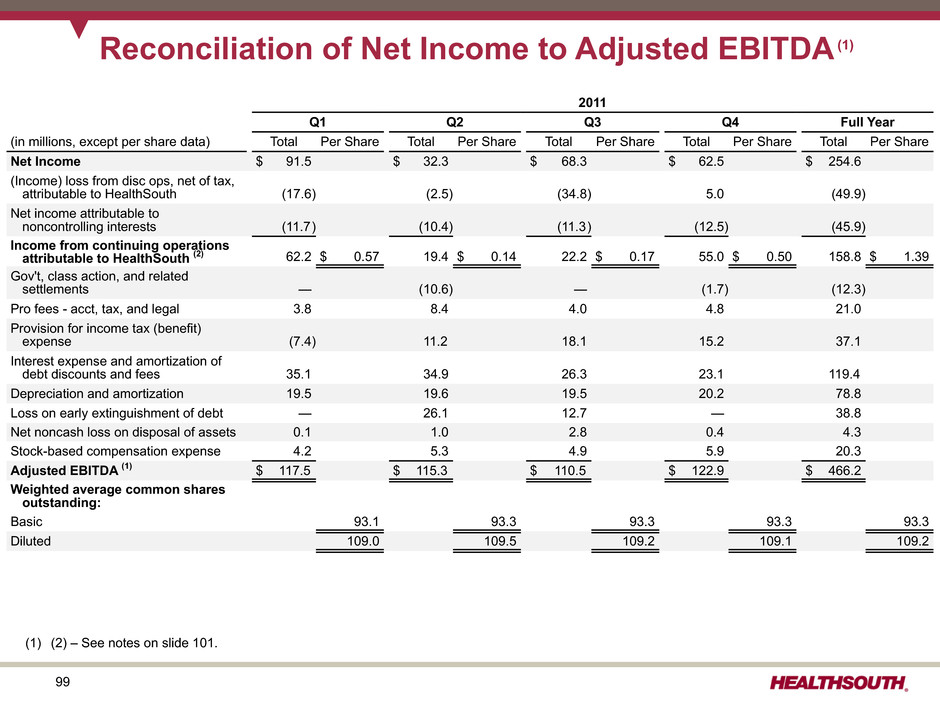
99 Reconciliation of Net Income to Adjusted EBITDA (1) 2011 Q1 Q2 Q3 Q4 Full Year (in millions, except per share data) Total Per Share Total Per Share Total Per Share Total Per Share Total Per Share Net Income $ 91.5 $ 32.3 $ 68.3 $ 62.5 $ 254.6 (Income) loss from disc ops, net of tax, attributable to HealthSouth (17.6) (2.5) (34.8) 5.0 (49.9) Net income attributable to noncontrolling interests (11.7) (10.4) (11.3) (12.5) (45.9) Income from continuing operations attributable to HealthSouth (2) 62.2 $ 0.57 19.4 $ 0.14 22.2 $ 0.17 55.0 $ 0.50 158.8 $ 1.39 Gov't, class action, and related settlements — (10.6) — (1.7) (12.3) Pro fees - acct, tax, and legal 3.8 8.4 4.0 4.8 21.0 Provision for income tax (benefit) expense (7.4) 11.2 18.1 15.2 37.1 Interest expense and amortization of debt discounts and fees 35.1 34.9 26.3 23.1 119.4 Depreciation and amortization 19.5 19.6 19.5 20.2 78.8 Loss on early extinguishment of debt — 26.1 12.7 — 38.8 Net noncash loss on disposal of assets 0.1 1.0 2.8 0.4 4.3 Stock-based compensation expense 4.2 5.3 4.9 5.9 20.3 Adjusted EBITDA (1) $ 117.5 $ 115.3 $ 110.5 $ 122.9 $ 466.2 Weighted average common shares outstanding: Basic 93.1 93.3 93.3 93.3 93.3 Diluted 109.0 109.5 109.2 109.1 109.2 (1) (2) – See notes on slide 101.
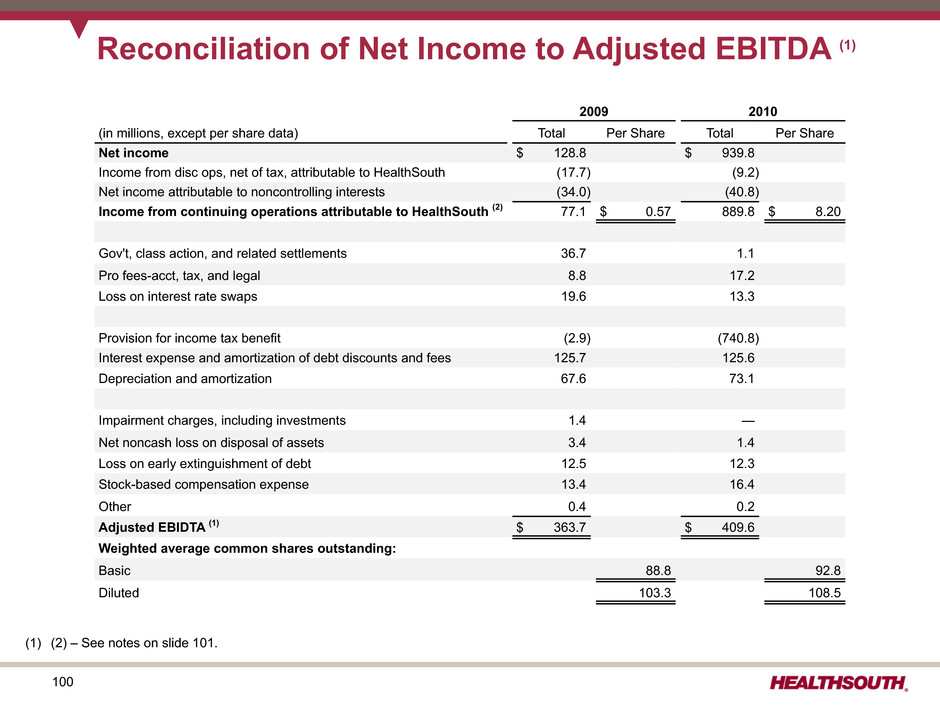
100 Reconciliation of Net Income to Adjusted EBITDA (1) 2009 2010 (in millions, except per share data) Total Per Share Total Per Share Net income $ 128.8 $ 939.8 Income from disc ops, net of tax, attributable to HealthSouth (17.7) (9.2) Net income attributable to noncontrolling interests (34.0) (40.8) Income from continuing operations attributable to HealthSouth (2) 77.1 $ 0.57 889.8 $ 8.20 Gov't, class action, and related settlements 36.7 1.1 Pro fees-acct, tax, and legal 8.8 17.2 Loss on interest rate swaps 19.6 13.3 Provision for income tax benefit (2.9) (740.8) Interest expense and amortization of debt discounts and fees 125.7 125.6 Depreciation and amortization 67.6 73.1 Impairment charges, including investments 1.4 — Net noncash loss on disposal of assets 3.4 1.4 Loss on early extinguishment of debt 12.5 12.3 Stock-based compensation expense 13.4 16.4 Other 0.4 0.2 Adjusted EBIDTA (1) $ 363.7 $ 409.6 Weighted average common shares outstanding: Basic 88.8 92.8 Diluted 103.3 108.5 (1) (2) – See notes on slide 101.
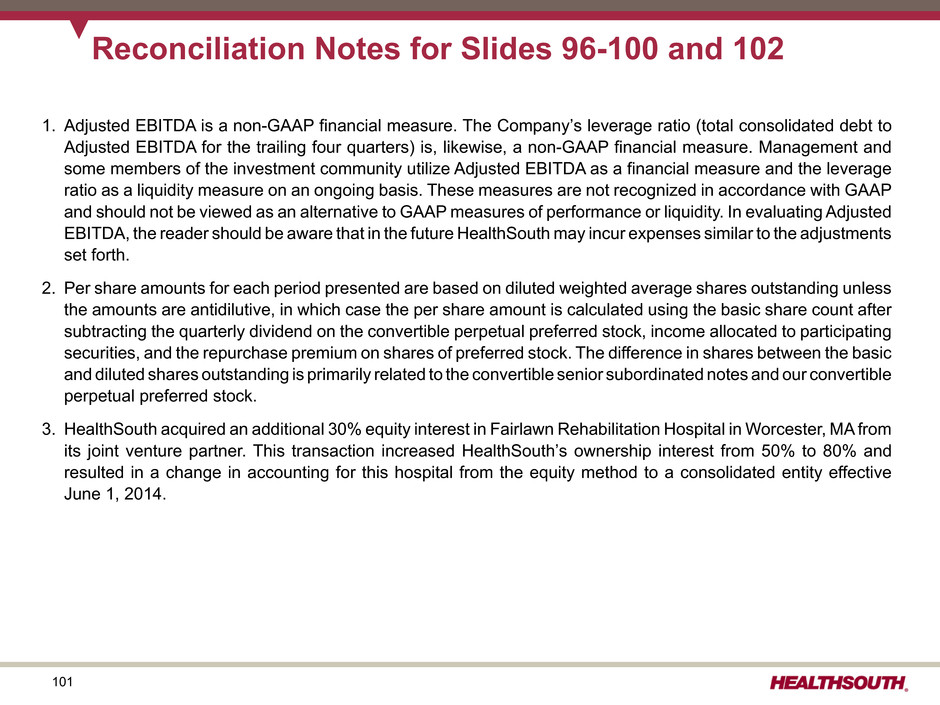
101 Reconciliation Notes for Slides 96-100 and 102 1. Adjusted EBITDA is a non-GAAP financial measure. The Company’s leverage ratio (total consolidated debt to Adjusted EBITDA for the trailing four quarters) is, likewise, a non-GAAP financial measure. Management and some members of the investment community utilize Adjusted EBITDA as a financial measure and the leverage ratio as a liquidity measure on an ongoing basis. These measures are not recognized in accordance with GAAP and should not be viewed as an alternative to GAAP measures of performance or liquidity. In evaluating Adjusted EBITDA, the reader should be aware that in the future HealthSouth may incur expenses similar to the adjustments set forth. 2. Per share amounts for each period presented are based on diluted weighted average shares outstanding unless the amounts are antidilutive, in which case the per share amount is calculated using the basic share count after subtracting the quarterly dividend on the convertible perpetual preferred stock, income allocated to participating securities, and the repurchase premium on shares of preferred stock. The difference in shares between the basic and diluted shares outstanding is primarily related to the convertible senior subordinated notes and our convertible perpetual preferred stock. 3. HealthSouth acquired an additional 30% equity interest in Fairlawn Rehabilitation Hospital in Worcester, MA from its joint venture partner. This transaction increased HealthSouth’s ownership interest from 50% to 80% and resulted in a change in accounting for this hospital from the equity method to a consolidated entity effective June 1, 2014.
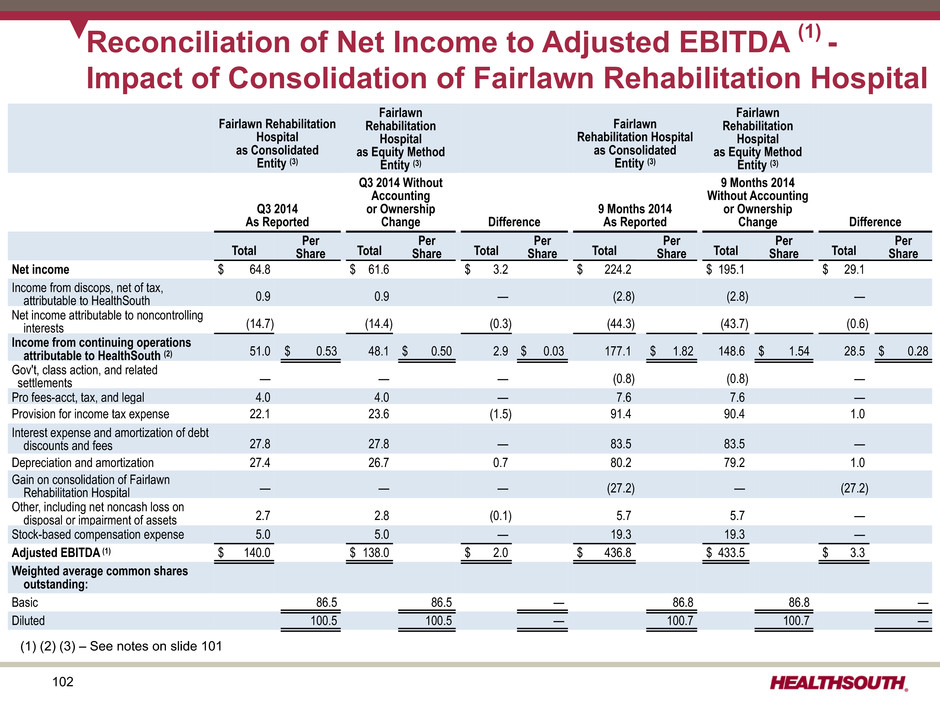
102 Reconciliation of Net Income to Adjusted EBITDA (1) - Impact of Consolidation of Fairlawn Rehabilitation Hospital Fairlawn Rehabilitation Hospital as Consolidated Entity (3) Fairlawn Rehabilitation Hospital as Equity Method Entity (3) Fairlawn Rehabilitation Hospital as Consolidated Entity (3) Fairlawn Rehabilitation Hospital as Equity Method Entity (3) Q3 2014 As Reported Q3 2014 Without Accounting or Ownership Change Difference 9 Months 2014 As Reported 9 Months 2014 Without Accounting or Ownership Change Difference Total Per Share Total Per Share Total Per Share Total Per Share Total Per Share Total Per Share Net income $ 64.8 $ 61.6 $ 3.2 $ 224.2 $ 195.1 $ 29.1 Income from discops, net of tax, attributable to HealthSouth 0.9 0.9 — (2.8) (2.8) — Net income attributable to noncontrolling interests (14.7) (14.4) (0.3) (44.3) (43.7) (0.6) Income from continuing operations attributable to HealthSouth (2) 51.0 $ 0.53 48.1 $ 0.50 2.9 $ 0.03 177.1 $ 1.82 148.6 $ 1.54 28.5 $ 0.28 Gov't, class action, and related settlements — — — (0.8) (0.8) — Pro fees-acct, tax, and legal 4.0 4.0 — 7.6 7.6 — Provision for income tax expense 22.1 23.6 (1.5) 91.4 90.4 1.0 Interest expense and amortization of debt discounts and fees 27.8 27.8 — 83.5 83.5 — Depreciation and amortization 27.4 26.7 0.7 80.2 79.2 1.0 Gain on consolidation of Fairlawn Rehabilitation Hospital — — — (27.2) — (27.2) Other, including net noncash loss on disposal or impairment of assets 2.7 2.8 (0.1) 5.7 5.7 — Stock-based compensation expense 5.0 5.0 — 19.3 19.3 — Adjusted EBITDA (1) $ 140.0 $ 138.0 $ 2.0 $ 436.8 $ 433.5 $ 3.3 Weighted average common shares outstanding: Basic 86.5 86.5 — 86.8 86.8 — Diluted 100.5 100.5 — 100.7 100.7 — (1) (2) (3) – See notes on slide 101
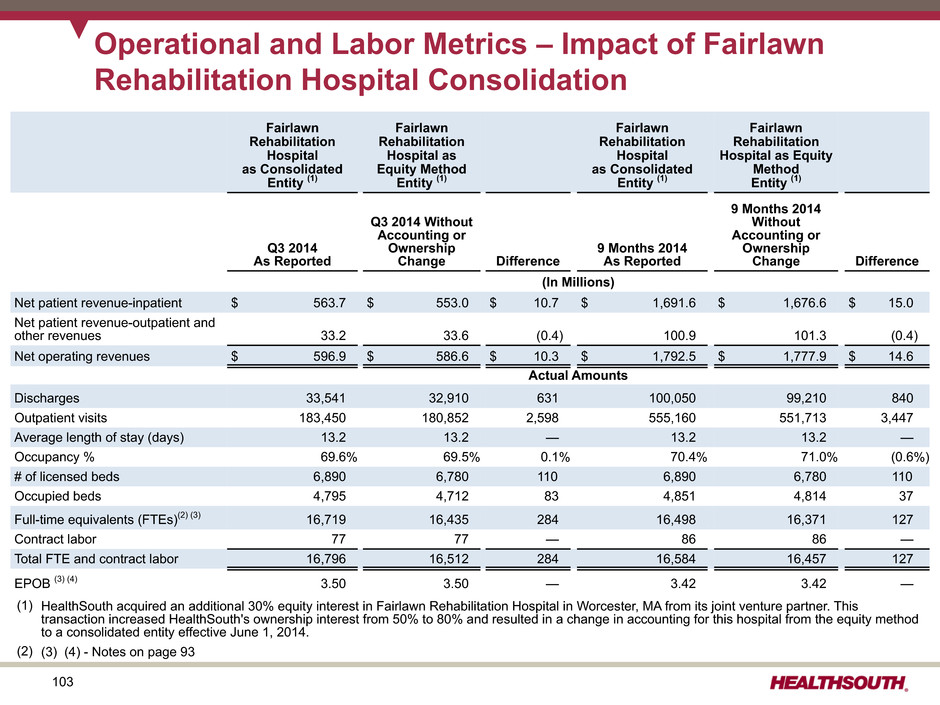
103 Operational and Labor Metrics – Impact of Fairlawn Rehabilitation Hospital Consolidation Fairlawn Rehabilitation Hospital as Consolidated Entity (1) Fairlawn Rehabilitation Hospital as Equity Method Entity (1) Fairlawn Rehabilitation Hospital as Consolidated Entity (1) Fairlawn Rehabilitation Hospital as Equity Method Entity (1) Q3 2014 As Reported Q3 2014 Without Accounting or Ownership Change Difference 9 Months 2014 As Reported 9 Months 2014 Without Accounting or Ownership Change Difference (In Millions) Net patient revenue-inpatient $ 563.7 $ 553.0 $ 10.7 $ 1,691.6 $ 1,676.6 $ 15.0 Net patient revenue-outpatient and other revenues 33.2 33.6 (0.4) 100.9 101.3 (0.4) Net operating revenues $ 596.9 $ 586.6 $ 10.3 $ 1,792.5 $ 1,777.9 $ 14.6 Actual Amounts Discharges 33,541 32,910 631 100,050 99,210 840 Outpatient visits 183,450 180,852 2,598 555,160 551,713 3,447 Average length of stay (days) 13.2 13.2 — 13.2 13.2 — Occupancy % 69.6% 69.5% 0.1% 70.4% 71.0% (0.6%) # of licensed beds 6,890 6,780 110 6,890 6,780 110 Occupied beds 4,795 4,712 83 4,851 4,814 37 Full-time equivalents (FTEs)(2) (3) 16,719 16,435 284 16,498 16,371 127 Contract labor 77 77 — 86 86 — Total FTE and contract labor 16,796 16,512 284 16,584 16,457 127 EPOB (3) (4) 3.50 3.50 — 3.42 3.42 — (1) HealthSouth acquired an additional 30% equity interest in Fairlawn Rehabilitation Hospital in Worcester, MA from its joint venture partner. This transaction increased HealthSouth's ownership interest from 50% to 80% and resulted in a change in accounting for this hospital from the equity method to a consolidated entity effective June 1, 2014. (2) (3) (4) - Notes on page 93